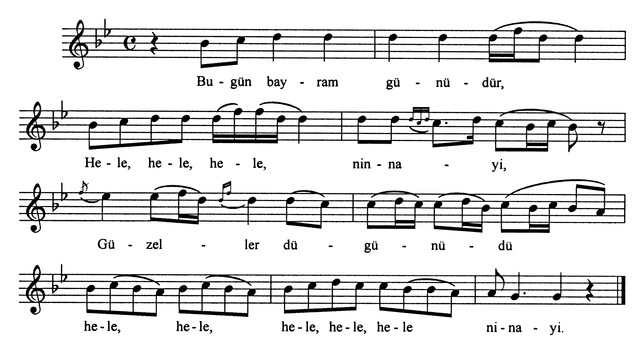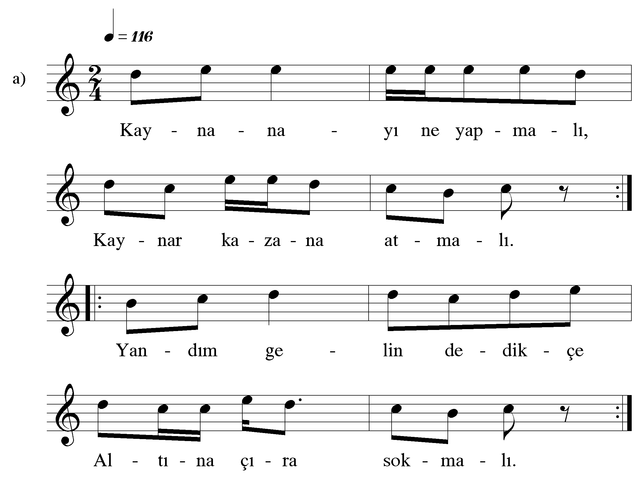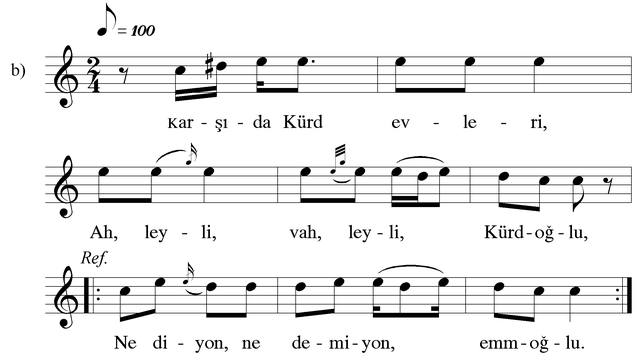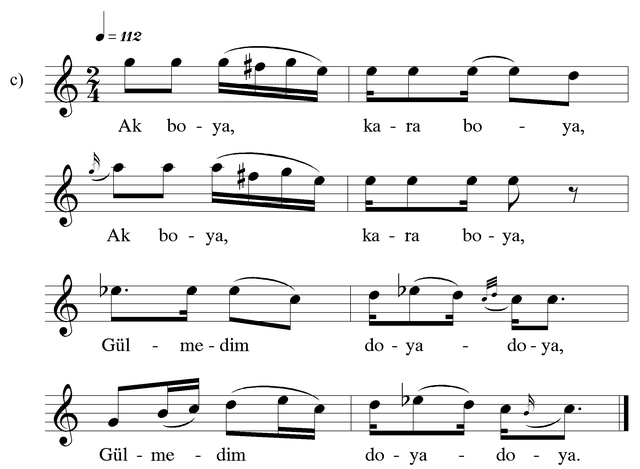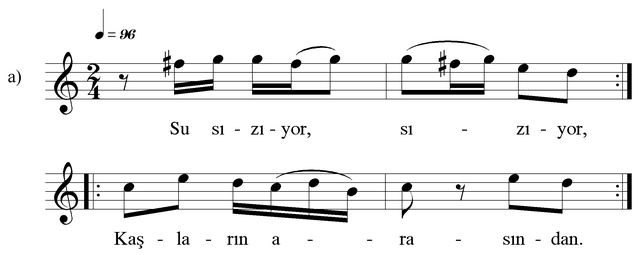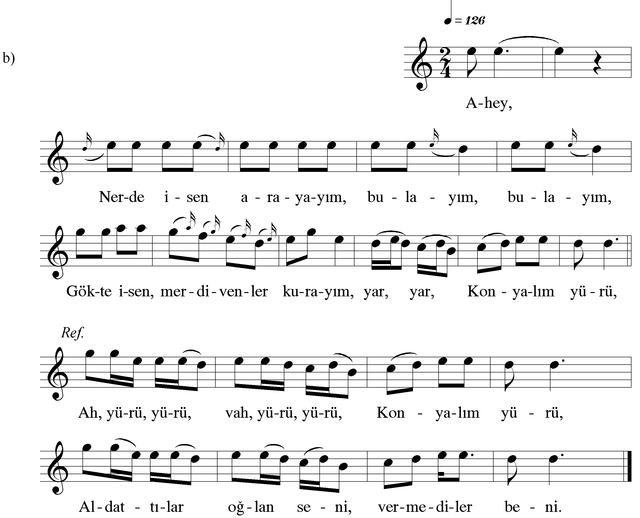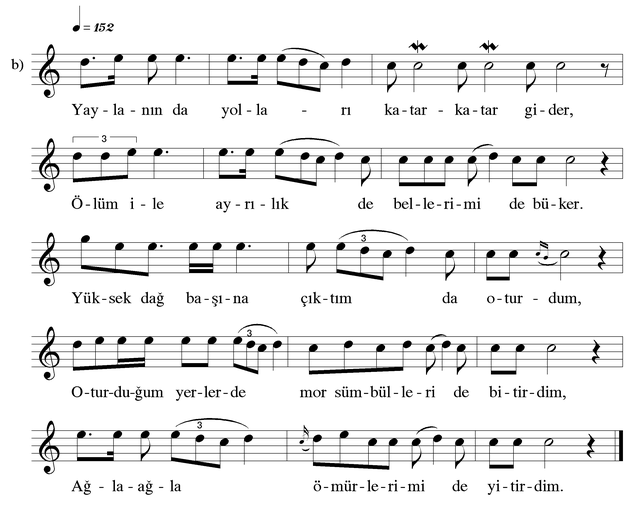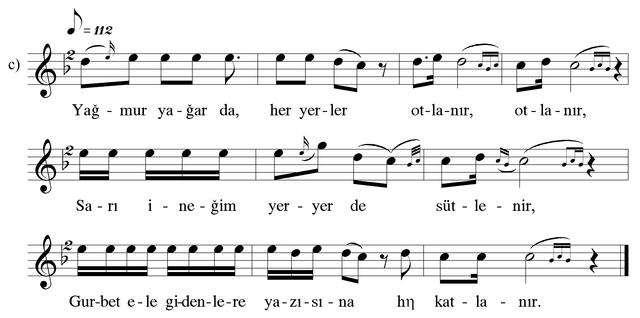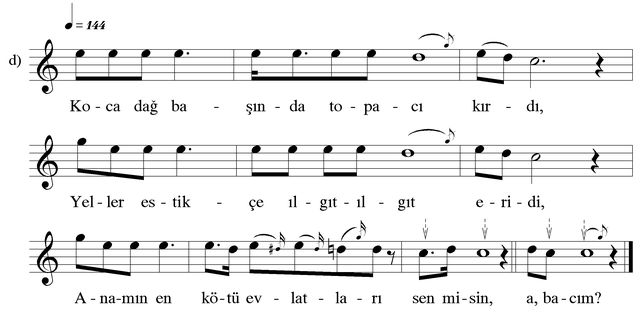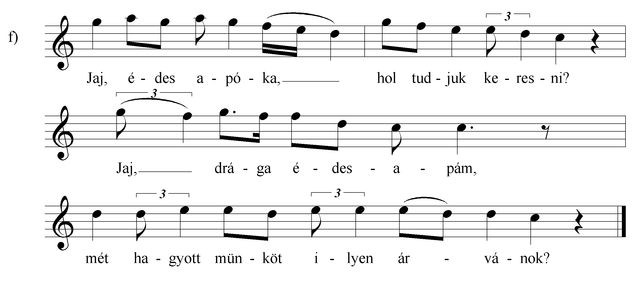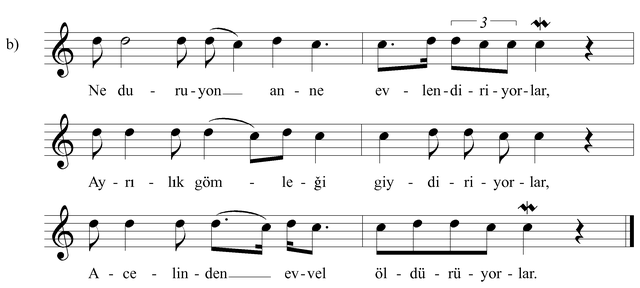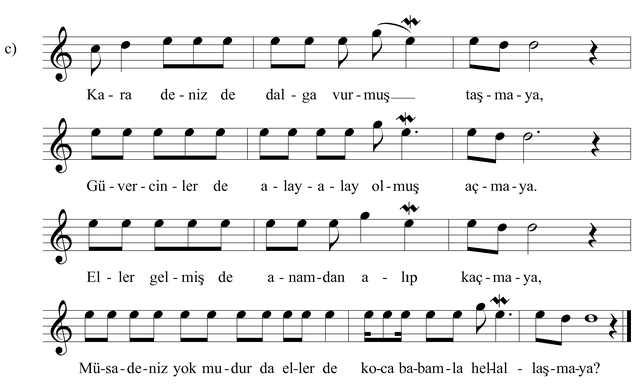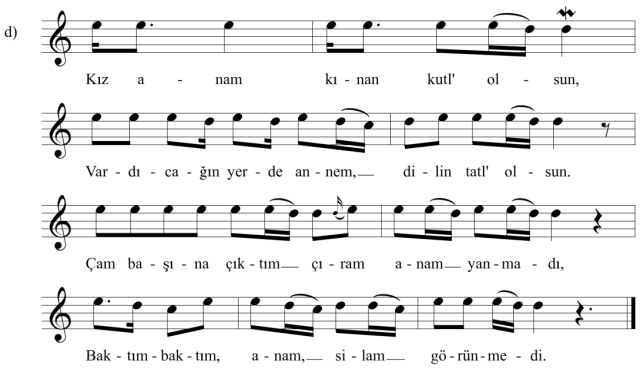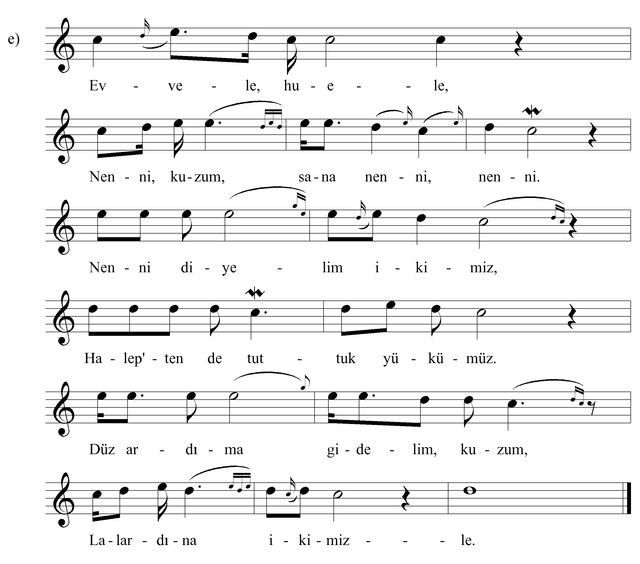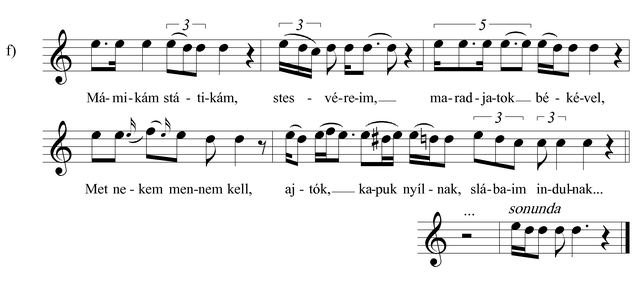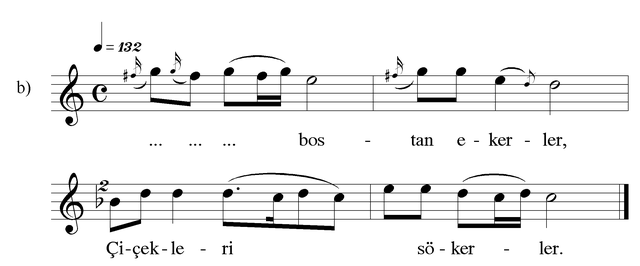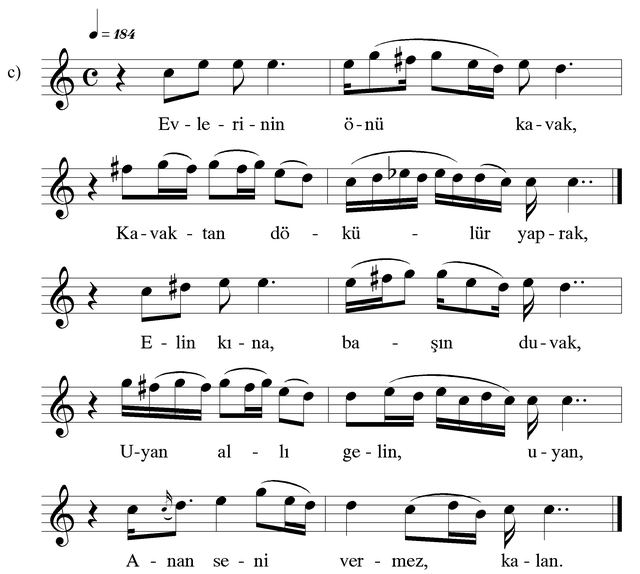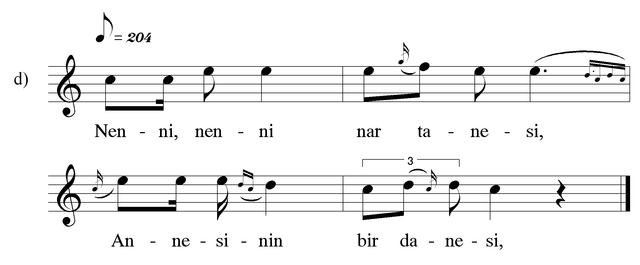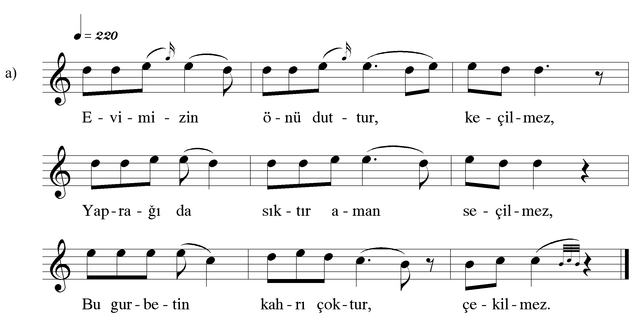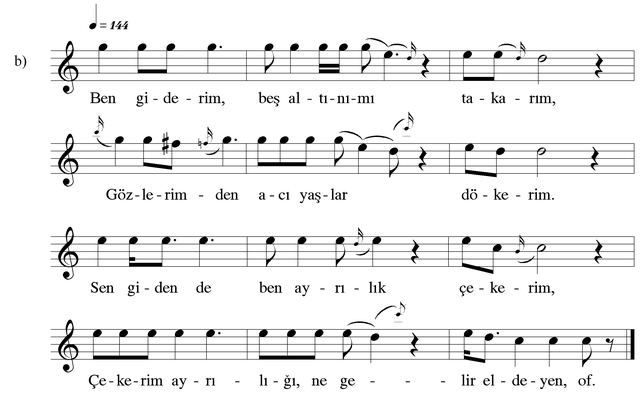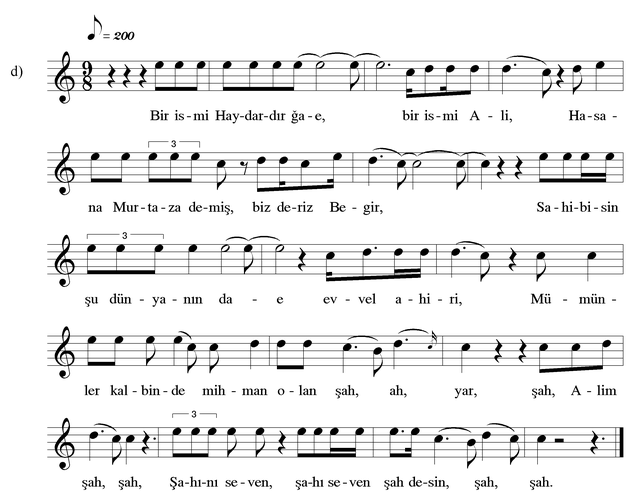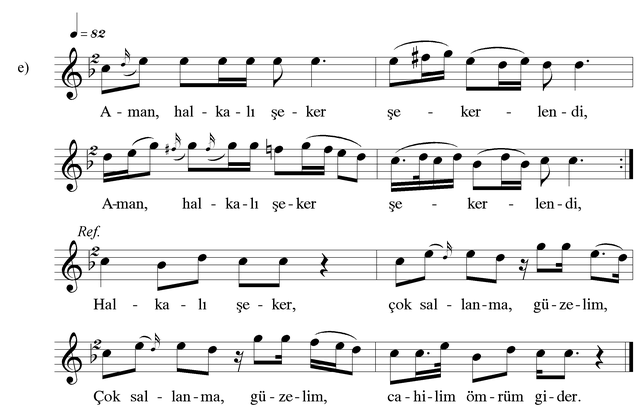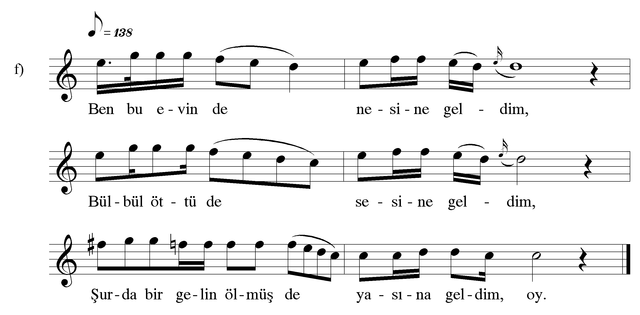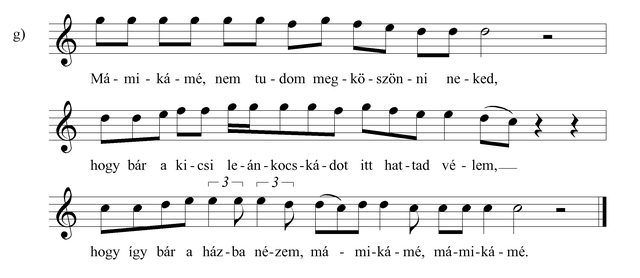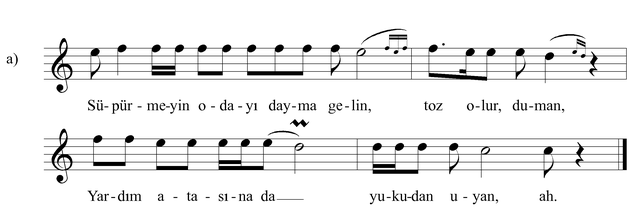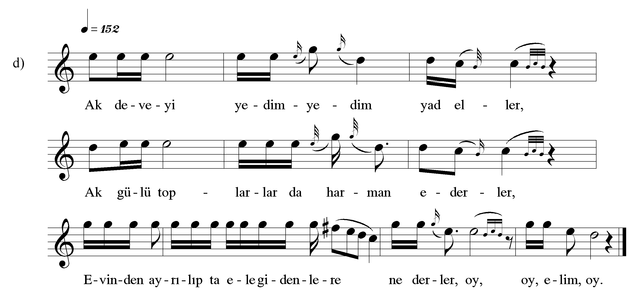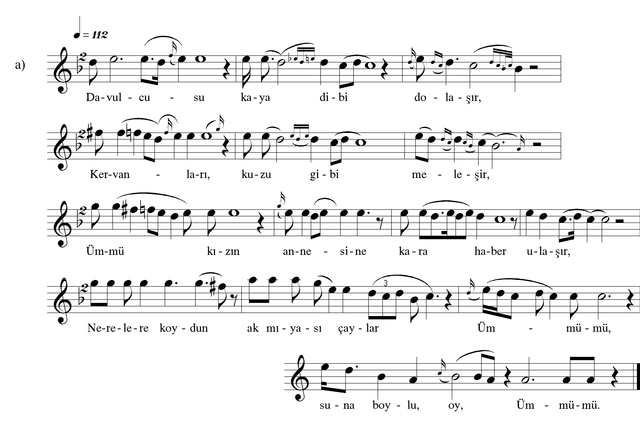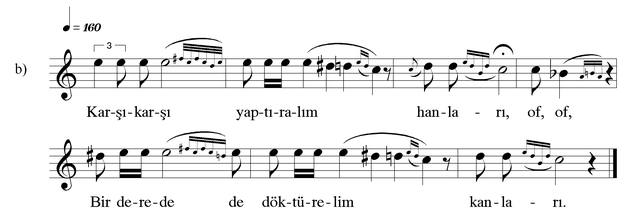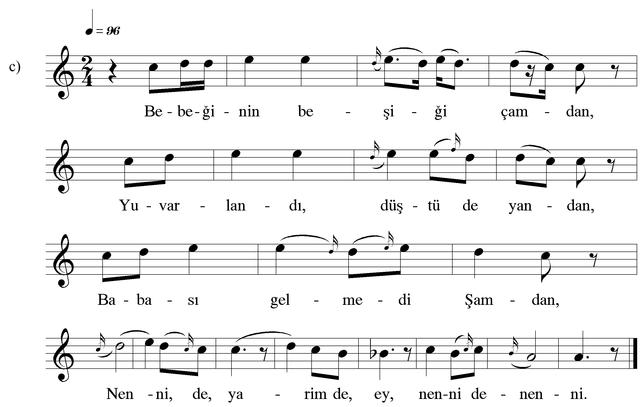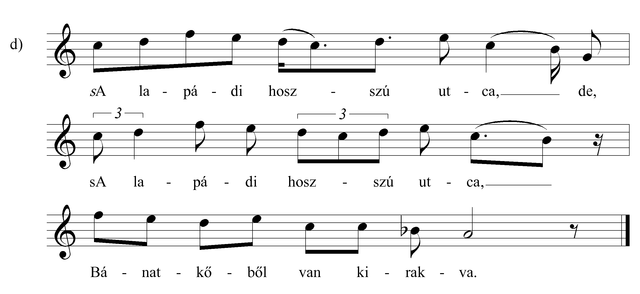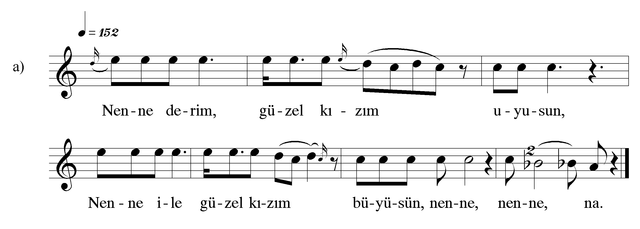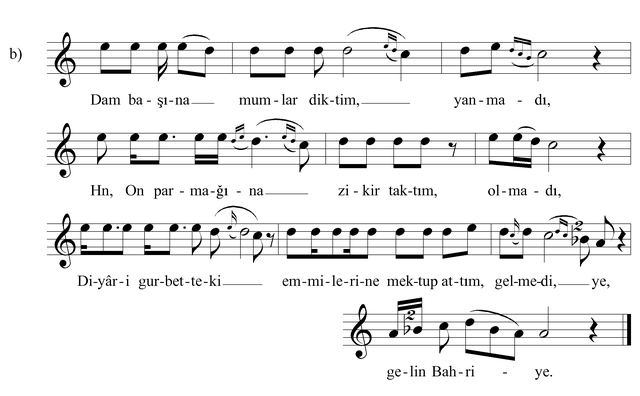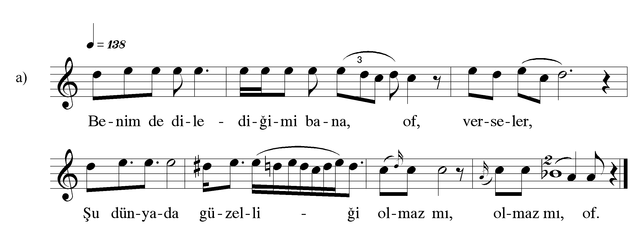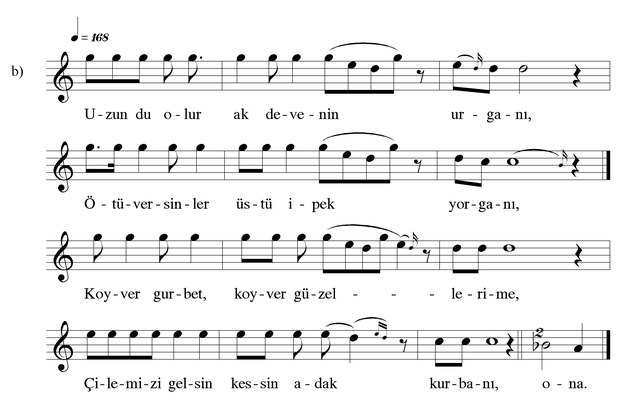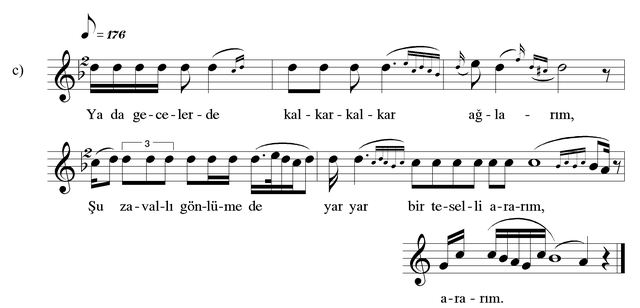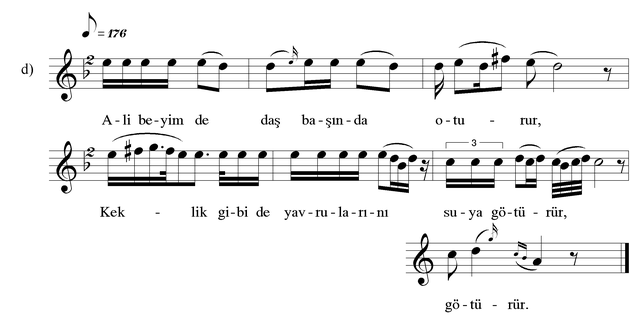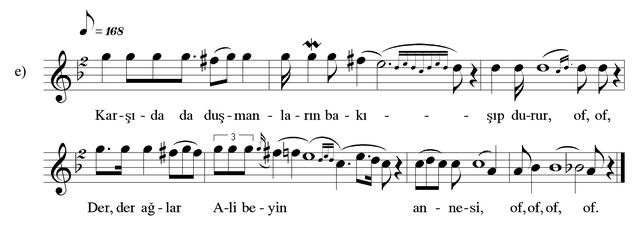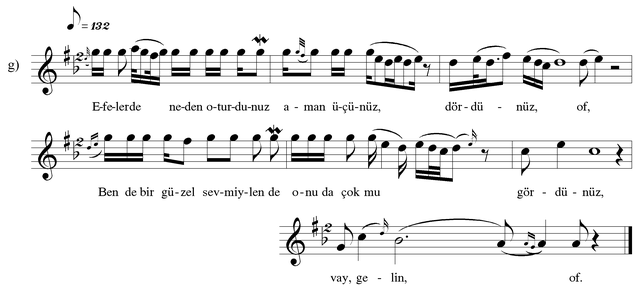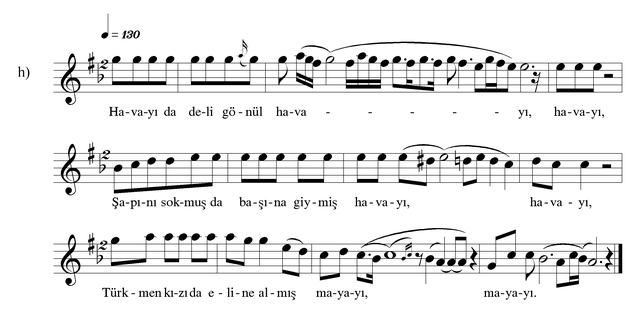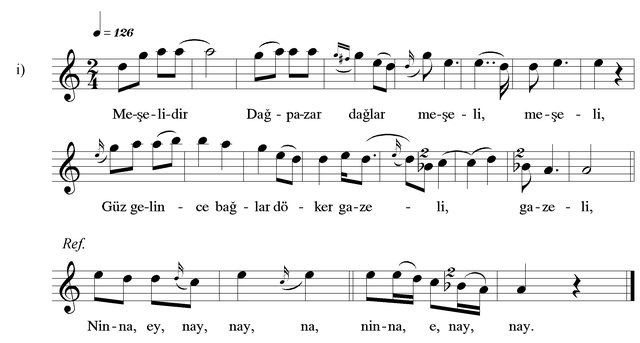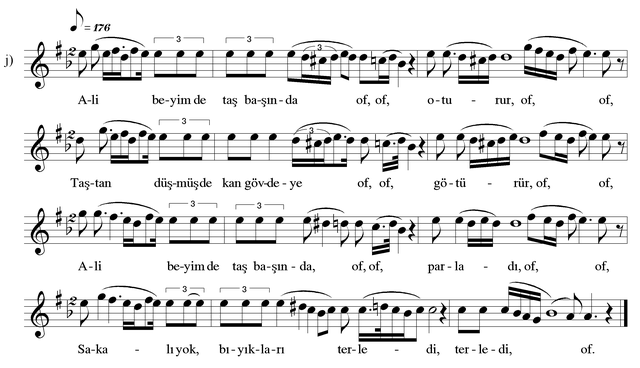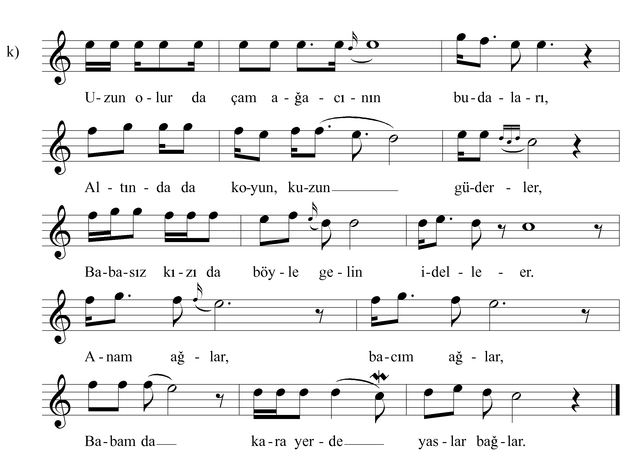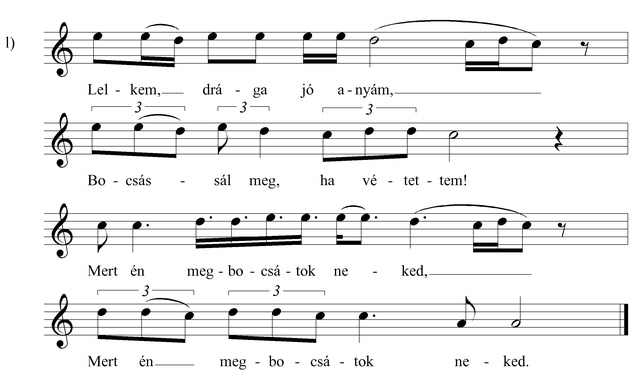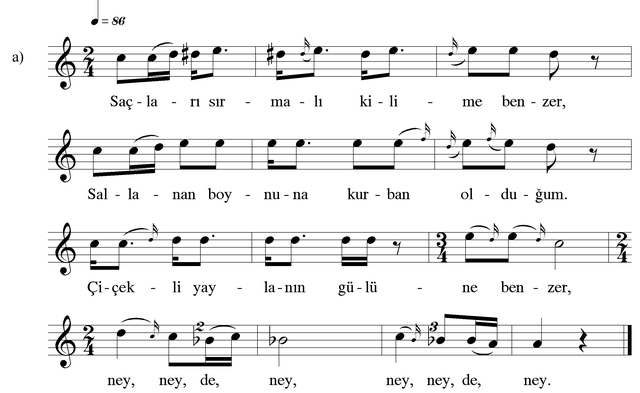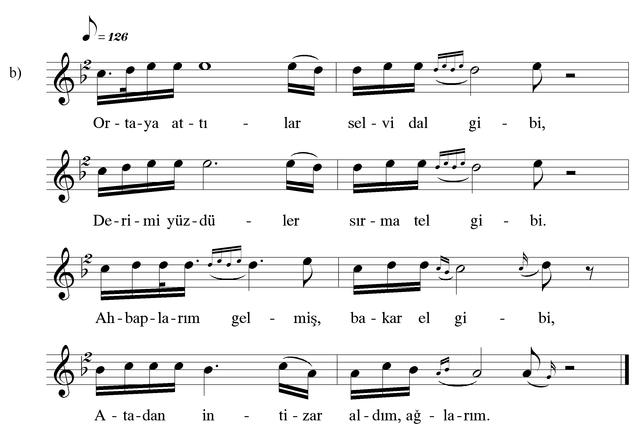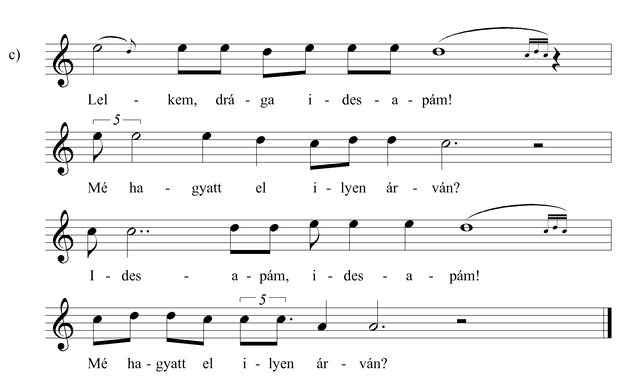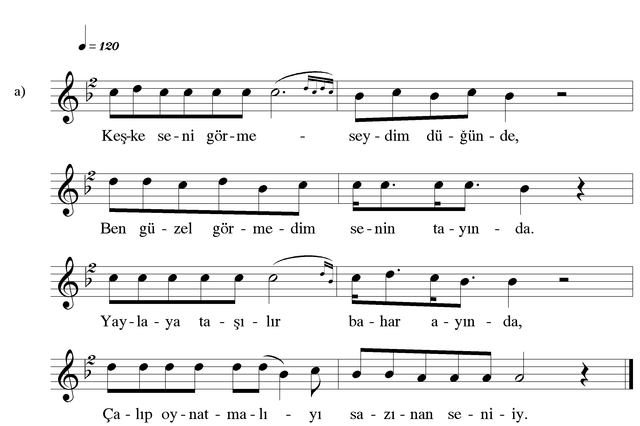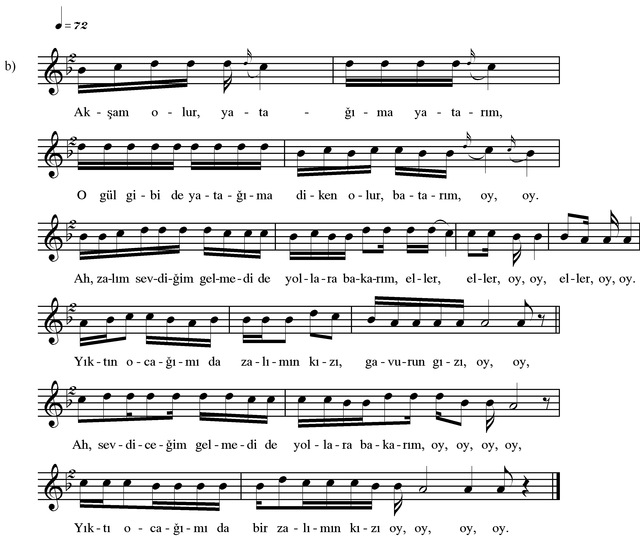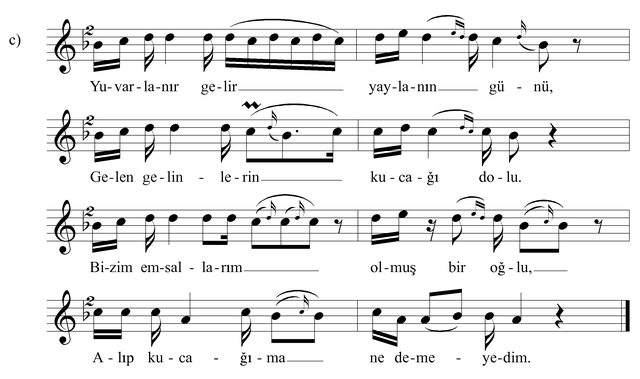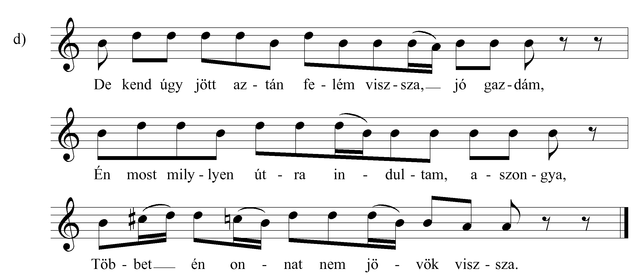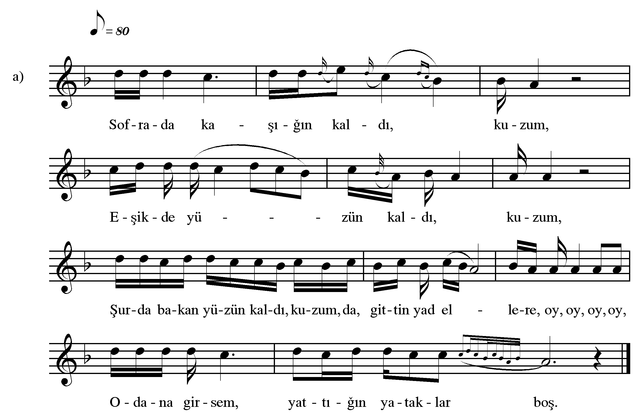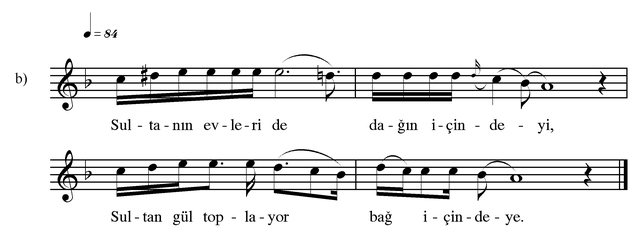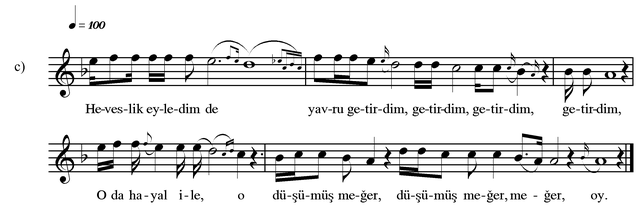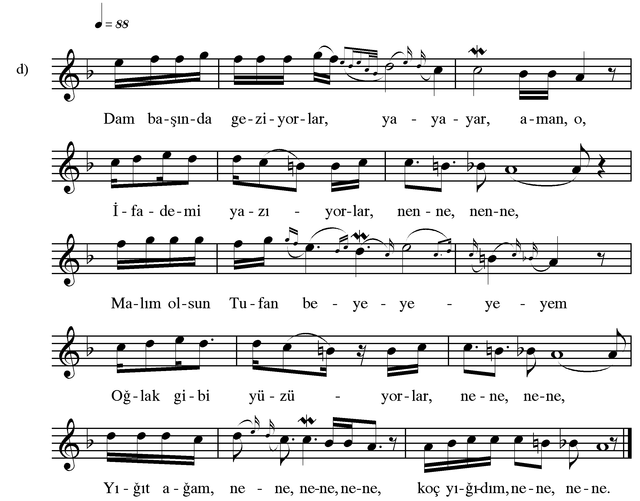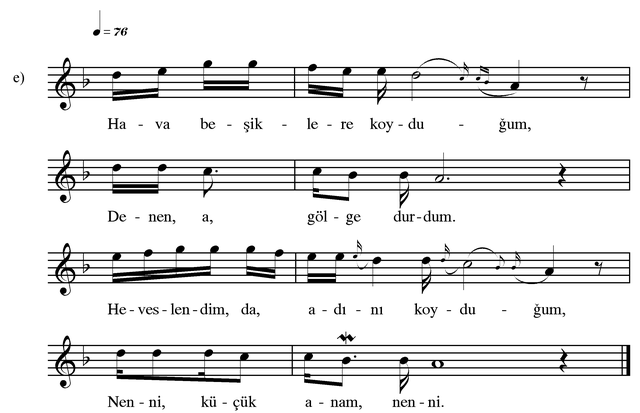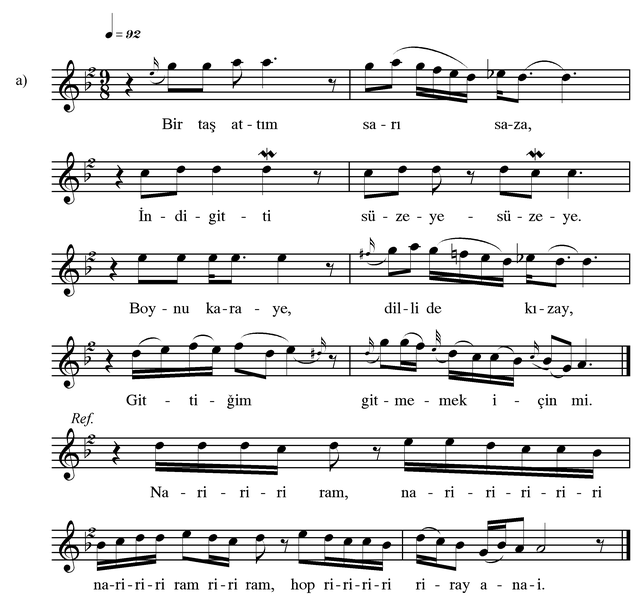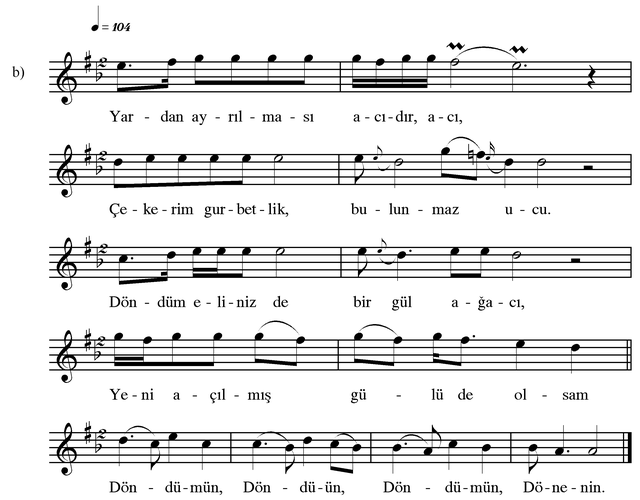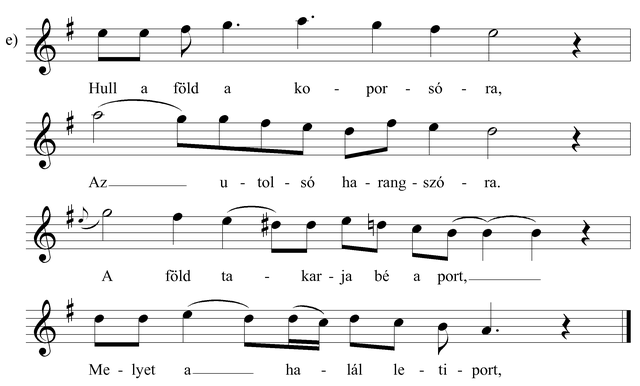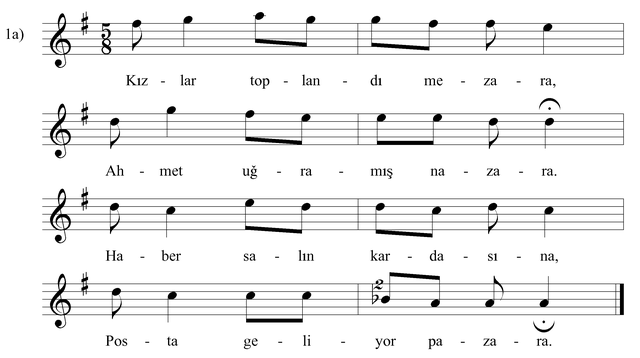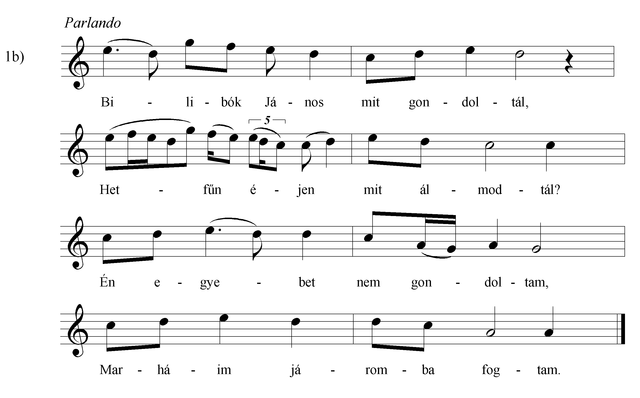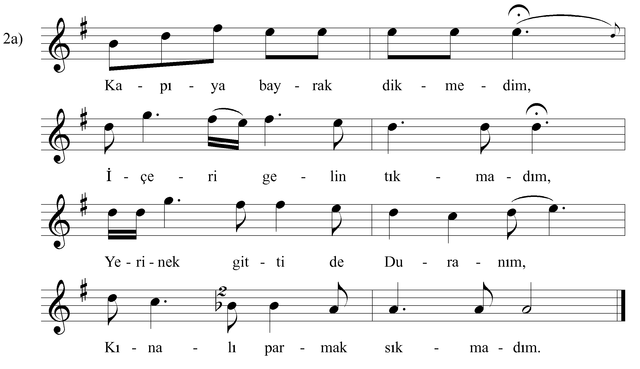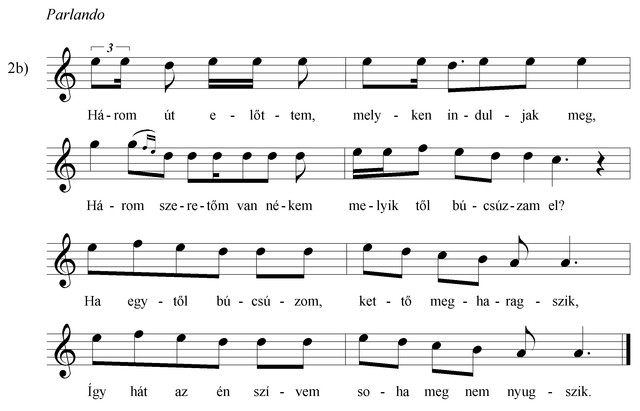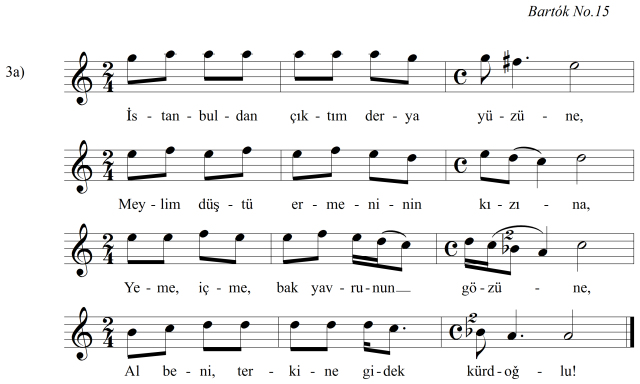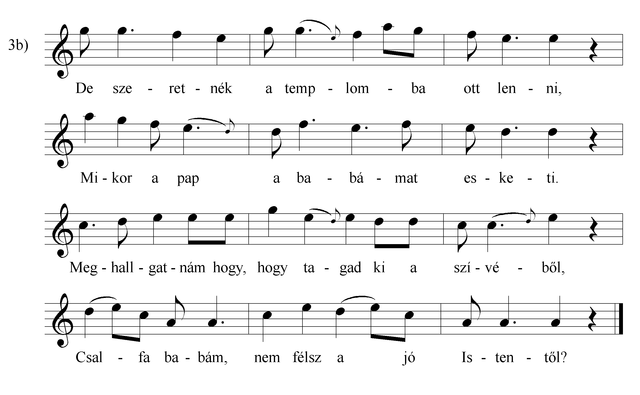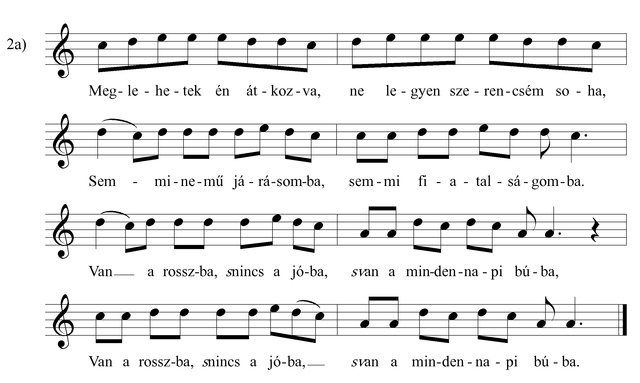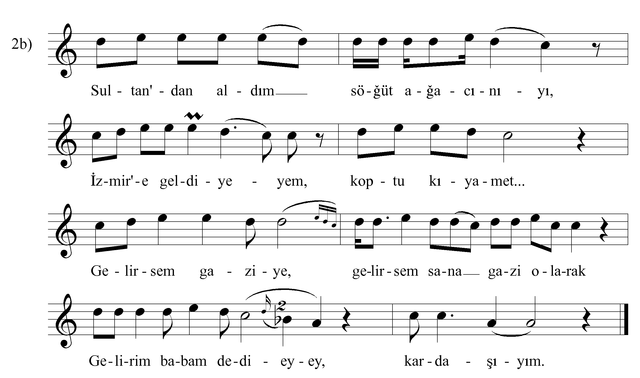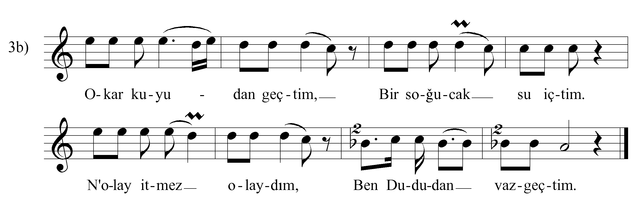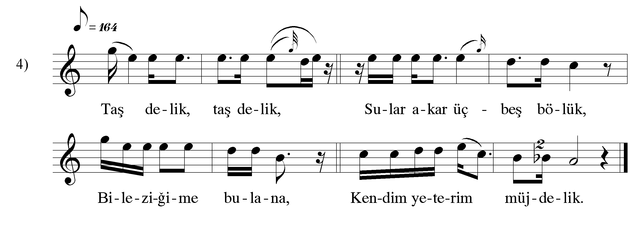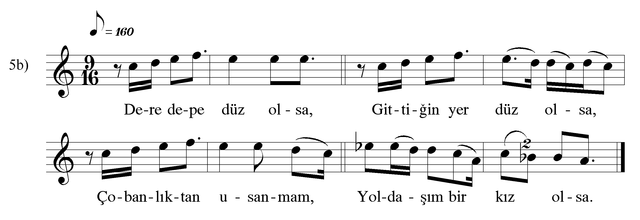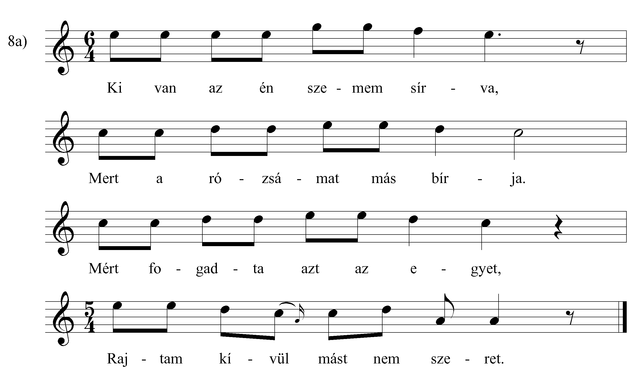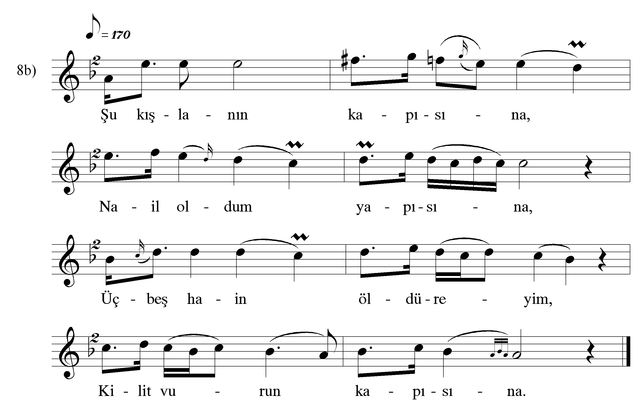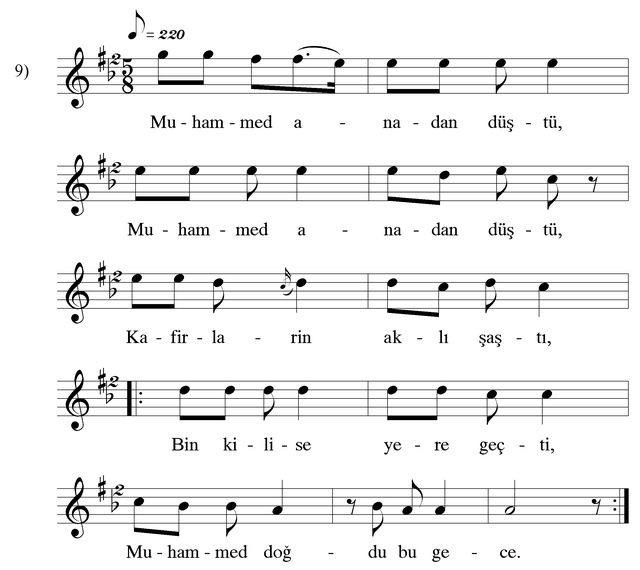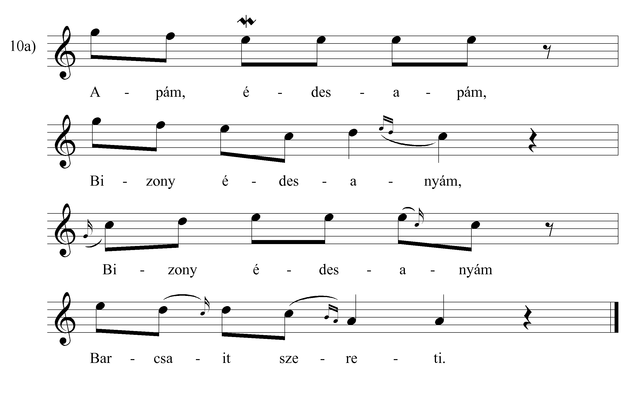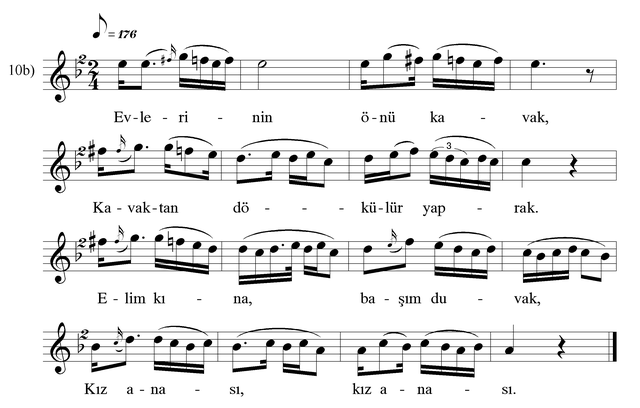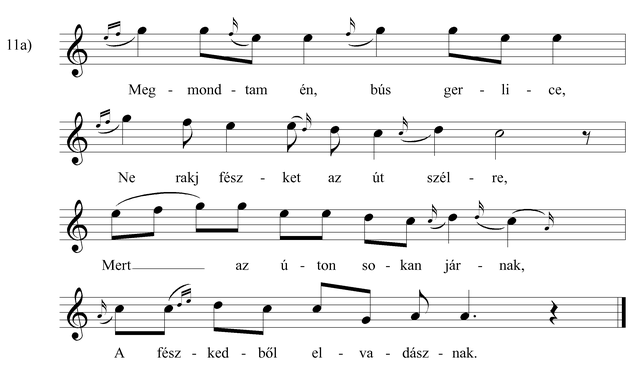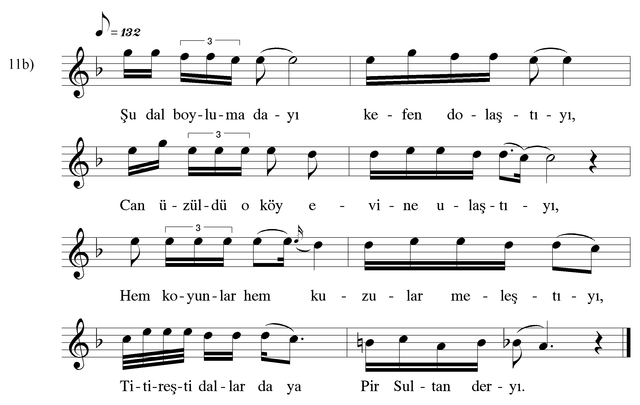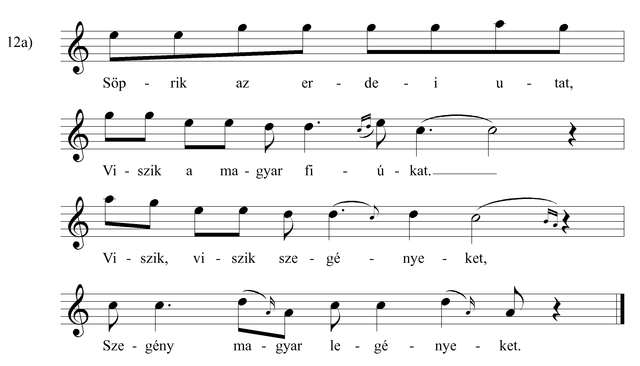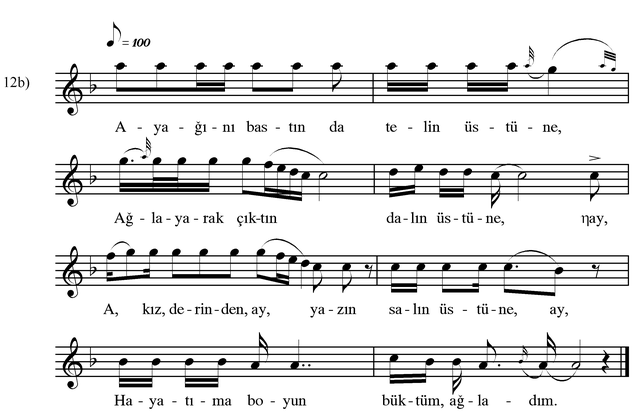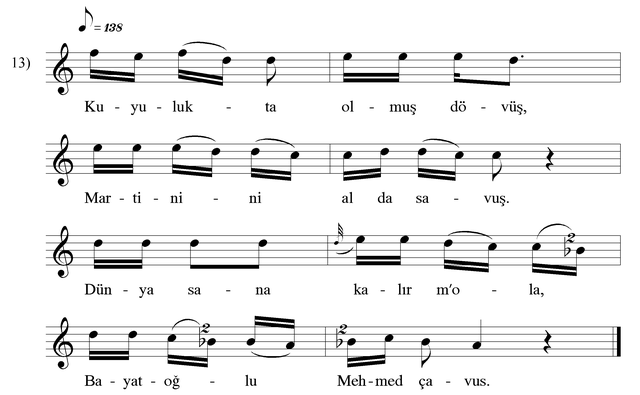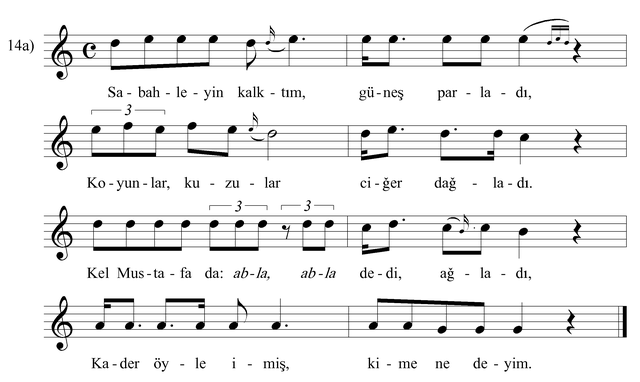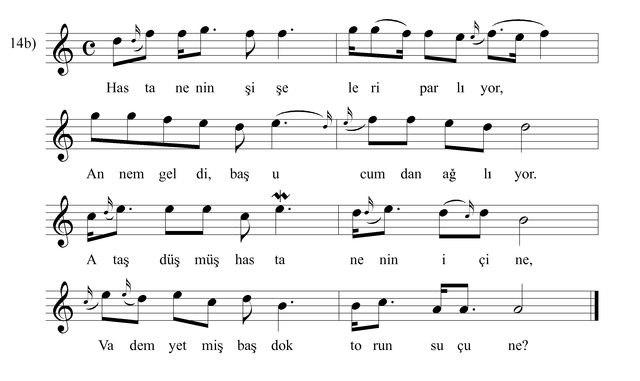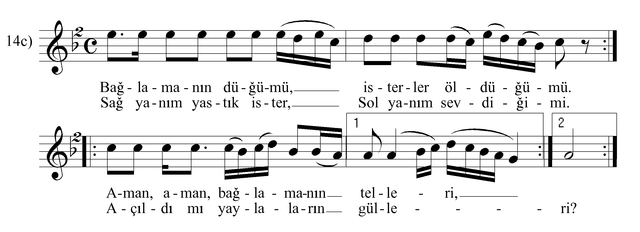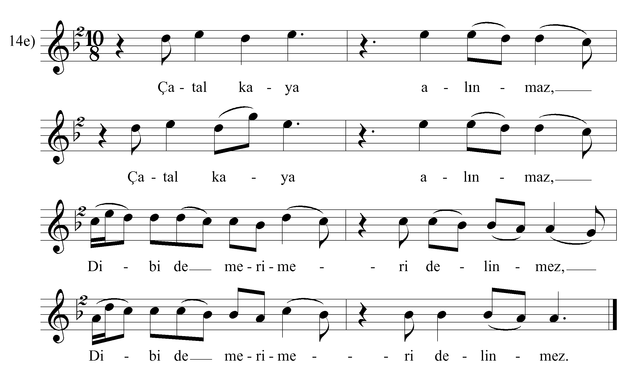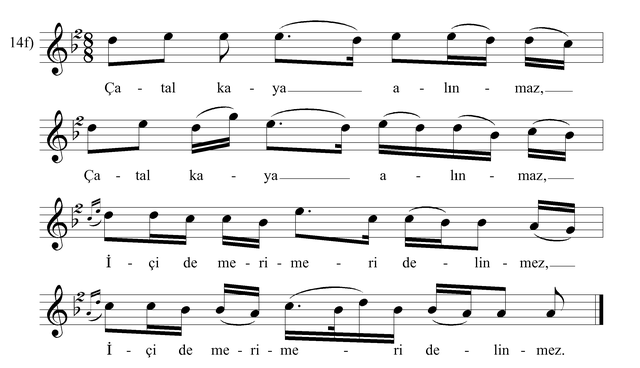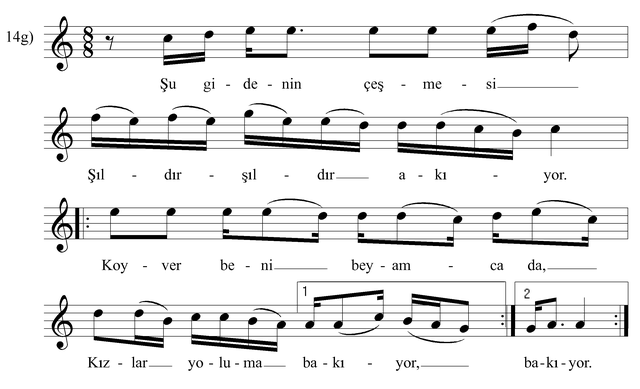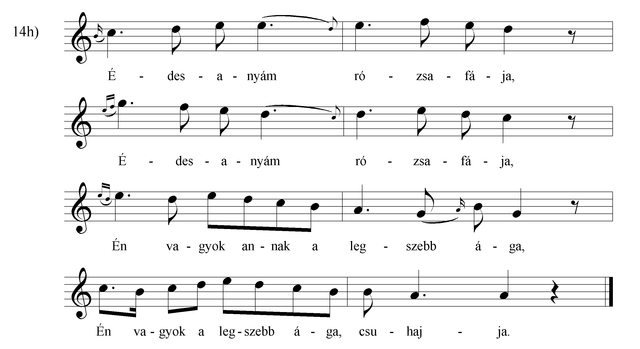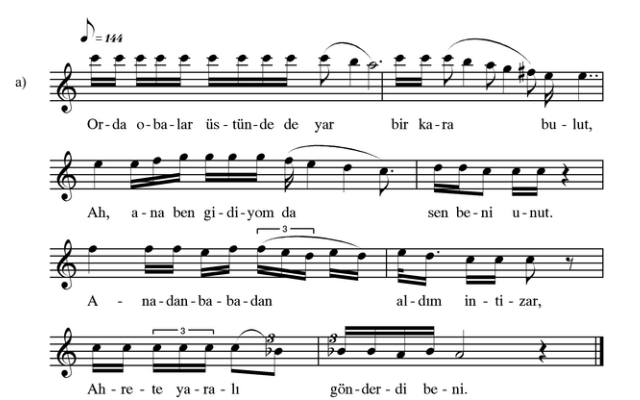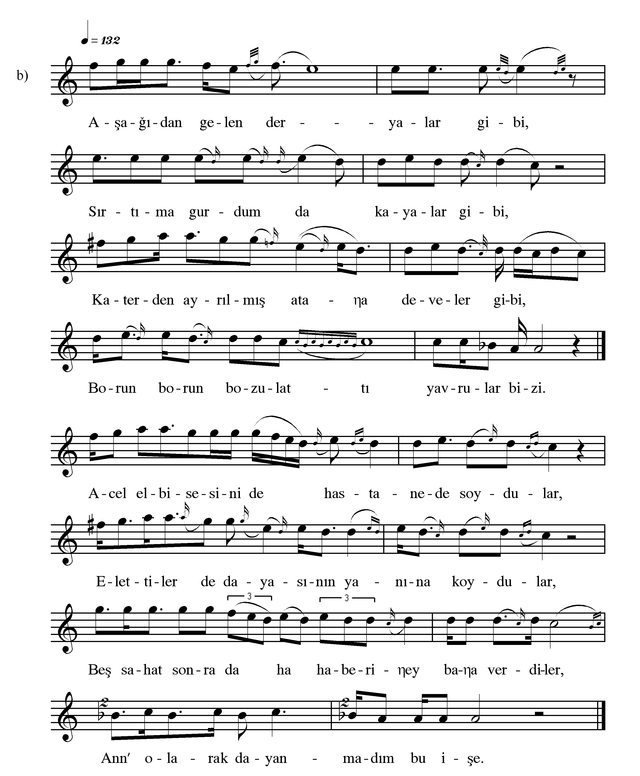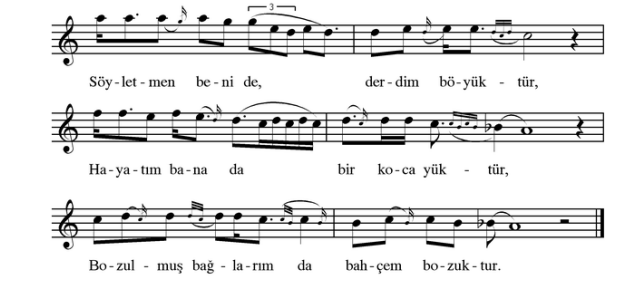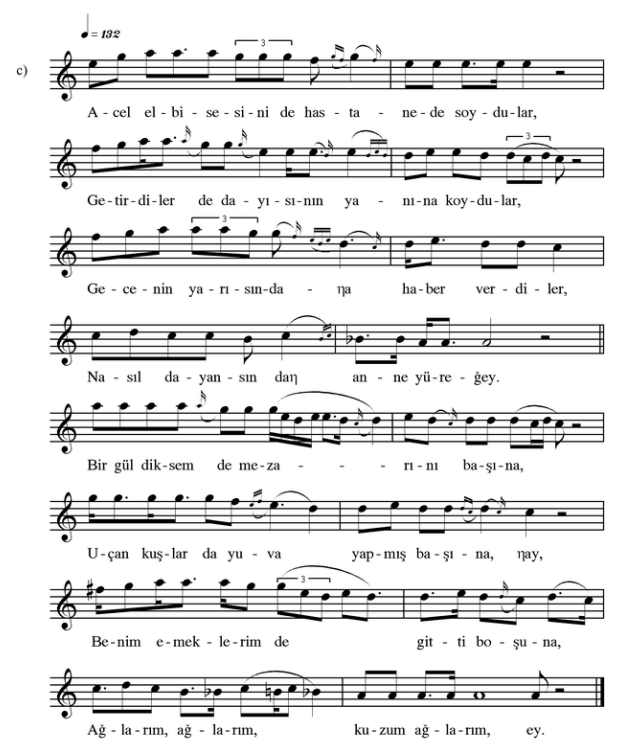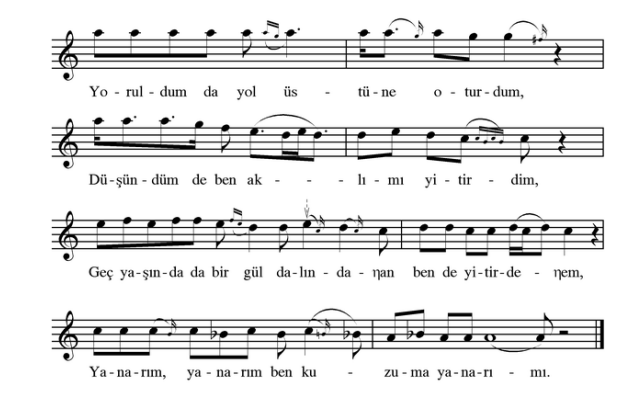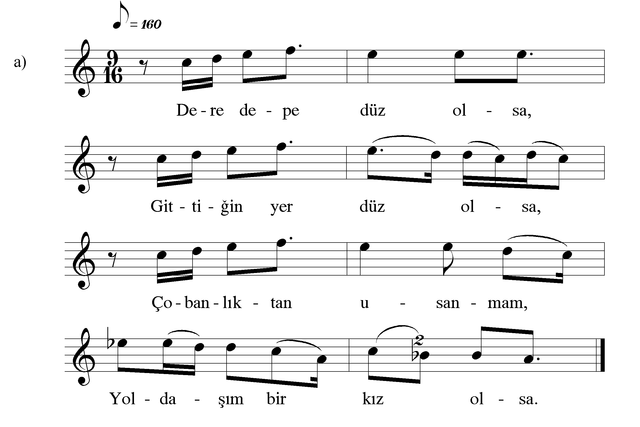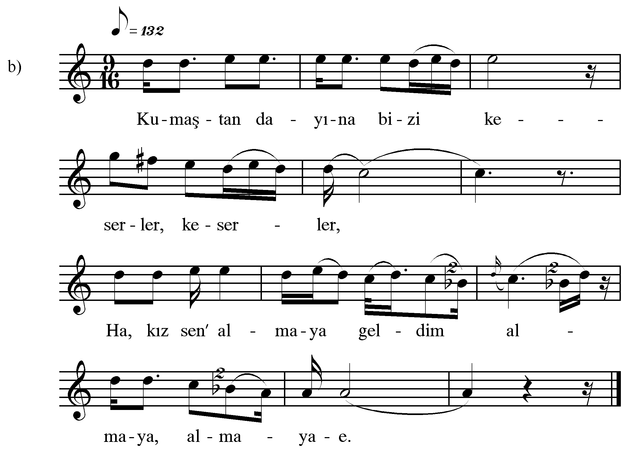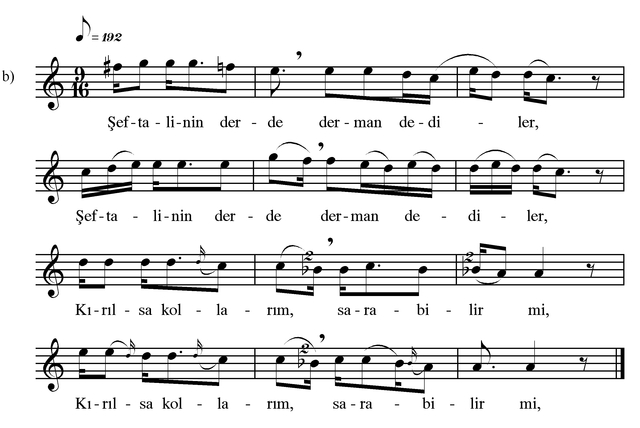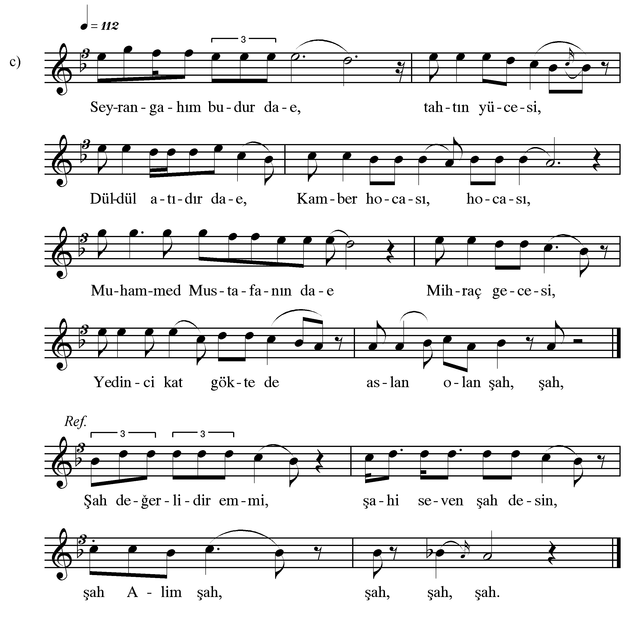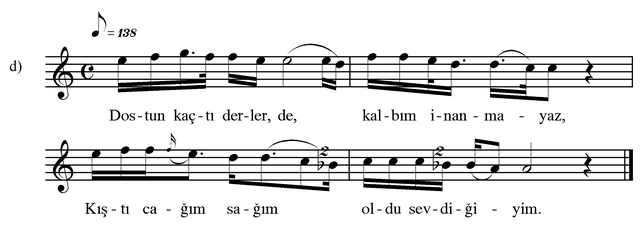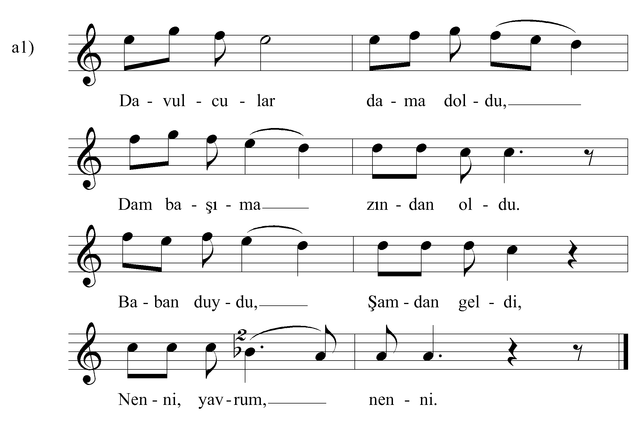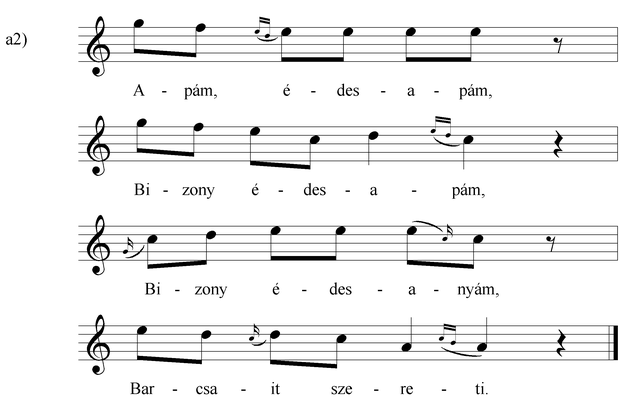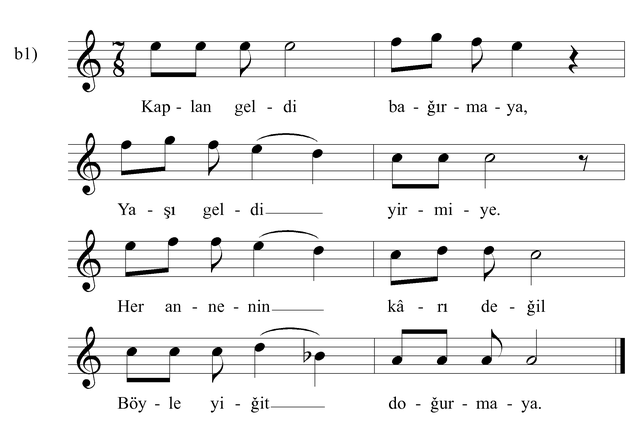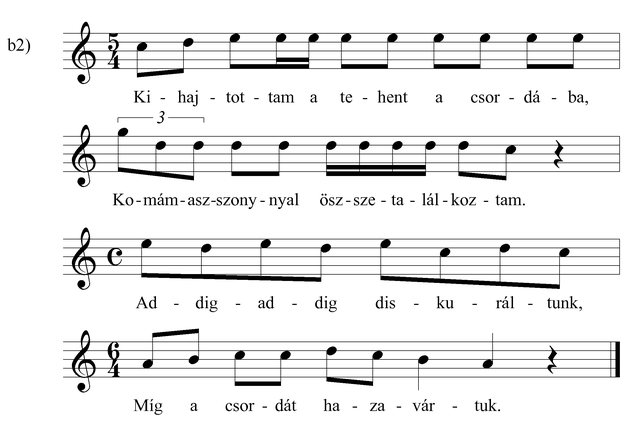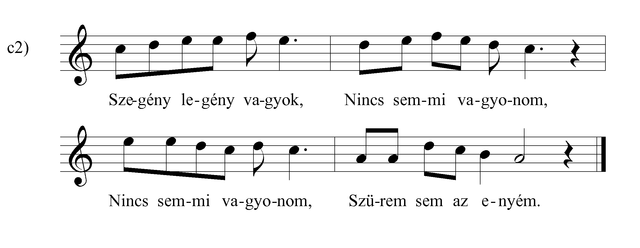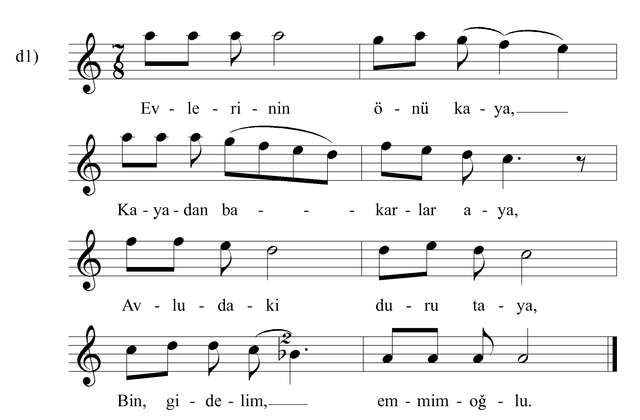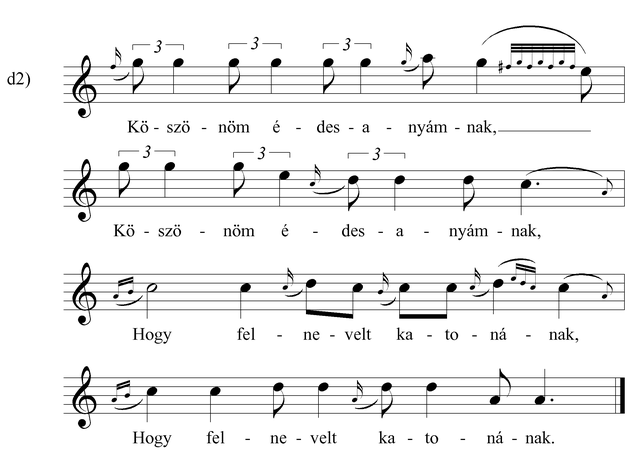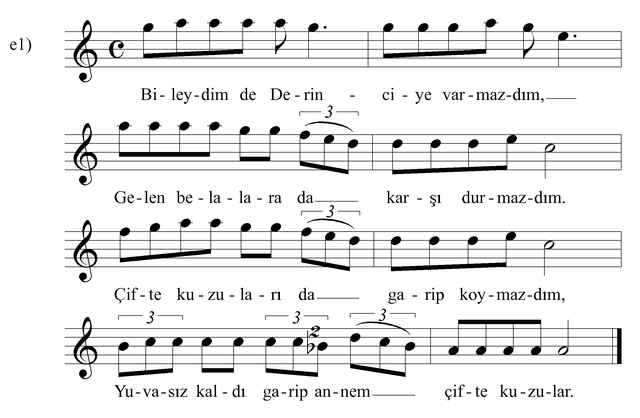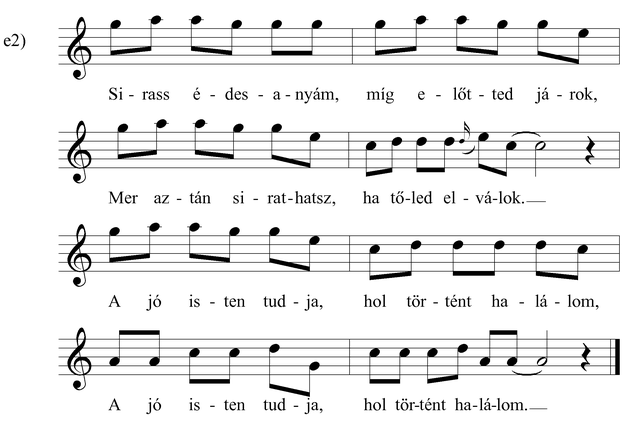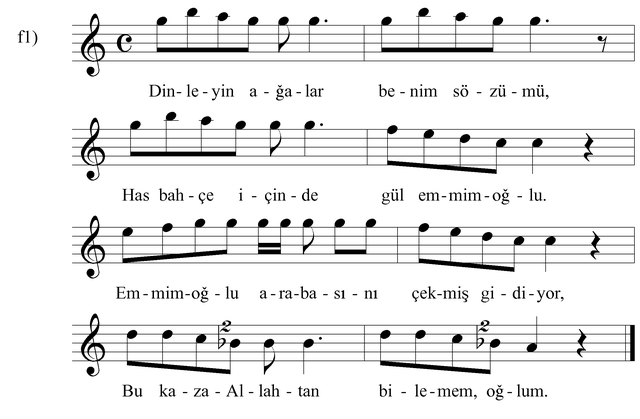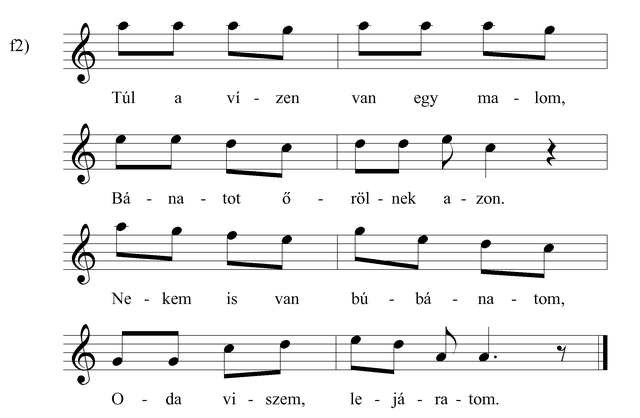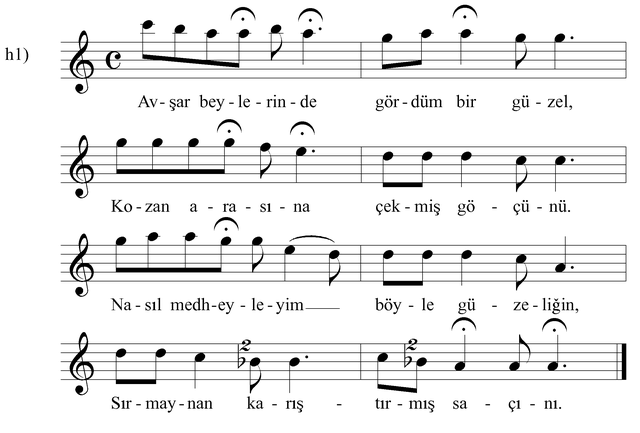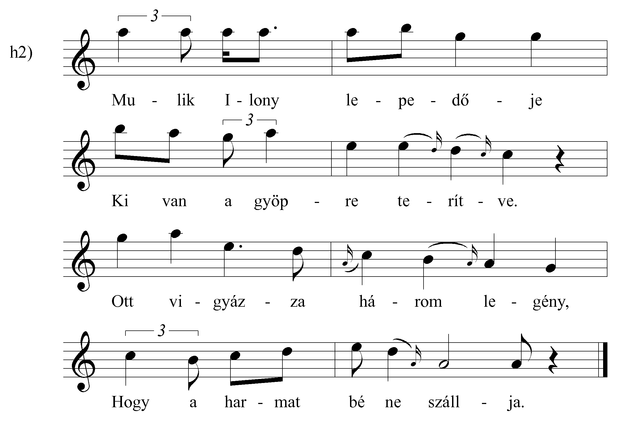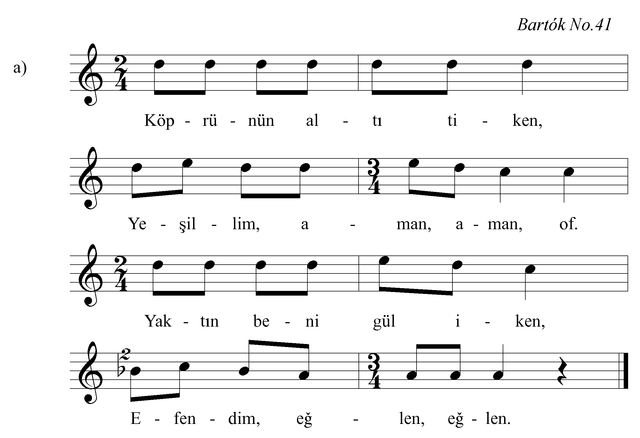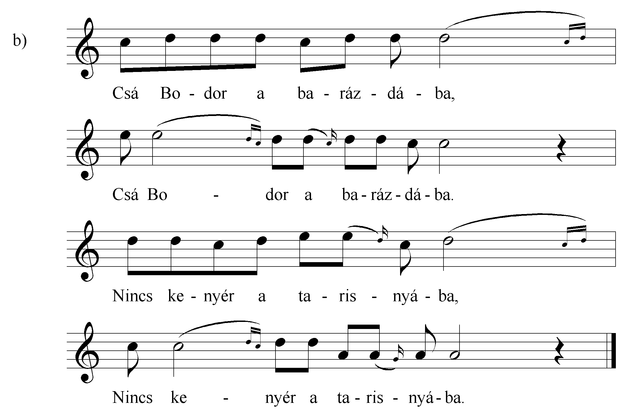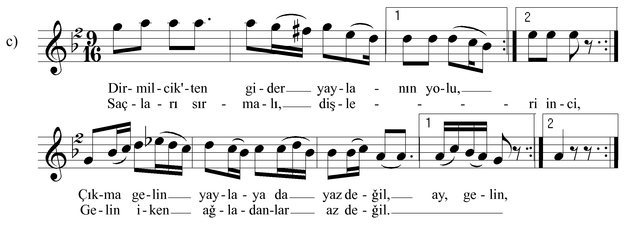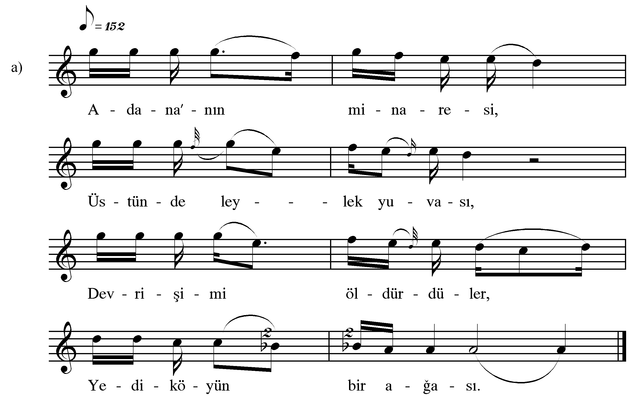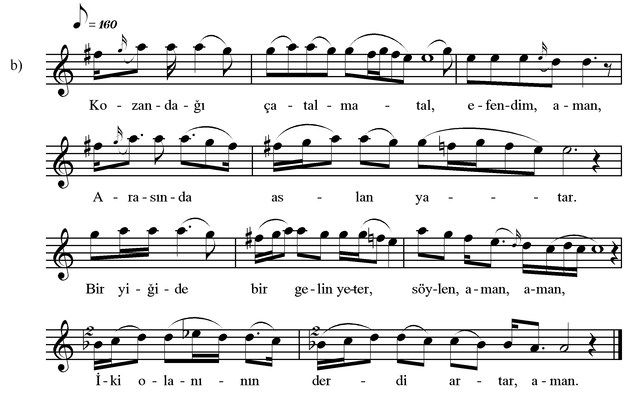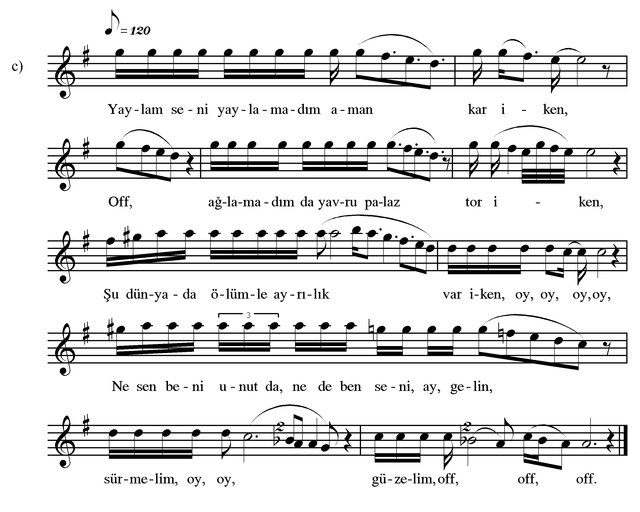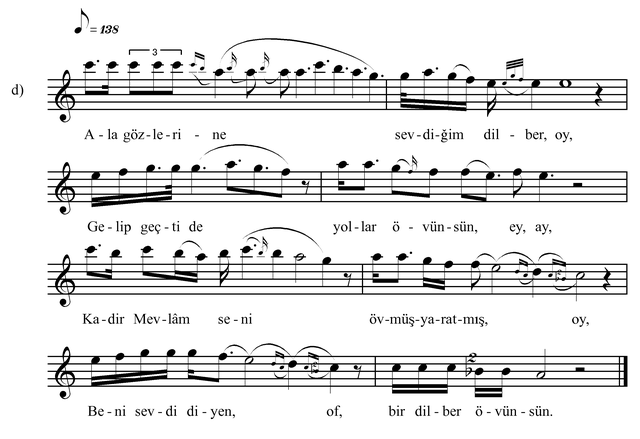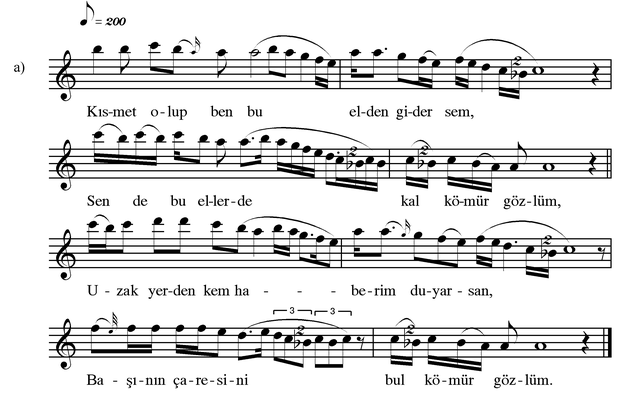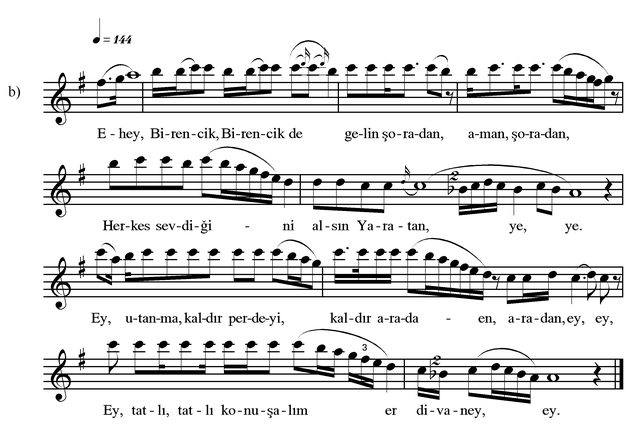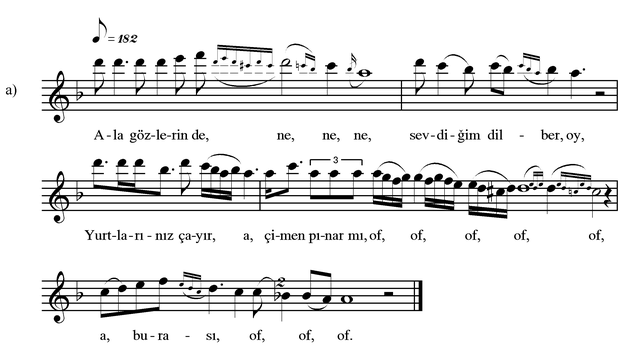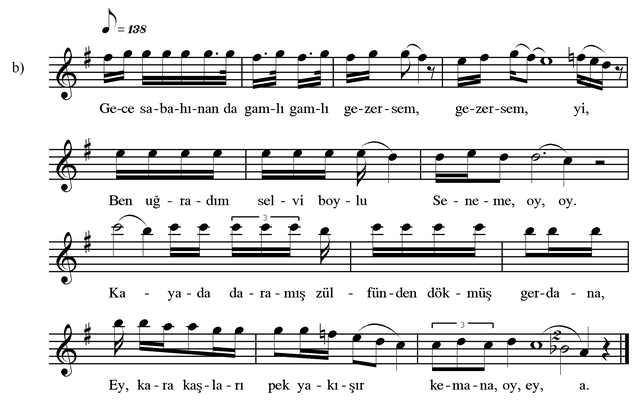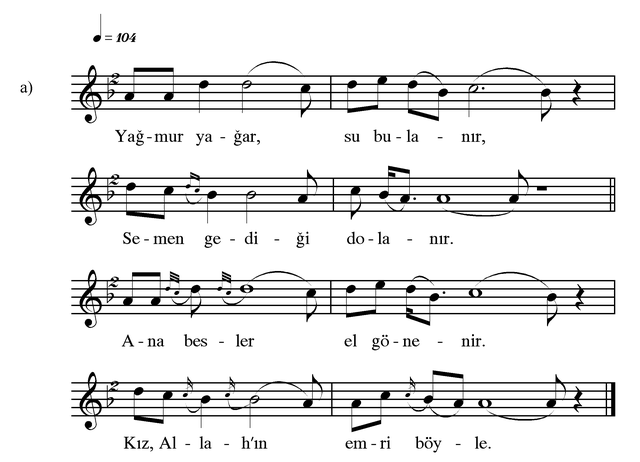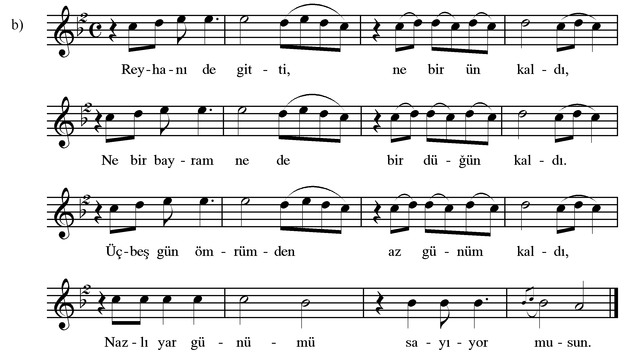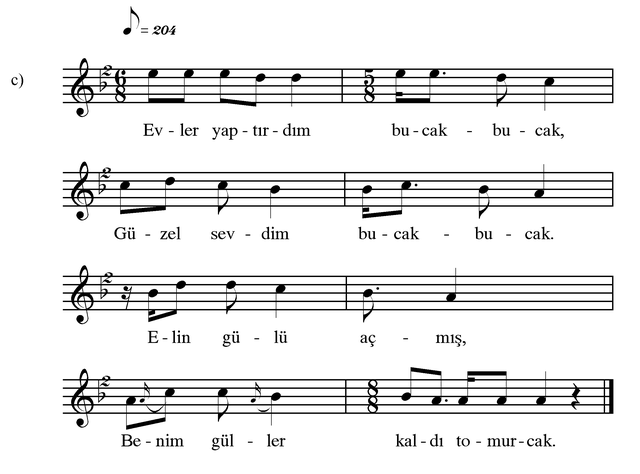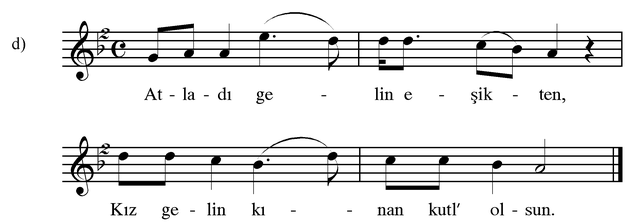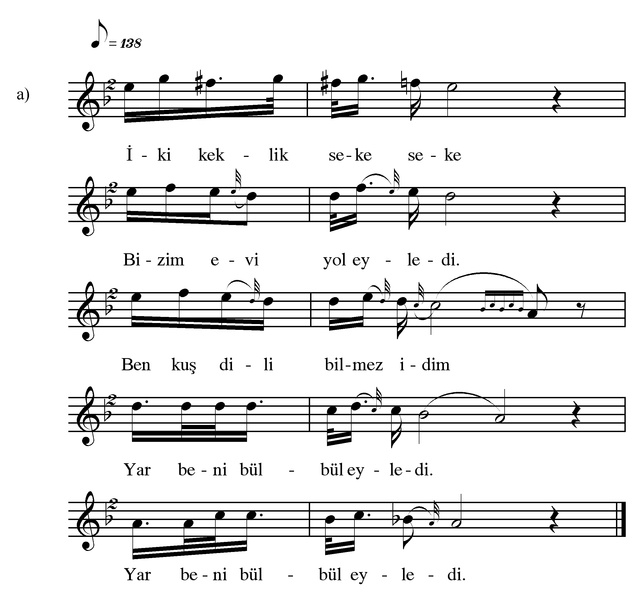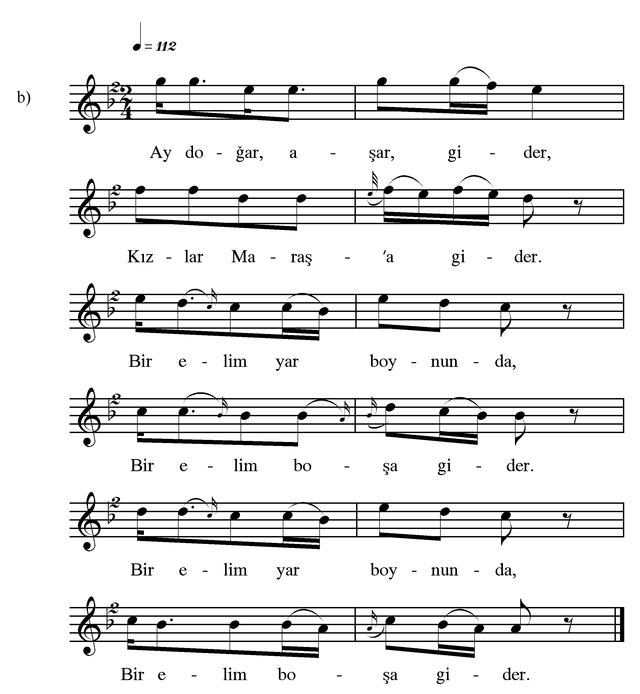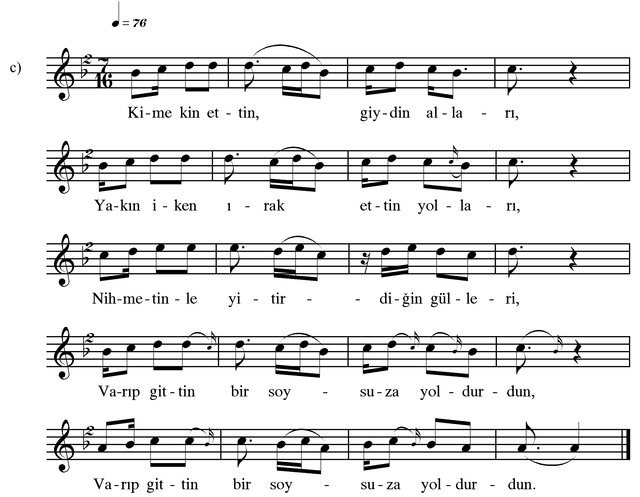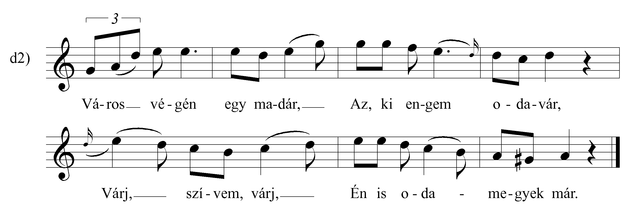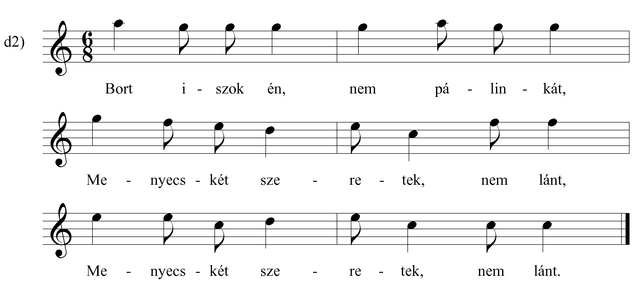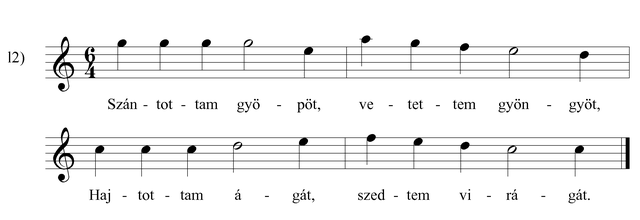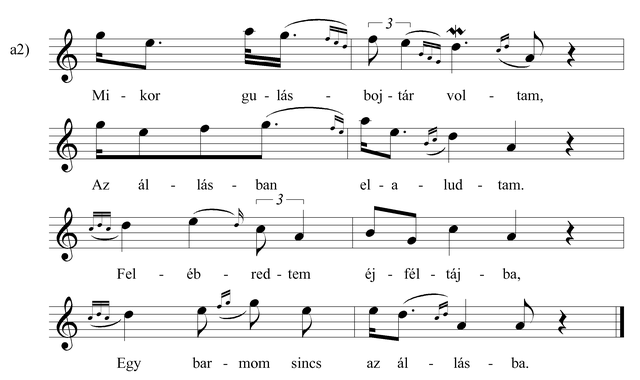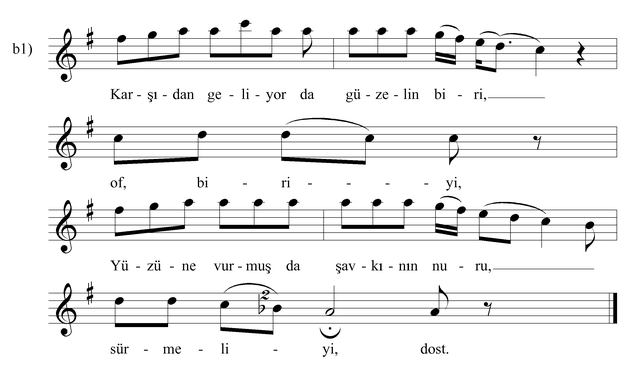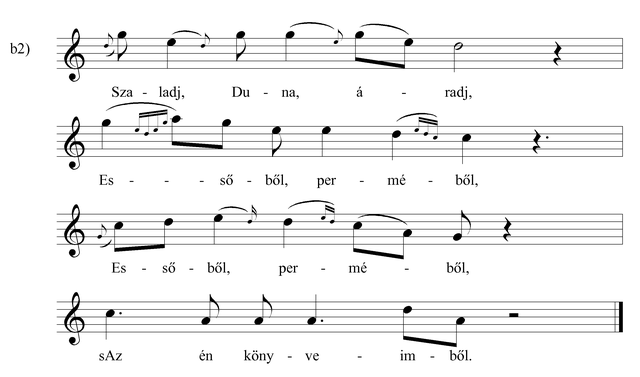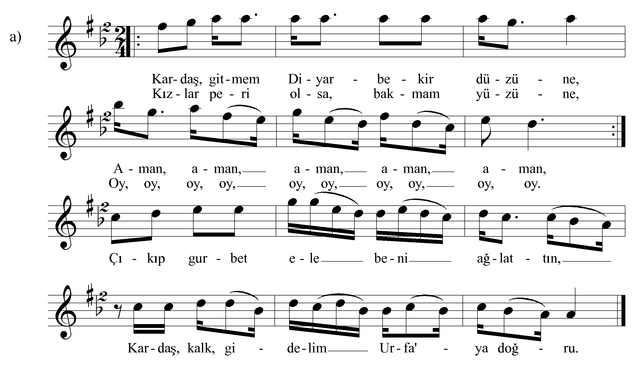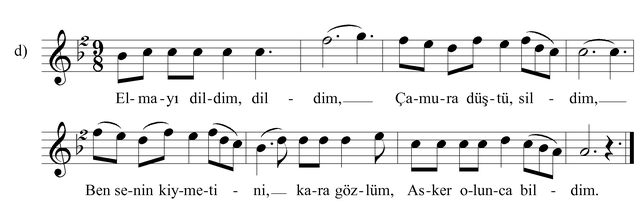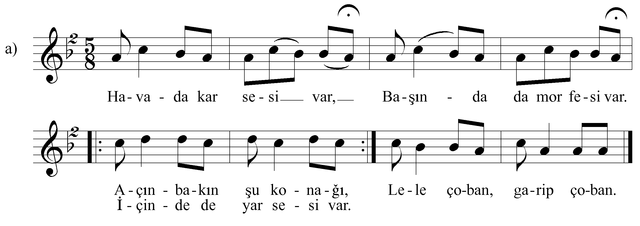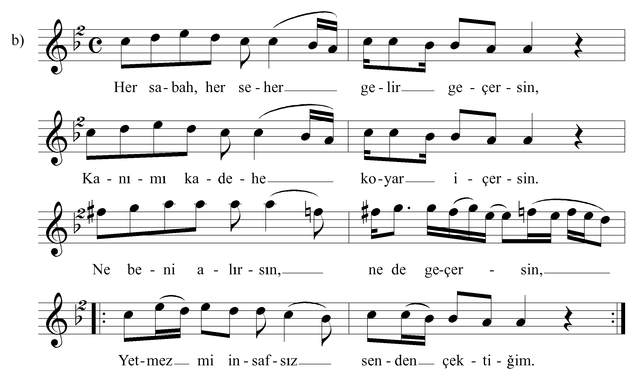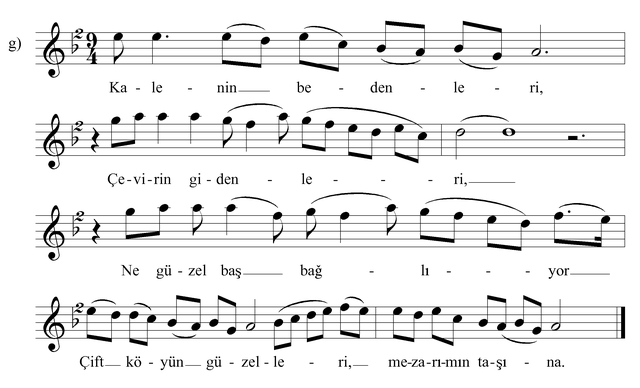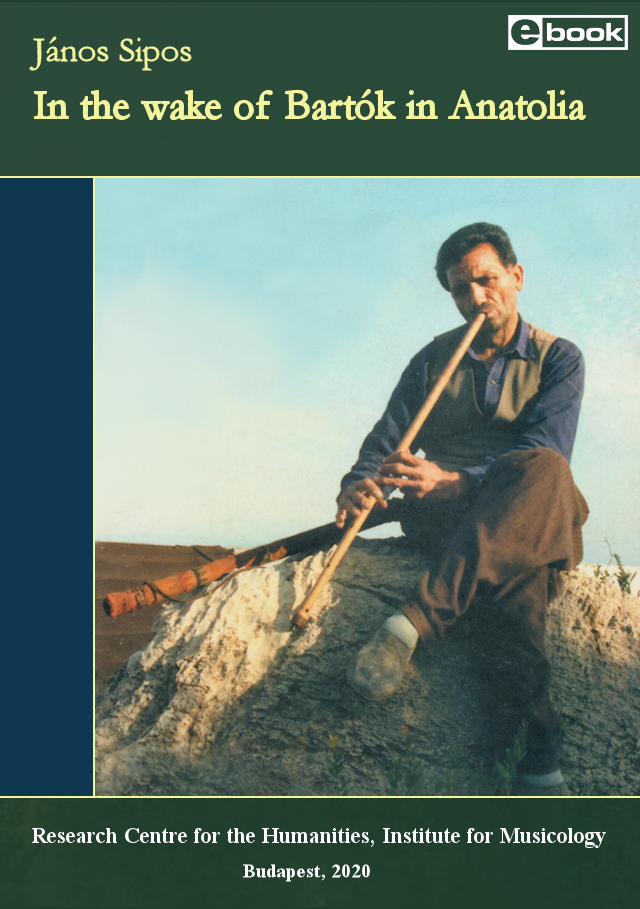
János Sipos
In the wake of Bartók in Anatolia
E-book
Research Centre for the Humanities, Institute for Musicology
Budapest
2020
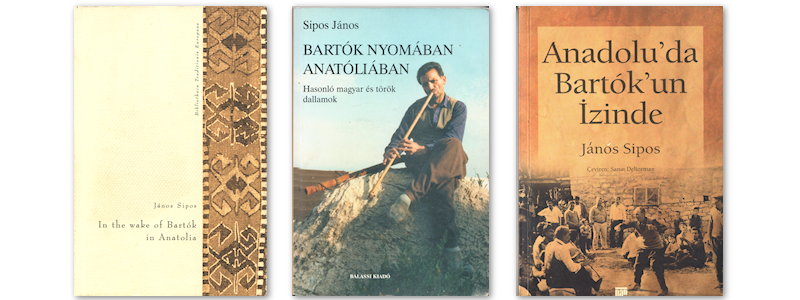
First publication Sipos, János (2000) In the wake of Bartók in Anatolia. Bibliotheca Traditionis Europea (ISSN 1419-7901) (2). European Folklore Institute, Budapest. ISBN 963-00-3672-X
Sponsored by the Ministry of National Cultural Heritage of Hungary
The expeditions were supported by the
Stein-Arnold Exploration Fund of the British Academy and the
Tokyo Foundation
The CD was prepared with the help of the Turkish Republic
Photos and musical transcriptions by János Sipos
Turkish text and translation by Éva Csáki
English translation by Judit POKOLY
Translation revised by Aino PAASONEN
CD compiled by János SIPOS
© European Folklore Institute 2000, © János Sipos 2000
Budapest 2000
The e-book was sponsored by the OTKA-NKFI 115405
© Research Centre for the Humanities, Institute for Musicology 2020
© János Sipos 2020
DOI: 10.23714/nzntk.ebook.SJ02-en
ISBN: 978-615-5167-29-4
Editor: Éva Csáki
Technical preparation: Adrienn Ádám
Programming: Zsolt Kemecsei
This e-book is an electronic version of the volume quoted above. It differs from the printed form in that the notes were transposed to A, and Bartók's notes were published in a simpler form for the sake of comparison. There have been a number of major and minor corrections to the sheet music and lyrics, which can be seen in the Anthology.
Using the e-book
● You can click on the symbol ![]() below the notes to see an improved version of that note and listen to the recording of the melody. If you want to see the corrected notes and listen to the recording at the same time as reading, drag the sheet music and the playback tab from the browser header to a separate window. Playback can also be fully compressed, and the browser's zoom function allows you to zoom in and out on pages. Clicking on the speaker signal (
below the notes to see an improved version of that note and listen to the recording of the melody. If you want to see the corrected notes and listen to the recording at the same time as reading, drag the sheet music and the playback tab from the browser header to a separate window. Playback can also be fully compressed, and the browser's zoom function allows you to zoom in and out on pages. Clicking on the speaker signal (![]() ) results the sound of the field recording, and clicking on
) results the sound of the field recording, and clicking on ![]() results an electronically generated sound. (In several cases, the audios do not match the trancriptions and are the near-far variants of the latter.)
results an electronically generated sound. (In several cases, the audios do not match the trancriptions and are the near-far variants of the latter.)
● Using the e-book is facilitated by a tool box in the lower left corner: by entering the page number you can jump to a specific page of the original printed book, the second icon jumps to the table of contents, the third icon allows you to print the book or part of it, and a search bar is at the bottom.
Contents
 Explanations of the signs
Explanations of the signs Introduction
Introduction Béla Bartók's Turkish collection
Béla Bartók's Turkish collection About my collection in Anatolia
About my collection in Anatolia Precedents
Precedents My first collecting trip in Turkey
My first collecting trip in Turkey Folk music in today's Turkey
Folk music in today's Turkey Analogies between Anatolian and Hungarian melodies
Analogies between Anatolian and Hungarian melodies Realizations of the G-(F)-E-D-C nucleus and the related tune types
Realizations of the G-(F)-E-D-C nucleus and the related tune types Twin-bar tunes of G-E-D-C core
Twin-bar tunes of G-E-D-C core Twin-bar tunes ending on C
Twin-bar tunes ending on C Twin-bar tunes ending on D
Twin-bar tunes ending on D Twin-bar melodies with E finals
Twin-bar melodies with E finals Similar twin-bar tune types of other peoples
Similar twin-bar tune types of other peoples Hungarian and Turkish laments
Hungarian and Turkish laments Hungarian laments
Hungarian laments Anatolian laments
Anatolian laments Anatolian laments built from one musical idea
Anatolian laments built from one musical idea Anatolian laments built on two musical ideas
Anatolian laments built on two musical ideas Single-core Anatolian laments with cadential descent
Single-core Anatolian laments with cadential descent Anatolian laments with two musical ideas and a cadential descent
Anatolian laments with two musical ideas and a cadential descent Strophic tunes developed from the lament
Strophic tunes developed from the lament Anatolian laments in minor and Phrygian modes
Anatolian laments in minor and Phrygian modes Large forms developed from the small-form of the Anatolian lament
Large forms developed from the small-form of the Anatolian lament International relevances of Hungarian and Anatolian laments
International relevances of Hungarian and Anatolian laments The Hungarian and Turkish psalmodic tune style
The Hungarian and Turkish psalmodic tune style Hungarian psalmodic melodies
Hungarian psalmodic melodies Anatolian and Hungarian psalmodic tunes in a low register
Anatolian and Hungarian psalmodic tunes in a low register Turkish and Hungarian psalmodic tunes moving in a higher register
Turkish and Hungarian psalmodic tunes moving in a higher register Psalmodic tunes based on two musical ideas
Psalmodic tunes based on two musical ideas Psalmodic tunes in Béla Bartók's collection
Psalmodic tunes in Béla Bartók's collection Disjunct tunes
Disjunct tunes Lower fifth-shifting Anatolian tunes
Lower fifth-shifting Anatolian tunes Tune class of 5(5)b3 cadences and AAAcB form
Tune class of 5(5)b3 cadences and AAAcB form Fifth-shifting Anatolian tunes of major mode
Fifth-shifting Anatolian tunes of major mode Tunes with 'special fifth-shifting'
Tunes with 'special fifth-shifting' Parlando melodies with large compass
Parlando melodies with large compass Melodies with sequences
Melodies with sequences Descending sequences of bars
Descending sequences of bars Sequences of lines, parallel lines
Sequences of lines, parallel lines Other Hungarian-Anatolian musical analogies
Other Hungarian-Anatolian musical analogies Tri- and tetrachord tunes
Tri- and tetrachord tunes Hungarian analogies to narrow-compass Anatolian tunes
Hungarian analogies to narrow-compass Anatolian tunes Four-lined Anatolian and Hungarian melodies
Four-lined Anatolian and Hungarian melodies Unique melodic outlines and scales in Anatolian folk music
Unique melodic outlines and scales in Anatolian folk music Anatolian tunes of architectonic construction
Anatolian tunes of architectonic construction Turkish-Hungarian contact in the course of history
Turkish-Hungarian contact in the course of history Turkic relations of the Hungarians
Turkic relations of the Hungarians The ethnogenesis of the Anatolian Turks
The ethnogenesis of the Anatolian Turks The influence of neighbouring peoples upon Anatolian folk music
The influence of neighbouring peoples upon Anatolian folk music Texts and their translation into English
Texts and their translation into English AFTERWORD
AFTERWORD Abbreviations, references
Abbreviations, references Abbreviations
Abbreviations References
References
Explanations of the signs
Before embarking upon the musical analyses, let me explain the basic concepts and abbreviations without which the next section cannot be understood.
● As regards the degrees, C = b3rd degree, D = 4th, E = 5th degree, etc. The note below C = 2nd degree (B/Bb), minor third below C = 1st degree (A), then, stepwise, the VIIth, VIth, etc. degrees follow. The second degree lowered by a semitone is marked with Bb, the sixth degree raised by a semitone is marked with F#.
| note | G' | F' | E | D | C | B | A | G |
| degree | 7th | 6th | 5th | 4th | 3rd | 2nd | 1st | VIIth |
● A note of the scale is put in brackets when it does not play an important role in the tune. For instance, in a melody with the (G)-E-D-C scale the main role is played by the notes of the trichord E-D-C, with occasional G added, but not in an accentuated role.
● Av indicates a variation of the musical line A when the deviation is at the beginning or middle of line A. Ac indicates a variation of the musical line A where the deviation between the two lines is in the last (cadential) part of the lines. Both Av and Ac suggest that A is the closed line, Av and Ac meaning more open variants, thus formulae like AcA, ABcB, etc. are frequent.
● By padding words, padding syllables, I understand words or syllables that are either devoid of meaning (ay, oy, vay, da, de, etc.) or, when meaningful, have no connection with the main text (aman, anam, gelin, etc.).
● A cadential note is the last note of the line. In the case of a four-line melody 5(4)b3 mean that the cadence of the first section is on the 5th degree (E), that of the second ones is on the 4th degree (D), that of the third one is on b3 (C) and the melody ends on the 1st degree (A). When the pitch of the last tone was not clear, I tried to define it on the basis of similar tunes and analyses.
● When no tempo indication is specified in an example, it was performed in parlando-rubato rhythm. However, it must be kept in mind that in reality, there is a wide variety of rhythmically free performance.
● Set rhythm is called tempo giusto or giusto as customary in Hungarian folk music research.
● The numbers indicated with the abbreviation № are serial numbers of tunes in Sipos (1994) and Sipos (1995). My own collection was supplemented by mostly giusto melodies published by the Turkish Radio and Television and by laments and plaintive songs that I copied from the archives of the Selcuk University in Konya and transcribed. Four Turkish materials were referred to: Bartók's collection (Bartók №), my own collection (№), the tunes from the Konya archives (Konya №) and the TRT repertory (TRT №).
Introduction
„[...] Folk music is a phenomenon of nature...
This creation develops with the organic freedom
of other living organisms in nature: flowers, animals, etc.
That is why folk music is just as beautiful, just as perfect.
It is the embodiment of the pure musical thought
that astonishes us with the conciseness and expressiveness
of form and the wealth of tools on the one hand,
and with its freshness and directness, on the other.”
Béla Bartók, A népzene forrásánál [At the source of folk music] ,
In: Muzyka 1925, vol. II, № 6, p. 230-233.
While the comparative linguistics of Turkic peoples has reached a high level of scholarship, comparative ethnomusicological research into the music of Turkic peoples lags far behind. No monographs indispensable to comparative analyses have been written, and attempts at tune systematization and comparative investigation are also often missing.
This is so though the question of whether the folk music of different Turkic peoples and of the Hungarians have features in common deserves general attention. Just as important would be to establish what the possible coincidences can be attributed to.
It is imperative for Hungarian ethnomusicology to get an insight into the old strata of Turkic folk music, for it is known that some Turkic ethnic groups played a salient role in the emergence of the Hungarian ethnicity, Hungarian culture and folk music. It is no wonder then that Hungarian researchers have played a leading role in the comparative examination of Turkic and Hungarian folk music.
Béla Bartók, from relatively little material, reached some conclusions still valid today about the folk music of the Volga-Kama region and Anatolia,1 Zoltán Kodály extended the analogies by studying the folk music of Cheremiss and Chuvash people.2 On the basis of an immense collection from field-work among Cheremiss, Chuvash, Mordvin, Tatar and Bashkir peoples, László Vikár described these musical traditions.3 From a study of publications, Lajos Vargyas established a historical outline of the folk music of the Volga region.4 Having studied an immense amount of material, Bence Szabolcsi demonstrated even broader international musical connections.5 With a novel approach to the Hungarian material, László Dobszay and Janka Szendrei have made an ethnomusicological study of the Hungarian lament and psalmodic styles in a broad international context.6 My six-year collecting work between 1988-1993 in Anatolia as well as my study trips to Kazakhstan and Azerbaijan also fit into this range of work.
In this volume, I am going to study a single aspect of this extensive research: whether there are similar tune types in Hungarian and Anatolian folk music, and if so, what degree of similarity can be verified and what can it be attributed to. Béla Bartók was the first to seek answers to these questions.
Bartók collected folk music in Turkey in 1936, transcribing and analyzing the tunes at his usual high level of scholarship. His Turkish collection, however, shared the fate of the rest of his folk collections, to not be published until 1976, well after the composer's death, but then almost simultaneously in Hungary and America, and in 1991 in Turkey. None of these publications made a stir, although the work is not merely one that addresses Hungarian and Turkish prehistory and the Hungarian-Turkish musical connections in depth, but it is also a milestone in ethnomusicology. It is known, though, that Bartók ascribed great significance to this work. After a long interval, that was his first – and last – collecting trip, and before emigrating to America, his profound interest in Turkish music made him consider resettling in Turkey.
What may underlie this lack of scholarly interest? Disregarding for now all sorts of possible explanations, one argument still carries much weight: Bartók's Turkish collection is so meagre that drawing conclusions valid for the folk music of a people numbering some sixty million is only possible with much caution and reservation. And up to most recently, there has been no comprehensive analysis of Turkish folk music that would have provided a frame of reference to help interpret Bartók's collection.
When I taught at the department of Hungarology of Ankara University, Turkey, in 1988-1993, I had the opportunity to collect some 1500 tunes. I began my collection in areas where Bartók had stopped his. Then, as fewer and fewer new tunes were found, I shifted my field of research gradually westward. I also gleaned all possible information from publications of Turkish tunes available, adding another three thousand tunes to my own collection after their critical revision. A six-year stay on the spot, the mastery of the Turkish language, consultations with Turkish ethnomusicologists and first and foremost, regular collecting, transcribing and analyzing work enabled me to prepare a large body of systematized Turkish material for publication.
Before addressing my own collecting, however, let us return to Béla Bartók's research in Turkey.
Béla Bartók's Turkish collection
Besides Hungarian folk music and the music of neighbouring peoples, Bartók was deeply interested in the music of linguistically related and other peoples. In 1924 he published three Cheremiss folksongs whose fifth-shifting pentatonic style he compared to the Hungarian folksongs, concluding: „[...] the connection between the Hungarian pentatonic material and the Cheremiss material is indisputable.”7 He ascribed such great importance to this discovery that he began learning Russian and prepared to journey to the Cheremiss people along the Volga. After World War I he was forced to abandon this plan but the theme kept preoccupying him.
For example, in 1935, Bartók said:
„[...] when we settled to this work we became convinced that [...] the origin of the pentatonic style pointed to Asian and northern Turkic peoples [...] Apart from Hungarian tunes that were variants of Cheremiss songs, we also found Hungarian tunes that were variants of north Turkic tunes derived from around Kazan. I have recently received Mahmud Ragib Köşemihal's book [...] The tonal specificities of Turkish folk music in which I also found some melodies of this kind [...] Obviously, all tunes of this kind derive from a common source, and this source was the old central north-Turkic culture.”8 Or, as he later summarized even more succinctly: „[...] I first searched for Finno-Ugrian-Turkic similarities among peoples by the Volga, and then, starting from there, in the direction of Turkey.”9

Figure 1 Photo of Bartók from the year of collection (Bónis 1972, pic. 271)
After such precedents, László Rásonyi, the professor of the faculty of Hungarian philology and history at Ankara University founded around that time, wrote a letter dated 1 December, 1935, to Bartók, recommending that he should collect in Turkey.10 In April 1936 the president of the Halkevi in Ankara officially invited Bartók to give a lecture on the methods of folk music collection and on the main principles of his compositional school. Bartók was overjoyed to read the news, accepted the invitation and was already learning Turkish in the summer.
Bartók arrived in Istanbul on 2 November, 1936, where he studied the curriculum of the conservatory for a day, before going on to Ankara in the company of Turkish composer A. A. Saygun. He held three lectures and a few concerts and began collecting. On the evening of 18 November, upon Rásonyi's advice, they set out for the south of Turkey, to the seaside around Osmaniye near Adana, for some nomadic tribes had their winter residence there. On 19 and 20 November, they worked most efficiently in Adana with singers recruited in the villages. On 21 November they went to Tarsus and then to Mersin. Let us see Bartók's notes:
„[...] On the fourth day, we at last arrived in the area of the Yürüks as originally planned, about 80 km further to the east of Adana, first entering a large village called Osmaniye. The inhabitants of Osmaniye and some other neighbouring villages belong to the tribe called 'Ulas', which tribe was forced to switch over to sedentary existence some 70 years ago. We arrived in Osmaniye after 2 p.m. and at 4 we were in the courtyard of a peasant home.
I was secretly very happy that at last I was doing on-the-spot collection, at last I was going to a peasant house again! The host, Ali Bekir oğlu Bekir aged 70 welcomed us warmly. The old man burst into a song without any reluctance there in the court, singing some old war story:
Kurt paşa çıktı Gozana
I could hardly believe my ears: good heavens, this is like a variant of an old Hungarian tune! Pleased as I was, I immediately recorded the old Bekir's singing and playing on two full cylinders[...] The second tune I heard Bekir sing was again the kin of a Hungarian tune: that's quite shocking, I thought.
Later the old man's son and other people who gathered there offered songs and the whole night was spent in delightful work to my liking.”12
Figure 3 Bartók outside a nomadic tent in Turkey in 1936 (Bónis 1972, pic. 281)
The next day, on 23 November they rode to a nearby village, Çardak, where they collected instrumental tunes in addition to vocal ones, and to their pleasure, the old Bekir's 'Hungarian' tune was also heard here. On 24 November they reached the tents of the Kumarlı tribe who had just returned to their winter abode at the foot of the Tüysüz Mountain, but only the women were found at home. They were unwilling to sing without the permission of their husbands. In the afternoon, after long efforts at persuasion, successful collecting was done at the winter residence of another nomadic tribe, the Tecirli:
„[...] At long last we have folksongs, and perhaps the ice will melt soon. And sure enough, the first tune was intoned almost without reluctance, again a very Hungarian-like tune, sung by a 15-year-old boy.”13
They finished their collecting work in Adana on November 25. Back in Budapest, Bartók immediately sat down to transcribe the tunes recorded on 64 cylinders. The bulk of the work was completed by May 1937, but problems with the text interrupted the work on the Turkish collection temporarily. He returned to the material in May 1938 and sent the rest of the Turkish texts to Rásonyi.
On March 13, 1939, German troops invaded Austria, which upset Bartók immensely. In December 1939, he lost his deeply beloved mother, and he made up his mind irrevocably to immigrate to America. He prepared the clean copy of the Turkish music examples and the typewritten copy of the Turkish texts was also completed.14
It is less widely known that he would have gladly chosen Turkey instead of the United States to continue his collecting work. He asked Saygun, who had escorted him on his trip, to inquire whether there was any possibility for him to work in Turkey as a folk music researcher. All he expected in return was minimum pay to make ends meet. Saygun first replied most enthusiastically, indicating that he knew the new minister well and hoped to be able to arrange Bartók's settlement.15 But, the changes in the foreign and domestic policies of Turkey turned not only Bartók but also Saygun into persona non grata in Ankara, and that foiled the plan.
In April 1940, Bartók first went to America on a conventional tour of concerts and scientific lectures, and then on 8 October, 1940, he emigrated for good. In June 1943 he wrote:
„[...] I prepared for publication my Turkish material, again with a 100 pp. introduction etc. All this was very interesting for me. The trouble is that extremely few people are interested in such things, although I arrived to (sic!) highly original conclusions and demonstrations, all proved by very severe deductions. And, of course, nobody wants to publish them [...] ”.16
On 3 October of the same year he wrote:
„[...] Nothing can be done with the Rumanian material for the time being. Fortunately, however, I have another work, to offer for publishing, about less than half the size of the Rumanian one. It is the »Turkish rural folk music from Asia Minor [...] «”
This work contains the first collection of rural Turkish folk music ever made by systematic research, and the first ever published. The Introduction contains a description of how to determine the approximate age limit of rural folksong material, in certain specific cases. Such problems have never yet been described and published. Therefore, this feature of the book has an international significance. Besides this, many other highly interesting questions are treated in the Introduction.”17
On 15 October the music library of Columbia University turned down the Turkish volume, and moreover, he learnt that he had to wait out the end of the war with the Rumanian volumes as well. On 1 July, 1944, Bartók deposited the clear copy of Turkish Folk Music from Asia Minor in the library of Columbia University. That was where it was resuscitated in 1976 in Hungary and America (both published in English), and then in Turkish translation as the facsimile of the American edition.
Three books have been published of Bartók's Turkish collection, colourful accounts can be read about it18 and the theme also features significantly in my PhD dissertation.19 It suffices therefore only to cite the essential statements about the musical material. Bartók divided the collected tunes into classes. He explained:20
„[...] Class 1 and 2, containing 33 melodies (43%) out of the 78 vocal melodies; obviously form the most important part of the material. The characteristics of Class I (about 20% of the collected vocal material) are as follows:
(1) 8-syllabic melody sections in parlando rhythm which may be considered as a derivation of supposedly original equal eighth values ![]() the transformation of the values results in the most various, though not always stable rhythmical formations, showing as a general feature the rather considerable prolongation of the final tone of the sections, or at least of the 2nd and 4th sections.
the transformation of the values results in the most various, though not always stable rhythmical formations, showing as a general feature the rather considerable prolongation of the final tone of the sections, or at least of the 2nd and 4th sections.
(2) More or less rich ornaments (melismatic groups) of various kinds.
(3) A scale with minor third, mostly the Dorian mode (in four cases Aeolian mode…), the second (sometimes the sixth) degree frequently unstable (↓).
(4) …The position of the sections's final tones on the degrees b3, 4, 5, 7 and 8, i.e. exclusively on the degrees of the ![]() pentatonic scale… gives a sufficient evidence for the latent pentatonic structure existing in these melodies.
pentatonic scale… gives a sufficient evidence for the latent pentatonic structure existing in these melodies.
(5) The fact that 5) is the most frequent final tone in the 1st melody sections, and (b3 in the 3rd sections, already shows the prevalence of the so called 'descending' structure of the melodic line, which means that the first half of the melody is placed approximately in the upper half of the octave, and the second half (or last quarter) in its lower half.
If we compare these characteristics with those of the Old-Hungarian melodies with 8-syllabic sections, we will see that they are literally identical. The only differences are as follows:
(1) The Turkish melodies in question never touch the VII degree which, however, occurs rather frequently in the Hungarian melodies;
(2) The Hungarian melodies show the pentatonic structure more clearly, even in their melodic line and not only in the final tones of the melody sections, as the Turkish melodies do;
(3) The so called 'transposing' structure (a variety of the 'descending' structure), comparatively frequent in the Hungarian material, in which the 2nd half of the melody is a repetition of the 1st half a fifth lower, does not appear in the Turkish melodies.
Incidentally, as a circumstance of minor importance it may be said that this relationship is especially conspicuous between Turkish material and Hungarian material found in Central Hungary, the area situated between the south bent Danube and the Western border of Transylvania…
Besides this striking similarity in the characteristic features of the Turkish and Hungarian parlando melodies with 8-syllabic sections, it can be said, moreover, that most of the nine Turkish melodies or variant groups of Class 1 have decided variants in the Hungarian material… Even these afford sufficient evidence to argue the closest relationship, or as I would put it, for the identity of both materials.”21
„[...] Considering the historical fact that these peoples lived near each other 12-15 centuries ago, later moved to rather distant territories, and could not have any intercourse with each other since their separation, it is evident that this musical style must be at least 1500 years old. The fact that such a statement is possible at all, makes this subject of international importance. If there is any other instance in the world which gives a possibility of such irrefutable determination of the age of folkmusic, going back so many centuries, I am not aware of it. The Northern and Southern Slavs, for instance, became divided also during the VIth and VIIth centuries but no vestiges of an ancient common Slav folkmusic have been discovered in their folk melodies.22
The melodies of Class 1 all come from the above mentioned Yürük and adjoining areas.
Class 2—23% of the collected vocal material—though in near relationship to Class 1, shows nevertheless some important deviations. These are as follows:
(1) Eleven-syllabic melody sections in parlando rhythm which may be supposed to derive from the schema: 
(2) more extended range… generally a range of 1 1/3 octaves.
(3) According to the wider range, the final tone of the first melody section is placed on a high degree… The main caesura and the final tone of the 3rd section, however, are generally placed on lower degrees… Nevertheless the position of the 3rd section is in approximately the upper half of the range, frequently even touching the highest tones of the scales. I.e. there is a tendency to keep the higher degrees as long as possible throughout the melodies.
(4) The melismatic groups… present much more elaborate ornaments than those of Class 1. This may be perhaps the sign of Arabic influence… Traits common to Class 2 and 1 are the parlando rhythm, the scale, the position of the sections' final tones almost exclusively on the pentatonic degrees, and the 'descending' structure which, however, approaches its resolution in Class 2 later than in Class 1. These common characteristics link the two Classes decidedly so to speak into a Twin-Class.
The features described under (1)-(4) do not occur in the Old Hungarian melodies with 11-syllabic sections; besides the metrical articulation of the latter is exclusively ![]() or some variation of this schema. Therefore, no Hungarian variants exist of them in spite of the related structure. – Incidentally, it may be said that some of the 18 melodies of Class 2 have texts of seemingly urban origin; and that the complicated aspect of these melodies give them somehow a more artificial character, in comparison with the simpler Class 1 melodies.
or some variation of this schema. Therefore, no Hungarian variants exist of them in spite of the related structure. – Incidentally, it may be said that some of the 18 melodies of Class 2 have texts of seemingly urban origin; and that the complicated aspect of these melodies give them somehow a more artificial character, in comparison with the simpler Class 1 melodies.
№s 15 and 16 are not derived from the Yürük area but from the rather distant Çorum vilayet. And just these two melodies lack the distinguishing characteristics mentioned under (2)(3)(4). They have, except for the syllabic number of the lines a structure and character absolutely identical with those of Class 1, and are, as a matter of fact, variants of Old Hungarian melodies, in spite of the slight difference in the metrical articulation mentioned above.
Next in importance to Classes 1 and 2 are Classes 13 and 14 – about 10% of the collected vocal material. These are related, especially in their 'dotted' rhythm, to the corresponding Hungarian Classes of 'dotted' rhythm melodies. № 42 even has Hungarian variants, and №s 40, 41, and 43 are very nearly related to Hungarian melodies, not only in their rhythm but also in their melodic structure.”23
„[...] The melodies representing the remaining Classes are so few that no type description of them can be given, and no conclusions can be drown [...] ”24
„[...] A special account of Classes 18, The Rain begging Songs … should be given. These songs have melodies with undetermined structure, consisting of repetitions of a 2/4 two bar motif in ![]() rhythm which appears sometimes slightly transformed. They are very similar to the Children's Song melodies of the Hungarians, Slovakians and some Western European peoples…”25
rhythm which appears sometimes slightly transformed. They are very similar to the Children's Song melodies of the Hungarians, Slovakians and some Western European peoples…”25
Bartók calls attention to some peculiarities of performance, e.g. pseudo-upbeats, and various features of the tone colour, special vibratos, the 'clucking' tones derived from the Arabic influence and the consonants filling the gaps. He compares these phenomena with the respective Hungarian, Serbo-Croatian, Rumanian and Slovakian features. About microtones he writes:
„[...] The pitch of the 2nd degree (a1, a1b) frequently shows certain instability, being either slightly lower than a1, or slightly higher than a1b, or sometimes neutral… Such deviations may occur also on the 6th degree (e2, e2b), but less frequently.”26
He analyzes the metric pattern of text lines, the structure of strophes, the interrelation between musical and textual lines, the refrains and rhymes, and compares all these with relevant Hungarian, Czech, Slovakian and Ukrainian features. He stresses that the musical and textual meters sometimes do not coincide, that the metric caesure often cuts up a word, and he touches on problems concerning the Turkish phoneme -ğ-. He embarks in details on the connection between text and meaning, as well as tune and text. Finally, he sums up:
„[...] The thourough study of this material discovered the following facts:
(1) The seemingly oldest, most characteristic and homogeneous part of the material, representing its 43%, consists of isometric four section melodies with 8-, or 11-syllabic text lines, in parlando rhythm, in Dorian, Aeolian or Phrygian mode, with descending structure, and in which traces of a pentatonic system appear, a system well known from Hungarian and Cheremiss folk music.
(2) One part of this material as described under (1), that one with 8-syllabic sections is identical with the Old Hungarian 8-syllabic material; the one with 11-syllabic sections is in near relation to the Old Hungarian material. This points to a common Western-Central Asiatic origin of both the Turkish and Hungarian materials, and determines their age as of being at least 15 centuries old.
(3) The 8-, or 11-syllabic text lines of this part of the material form 4-line stanzas, each text stanza for each melody stanza; no text line repeats occur. The rhymes represent aaba or aaab formulas.
(4) The beginning of the stanzas in Turkish as well as in Hungarian lyrical folk texts frequently consist of so called 'decorative' lines having no contextual connection with the main part of the text. The device seems to be an ancient usage common to both peoples, and is not known to any other neighbouring peoples.
(5) The rest of the material, i.e. the one not described under (1), is rather heterogeneous, and seems to originate from various sources.”27
My audacious intention was to check, on the basis of a larger Turkish collection, which statements of Bartók's study have abided the test of time and which have weakened or become disproved.
Figure 4 Facsimile of tune № 42 collected by Béla Bartók in Turkey ![]()
About my collection in Anatolia
Precedents
I arrived with Éva Csáki, my wife, in Turkey in the spring of 1987 to teach Hungarian at the Ankara University. We worked at the Hungarological department of Ankara University's Dil ve Tarih-Coğrafya or Falculty of Philology which was set up on 9 January, 1936 upon Atatürk's order, not long before Bartók's journey, and at which László Rásonyi was employed when Bartók was visiting the country.
The first job was adapting to an oriental culture different from the European in both language and gestures. The central part of adaptation was of course learning the Turkish language, required for both everyday life and collecting work.
Although I had a letter of recommendation from the Institute for Musicology of the Hungarian Academy of Sciences, field research lagged — not only because of my poor Turkish. The gravest difficulty was the lack of permission to research. Doing field research without permission would easily have entailed expulsion from Turkey. Moreover, it was also necessary for getting access to some libraries and institutions. Luckily enough, the head of the Hungarological department, Hicran Yusufoğlu, the dean of the university Rüçhan Arık, the professor of the department of ethnography, Nevzat Gözaydın — who had close ties with György Martin, the renowned Hungarian folk dance researcher, as well as Hungary's ambassador, the scholar of Turkic studies Prof. István Vásáry all embraced my cause.
With their help and recommendations, on 19 January 1988 I applied to the Turkish Emniyet Genel Müdürlüğü or Central Police Headquarters for permission to do research in the villages of Adana county. I contacted Ankara's Milli Folklor Araştırma Dairesi28 directed by Kâmil Toygar, an eminent researcher of Turkish folk cuisine, who promised to help as soon as I had received the research permit. In the meantime, I acquired the so-far untranscribed tunes collected by the noted Turkish folk music researcher Muzaffer Sarısözen around Adana in 1936. Fortunately, most texts were transcribed, but not the tunes. By way of preparations, I started notating the tunes in the collection. The Turkish Muzaffer Sarısözen recorded some 80 tunes in July and August 1936, not long before Bartók, and some singers in his collection also sang for Bartók. It is noteworthy that while Turkish ethnomusicologists only worked in towns with singers recruited from various towns or villages, Bartók insisted on the village or even nomadic setting. Sure enough, the material collected by Bartók from singers brought to town is highly similar to Sarısözen's material, whereas the simpler 'Hungarian-style' Turkish tunes in Bartók's Class 1 were all recorded in the villages and the tents of nomads. All things considered, Sarısözen's collection was useful supplementary and comparative material.
Figure 5 № 227 of the TRT sheets, A 'psalmodic' melody from Muzaffer Sarısözen's Urfa collection ![]()
Ahmet Yürür, deputy director of the State Conservatory in Ankara allowed me to work in the archives of the school. Besides, I took lessons in bağlama from the music director of the Türk Halk Korosu or Turkish State Folk Ensemble, and tried my hand at the kaval with the help of a member of the ensemble.
In the summer of 1988, I received the research permit which only needed renewal annually. I was favoured by luck indeed for I had met several Western researchers who had been denied permission to research in villages or had to wait very long.
Field work in Turkey lasted from 1988 to 1993. I chose three centres along the southern range of the Toros Mountains: Adana in the east where Bartók also collected, Antalya in the west, and Mut in between. I set out for collecting trips to the tiny isolated villages from these centres. I concentrated on collecting and notating vocal material, but also recorded a significant amount of instrumental music. I made eight trips, each lasting about two weeks. Apart from this region, I occasionally collected in other areas of Turkey (e.g. Ankara, Denizli, Trabzon, etc.). The bulk of the material was recorded in the homes of peasants and shepherds. All in all, I recorded on tape one thousand five hundred tunes from 233 informants in 85 places. I transcribed some one thousand tunes, of which I picked five hundred from 132 singers in 61 locations.
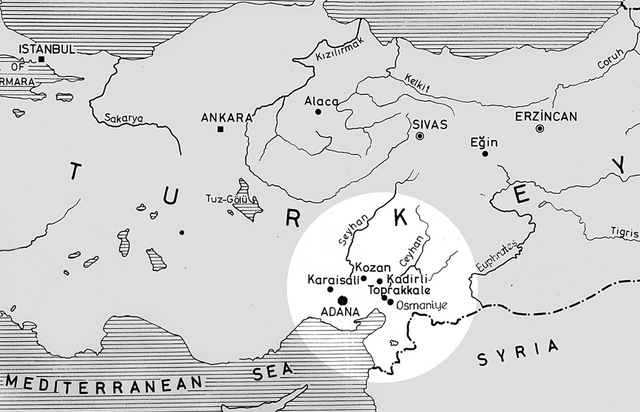
Figure 6 Map of the centers Bartók and I collected in Turkey
To supplement my collection, I analyzed a comparative material of 3000, mainly giusto tunes from nearly all over Turkey. This comparative material was compiled from the repertoires of Turkish Radio and Television, Béla Bartók's Turkish collection.
My first collecting trip in Turkey
I set out on the first tour of collection on 26 September, 1988. Kâmil bey kept his word. The moment the official permit had arrived, he telephoned Halil Atılgan teaching at the Music Department of the Faculty of Arts at Adana's Çukurova University to support my work and give me a guide.
The train journey from Ankara to Adana lasted from 10 p.m. to 9 a.m. the next day. Though previously I had read Ali Riza's book about the southern Turkmen tribes,29 I only gained first-hand experience during this train journey. I first learnt from a fellow traveller in the compartment, that in wintertime Yürüks were camped around his small town, and nearing Adana, I could see their tents for myself.
The Çukurova University of Adana is a bit outside the town, in splendid surroundings. I met Yalçın Yüreğir, the director of the Kültür Sanat Merkezi 'Centre of Culture and Arts' at Çukurova University. He also helped Bartók's one-time companion, A. A. Saygun with additional collecting in Adana. They introduced the musical section of the university to me, I listened to some music lessons, and talked to the musician playing the tambur (an instrument whose scale is divided into 24 parts). I also recorded the instrument's scale. I got some cassettes from Halil bey for listening. They included, in addition to various ethnographical interviews (e.g. the manner of founding certain villages, funeral customs, folk medicine against asthma, riddles, etc.), folksongs. I got acquainted with Ahmet Kamacı, who became my attendant for several collecting trips around Adana. My friend Ahmet showed me the way to the misafirhane or 'guest-house' where I studied the cassettes in the afternoon.
The following day, we started for a nearby village, Gökçayır next to the small town Düziçi, where Kır İsmail used to live who sang for Bartók and where a singer of epic poems was still alive. In Turkey, intercity bus transport is excellent while small settlements are reached by dolmuşes or small buses that can be stopped anywhere and whose drivers are willing to make smaller detours as well.
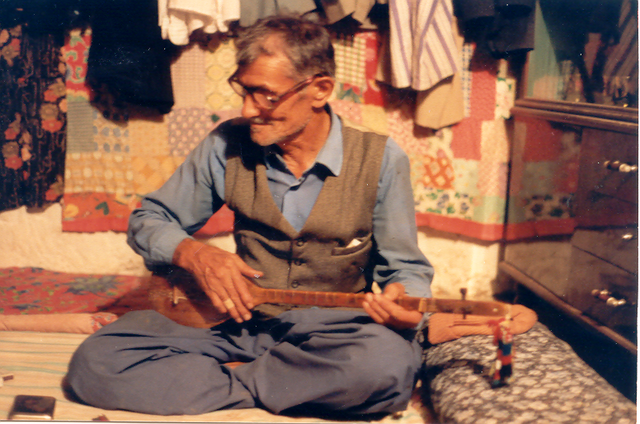
Figure 7 Mehmet Demirci (Köroğlu) is playing „cura saz”, the smallest three string”bağlama”
Düziçi lies in a green valley with tiny villages scattered on the hillsides around it. The lovely sight could not delight us long because it soon turned out that the permit from Ankara was not good enough. The amiable and compassionate local kaymakam or 'police chief' who was acting for his boss away in England sent us back to acquire a local permit from the Adana council. Going and coming there was a check point on the road manned by police with machine guns because of the Kurd separatists. As it was too late to arrange official things, we went back to our accomodations, the hostel of the university instructors. Typically for Turkey, teachers do not teach where they wish to after graduation. They are appointed officially to places, even to several places successively. The instructors while away time gathering in the groundfloor lounge in the evening, all clad in clean white shirts, drink immense quantities of tea, smoke compulsorily and play the game called tavla. Drinking alcoholic beverages is forbidden in Islam, but not everyone observes this rule strictly.
Next morning we launched the application at the governor's office and got it immediately stamped and signed. We walked over to the police station where the governor's permission, the Ankara permission and four photos proved sufficient to get the pass for the villages within an hour's time. In the afternoon we were again on the bus, heading for Düziçi.
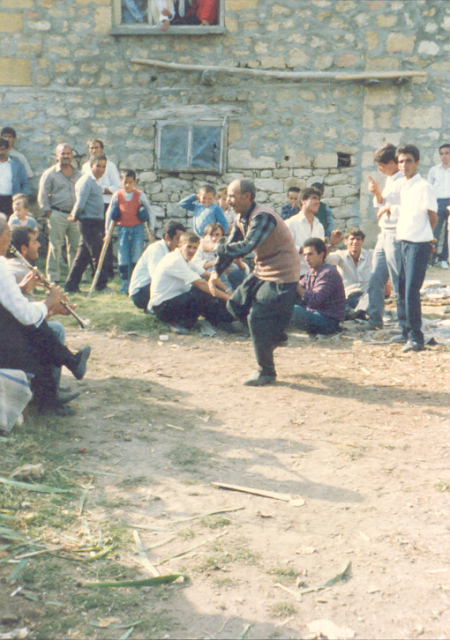
Figure 8 A man dancing in the interval of a wedding
We passed Yılankale 'Snake castle' and Toprakkale 'Earth castle'. The former earned its name for the innumerable poisonous snakes residing among its stones; the latter was the place where Bartók collected the first 'Hungarian-like' tune, № 8a. I was on my way to the venue of my first collection in Anatolia in bright sunshine, full of hope and expectations, but before we went to the nearby village of Gökçayır in a hired car, I got to talking with a receptionist lad who, hearing I was collecting folksongs, invited me to a düğün or 'wedding' the next day.
The epic singer Mehmet Demirci lived on the edge of the small village of Gökçayır. Mehmet bey, whose nom de plume was Köroğlu after a famous minstrel, had an immense garden and he lived by farming, but occasionally he performed hour-long epic poems at weddings for money. He welcomed us warmly, invited us into his house and listened quietly why we had come. We had dinner, chatted, and then, around 9 p.m., he got out his instrument, a cura, the smaller of the three-stringed plucked instruments tuned e1-d-a. He sat the tailor's way on the floor, which is quite natural as in Turkish village houses chairs or tables are rare, everyone sits on the floor. The wardrobe is replaced by nails hammered into the wall upon which the clothes, instruments or, for that matter, the very common guns, are hung.
The singer held his instrument loosely in his lap and struck the three strings with his fingers dynamically but lightly, so that the accompaniment was rhythmic rather than melodic. He performed the epic poems most emphatically, as in a trance, continuously telling and playing the stories from 9 to the small hours so that three one-hour cassettes were filled with text and song. He said he knew some fifty hikâyeli 'historical' songs by Karacaoğlan, a hundred by Köroğlu, and many more by other minstrels such as Elbeyoğlu, Âşık Halil, Deli Boran and Dadaloğlu. However, he presented all these innumerable stanzas to variants of a single tune and the number of musical interludes was also highly limited.
In the morning we walked into Düziçi to look for musicians. On the way, Mehmet bey put questions about Hungary, the world, and I realized that unlike the basaar people in Istanbul, simple Turkish people knew nothing about Hungary or the Hungarians. In Düziçi we went straight to the meeting place of zurna and davul players. We talked to a zurna player friend of Mehmet bey, but he wanted too much money for an hour's playing. We found someone with a motorcycle who took us to the musicians' neighbourhood but no one was at home, as all musicians had gone to a wedding. So we rode the small bus again to the location of the invitation we had received the previous day, to Karacaören.
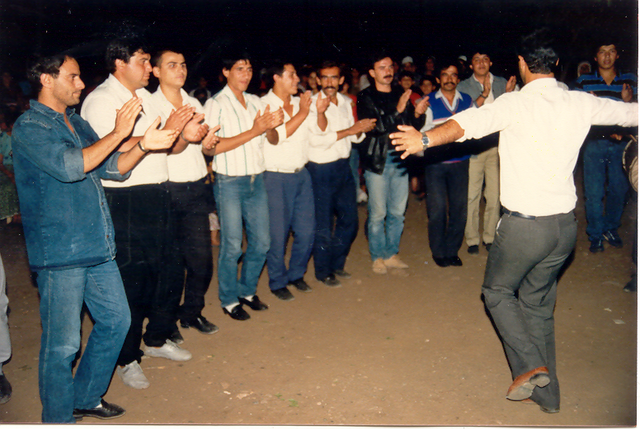
Figure 9 Wedding dance accompanied by zurna and drum in the village of Karacaören
The thumping of the drums could be heard from afar, followed a bit later by the tunes on the zurnas and the accompanying drone. It all became louder as we reached the house and turned into the court. The wedding had just started. We were welcomed with great affection, set in the place of honour and the musicians were ordered to come close. They played two dance sequences into the tape-recorder.
The musicians were Abdal Gypsies. The band was a family undertaking, headed by the father Çavuş Kapçak chief drummer and manager, with his sons Lisan and Nihat at the other drums, Durdu as a zurna player and a nephew, Yusuf, playing the other zurna. Only the oldest and best zurna player, İlhan Kaçmaz was not a family member. He was an extraordinarily talented musician, but the rest also played with delight and good musicality. The 'boss' only joined in in cases of emergency or for representation, there were always two drummers and two zurna players playing, the third taking a rest. The revelry was uninterrupted, the men danced in a semi-circle, the one at the side waving a kerchief. Just like in most parts of Turkey, dance sequences or halays were played and danced first by slow dances, followed by dances in medium tempo and closed by fast dances. After some halays a break ensued. On the roof of the low house there were tables at which we sat down. Soon the musicians began to make the 'table round'. The musician played the tune, then a singer started and when he finished, it was the turn of the zurna player and the drummer again. On the flat roof of the house the dance resumed, then a gentleman called Ömer Sert sang a song followed by a tune whose Hungarian analogy can also be made. Merry-making lasted until midnight, when all went to bed. We were put up in the house of Adem who had invited us.
After breakfast the next morning we took a bus through the small town Ellek to the village Küçük Akarca 'small stream' belonging to Osmaniye because, as we had learnt at the wedding, recently settled Yürüks lived there.

Figure 10 A recently settled Yürük man playing the flute
Figure 11 A musician from Uncalı with a three-stringed violin, which he plays in the traditional vertical way
Figure 12 Hasan Küçükkuş playing the kaval
We stopped by the tea-house of Ellek to get information and learnt that the road to Akarca was only negotiable by jeep or tractor. Fortunately, we found someone to take us on his tractor. We crossed a lovely mountainous green countryside again, seeing ground-nut harvesting on the way, while the tractor crossed ravines and gullies and rivulets bravely. Having climbed a hill, we at last caught sight of the settled Yürüks, including the father of our tractorist. These blond and blue-eyed people brought out chairs for us, offered tea and slowly the coversation started. Whether they had kaval or other instruments? No, they didn't, but if they had, they had long forgotten how to play them. Then, almost accidentally, a flute was produced, then another and another one. Then a reed-pipe followed. Musa Koca, our host, began to play, and eventually about an hour's recording was the outcome. I was sent on to the village of Bıçaklı, where they said there was a kaval or 'long flute' player. Darkness fell, there was a bushfire on a faraway hillside, and we descended to Bıcaklı right to the house of Süleyman Halıl bey, another recently settled Yürük. After the compulsory chat of an hour or two for acquaintance, Süleyman bey saw me to his friend Arap Hüseyin who also played the kaval. Then they both played. Hüseyin's kaval was of metal, Süleyman's of wood. The instruments are stored in long wooden pipes covered by ornately embroidered kilims which are held in high esteem and reluctantly given away. After the collection, we slept on the porch while the voluminous household, some twenty people slept in the only room of the house.
The customary meal ensued in the morning: white salty cheese, olives, bread, butter, tea, all on the tray put in the middle of the room on a cloth. The men squatted by the tray sitting on one leg and crossing the other in front of them and sticking their feet under the cloth. The women served the food, passing the bread round, filling the tall slender tea glasses again and again. After breakfast we joined the women and men on the platform of a truck up to the main road, from where an old car took us towards Toprakkale. We saw tents of nomads by the roadside. In the first kara çadır 'black tent' there was only an old nanny with some children, and she refused to sing. We don't know anything any more, she said, but when I played to her the tunes played by Musa Koca the previous night, she was apparently moved. We went over to a small camp of three tents nearby where the nomadic Veli Sarısoy lived, who sang us two tunes. Fortunately Ayşe also appeared who knew the tunes and technique of boğaz havası or 'guttural song'. While performing boğaz tunes, the singer vibrates her throat with her finger, thus rhythmizing the long notes. We then returned to Adana, and in the afternoon I was on the Mavi tren or 'blue train', headed for Ankara.
That was my first collecting trip in Turkey, the shortest of all and the least experienced, resulting in the least recordings, but being the first, remaining the most memorable. I managed to record epic songs, and wedding tunes, I met recently settled and still nomadic Yürüks, and gained innumerable useful experience I could put to good use during my next trips. In Ankara I reported in the Folk Music Research Institute about my work, started transcribing the tunes and began preparing for the next journey to the area of Kozan in November.
Figure 13 The nomadic woman Ayşe singing a boğaz tune in her tent
Figure 14 Ali Kurt and the author in front of Ali's tent

Figure 15 Looking out of the hut
Folk music in today's Turkey
Turkey is a dynamically developing country with huge road constructions, an advanced telephone network, television and radio broadcasting reaching everywhere. No wonder the role of folk music is being pushed into the background. Large quantities of cassettes by professional and semi-professional folk music performers are sold, which often contain folksongs but in a more artistic version, more or less orchestrated, in a timbre that is alien to folk music, performed in an overall metallic timbre and with uniformized ornamentation. The masses of people flooding the towns from the countryside have also produced a popular art music style recently, the so-called arabesk. This genre is characterized by overinstrumentalized, syrupy tunes based on Arabic urban music containing the compulsory augmented seconds galore, and the passionate, mostly amorous or longing texts.
At the same time, in small isolated villages, folk music seems to perform similar functions as centuries earlier. Before my first collecting trip many colleagues including ethnographers tried to persuade me that the lament did not exist any more, and if I were to find anyone mourning for the deceased in the traditional way, I would not be able to record it. That is not true: the dead are mourned in the ancient manner in many villages and not only according to the religious ritual. That also applies, for example, to a teaching couple in town. When I was there, the wife's mother died. The religious ceremony was followed by the ancient lamentation on which ordinary people insist even in the capital city of Ankara, as I could hear and even record it.
Naturally enough, folk music in its purest form has survived in small villages way off the busy roads. It is indeed shocking to experience the difference between the southern seashore lined with luxury hotels fitted out for the entertainment of tourists and the meandering roads in the Taurus Mountains, leaving behind the 20th century by centuries. One can sporadically come across nomads who set out in spring with their livestock towards the summer pastures, only to return in autumn to their winter abode along the warmer seasides. True, they mostly transport their animals to the distant pastures by lorries. Those who have become sedentary remain conscious of their clans for long and do not forget their tunes or their customs either. They no longer set out for the summer pastures far away, but many villages have their yayla or 'summer residence' nearby and those who can afford it retreat there from the scorching heat of summer.
The richest treasure trove of tunes is always a wedding when many tunes and songs can be heard. The women gather on the eve of the wedding to take ritual farewell of the bride on the night of the rubbing of the henna.

Figure 16 The author and his wife
After the tunes of the bride's lament, revelry of dancing ensues when they usually accompany their singing by drumming on a pot. The bridegroom's way to the bride's house is also accompanied by music. There is a separate song for the arrival of the bridegroom, the bringing out of the bride, and earlier a separate song was sung when the bride was sat on the back of a horse or set out on her way, etc. Not all these customs are still alive, but the tunes are preserved in the people's memory.

Figure 17 One of my Turkish escorts mounting a camel with a typical Anatolian scenery in the background
During a wedding lasting two or three days, the music by the davul and zurna or 'drum and Turkish flute' is played incessantly. The musicians are usually Gypsies from the Abdal tribe who play the resounding zurna and drum in the open, and a three-stringed plucked instrument and the small drum deblek indoors. More recently, some Gypsy musicians use the clarinet or the violin in place of the zurna at places. The smallest band contains two: one piper and one drummer, but the two pipers - two drummers ensemble is more frequent. At richer weddings even three of both instrumentalists are hired. The tune is usually played by one piper, while the drone — the sustained base note — is played by the other.
Figure 18 Alevi musician playing 'samah' melodies on bağlama
The uninterrupted sound so typical of the zurna is achieved by taking breath through the nose and while breathing, the air stored in the cheek-pouches is pressed into the instrument. Thus, the sound is not broken for a moment. The drummer himself often joins the dance.

Figure 19 Two kaval players
These professional musicians are often in similar life situations to the Hungarian rural Gypsy musicians. They often live in closed colonies on the peripheries of villages or towns, but I visited villages inhabited solely by musician Gypsies. Most of them have a stunning mastery of their instruments; they know the traditional repertory well but readily communicate new tunes as well. The musicians play dance cycles or halays of 20-30 minutes each during dancing occasions. The cycles begin with slow dances and the tempo gradually increases. Apart from the asymmetrical rhythms of 5/8, 7/8 and 9/8 also found in vocal music, immensely sophisticated rhythmic patterns can also be found in dance music. The halays may be interrupted by singing between dances: the dance may stop, the men go to have a drink by the table and burst into songs to the accompaniment of the musicians. Today it is very rare that an epic singer who can sing thousands of strophes from epic poems is invited to a wedding. Many poems by folk poets are alive and sung by the people, but the folk singers or âşıks perform such songs accompanying themselves on some plucked instrument during a feast, and they also stage competitions among themselves.
Bowed instruments are only used by professional musicians, at least in our days. As the sources reveal, earlier there were three-stringed bowed instruments of uniquely carved forms, tuned d1-a1-d2, but they disappeared. Only the instrument called kemençe used by minorities around the Black Sea remained. The old stringed instruments were replaced by the violin held to the chest by some musicians as Hungarian folk fiddlers do, and vertically leant against their knees by others. The tuning of the fiddle, similarly to the ancient strings and today's kemençe, is g-d1-a1-d2 that is, lowering the violin's e string by a major second.
Among plucked instruments, the bağlama family with thrice double strings is popular among both village and town dwelling Turks. The smallest member of the family is the cura, the medium-sized is orta, the largest is âşık or kaba bağlama. The two most frequent tuning (düzen) types are bağlama düzeni: e-d1-a1 and kara düzeni: g-d1-a1. There are many other kinds of tuning associated with certain regions, and even to certain tunes. The tune is typically played on the upper string by the thumb, and the main accents of the rhythm are drummed by ring finger or the ring and middle fingers of their right hands on the board.
The bağlama instrument family is particularly noteworthy because it has frets which may decide upon the dispute on the exact places of Turkish microtones. It can indeed be declared that, by stopping the strings at the 2nd and 6th degrees of the scale with a minor third, one gets tones whose pitches are between the major and minor second and the major and minor sixth, respectively. When, however, they accompany their singing on the instrument, one often experiences that they sing these degrees elsewhere, 'more clearly' than the instrument's sound. It can also be observed that even within a single village, these frets may be at slightly different places on different instruments, which is understandable as these degrees are generally the hardest to intone.
The winds are frequent among the people. Many villagers have sipsi 'flute', and the reed-pipe 'düdük' is also often seen. The tulum 'bagpipe', however, can no longer be found anywhere but the shore of the Black Sea, similarly to the three-stringed bowed kemençe. Kaval is a typical Anatolian instrument whose fizzling tone is accompanied by a mobile drone hummed just like Hungarian flutists do in Transylvania or Moldavia. In Moldavia even the name of the instrument is kaval.
Figure 20 Abdal musician plays the violin

Figure 21 A Turkish rural band with clarinet and violin
Analogies between Anatolian and Hungarian melodies
When systematizing the Turkish material, Bartók first set aside the parlando and tempo giusto tunes. Within the parlando tunes, he separated the isometric, the heterometric ones and those in dotted rhythm. In the resulting groups, the tunes were first arranged by syllable number, and within a group of identical syllables, by rising cadence.
The smallest units were the clusters of variants containing tunes of nearly identical syllablic and cadential patterns. The system ended with the prayers for rain, the tunes with undefinable structure and the 'dubious' tunes, as well as the instrumental pieces.
A study of Bartók's musical classes prompts several questions. Is there any musical connection between the parlando and tempo giusto tunes? Can the rare three-line and heterometric forms as well as the structually undefined tunes and those with 'dubious' origin be interpreted differently? Do the tunes in dotted rhythm really stand off from the rest of the classes in Turkish folk music? And also, could the material be systematized by other criteria which might reveal at least as profound interrelations as Bartók's among the Anatolian tunes themselves and point out their connections with Hungarian folk music?
Several attempts have been made after Bartók to classify the Anatolian folk material, but they have not been convincing. Saygun also proposed modifications to Bartók's system, concerning fundamentally the category of “structurally undefinable tunes and those of dubious origin”, and in a few cases, a different definition of the melodic structure. László Vikár systematized other Turkic (Chuvash and Tatar) materials but the principles of categorization used there cannot be adopted since the character of Anatolian tunes with typically conjunct musical motion deviates largely from the pentatonic tunes of a far higher degree of freedom in their motion.
I have also systematized the Anatolian tunes I collected. The detailed description can be found in my books and PhD dissertation.30 I subsumed the tunes into six large blocs of differring significance. Of these, I am going to present the first bloc of Turkish tunes and its relations with Hungarian and other peoples. The rest of the tune blocs, classes and types are only touched on when some reference to Hungarian music is made.
Before embarking on the tunes of this large music bloc and its Hungarian analogues, it is worth giving thought to some problems of comparative musicology. Apart from formally analyzing and comparing the folk musics of various peoples, ethnomusicology tries also to infer historical conclusions from the established similarities or differences. The first main problem of comparison derives from the need for a sufficient amount of reliable, comprehensive publications of possibly the same principles, which in most cases are lacking.
The second problem comes from the recognition that the stylistic connections between larger blocs of tunes rather than indiviual tunes should be compared. There is no elaborate standard system for the classification of various kinds of folk music by style; quite to the contrary, it is prevalent to maintain that every material proposes the principles that should govern its systematization. The comparison of materials arranged by different principles can, however, be mind-boggling.
This difficulty in the Hungarian-Anatolian comparison poses little concern because, on the one hand, there are large amounts of reliable data available on the folk music of both, and on the other, the existence of similar styles allows for the parallel discussion of the two materials. By contrast, the materials of other peoples often only referred to in the comparison are far less voluminous, reliable or systematized.
That said, there still remains a theoretical problem with the Hungarian-Turkish analogies: What historical conclusions can be drawn from the similarities of the musical styles of different peoples? There is no definition of the extent and nature of musical similarity that sufficies to prove genetic connections. Apparently, with ethnic collectives that parted in the far past, different forms could evolve from an identical musical idea, or, to put it in another way, very different musical forms can have derived from identical musical roots. Apart from divergent development, convergence may and does appear in the course of which similar structures arise in the music of people that have never had any contact with each other.
The similarities demonstrated in the material at hand do not therefore prove – nor do they disprove – a common origin. What seems probable is that in music, just as in linguistics, complete identity affecting every tone speaks more strongly against, rather than for, a common origin. Similar phenomena can arise independently, and may develop further via borrowing or retake. For want of written documents, ethnomusicology has few reliable tools to retrace the early states and developmental processes. Let me briefly refer here to Zoltán Kodály's statement: „[...] Neither the Hungarians, nor any other peoples with whom the Hungarians came into contact in the 5th-15th centuries have passed down a written record of music of even a single note from that time.”31 Moreover, the sporadic records that might be found must be handled highly critically for a few notated tunes do not suffice to infer conclusions as to the whole of the contemporary folk music instead of the collector's attitude towards folk music.
In spite of all that, it is certain that some layers of folk music are astonishingly persistent in withstanding permanent transformations, or even with their help, major musical styles preserve their fundamental traits. Although there is no possibility of verifying thousands of years in the past, lesser or greater degrees of probability can be hypothesized, especially when regular similarities of complex, intricate phenomena are observed. As Kodály said of Hungarian folk music: „[...] As our language records reveal, our language has hardly changed over the past four hundred years. Why ought our music to have changed then? It is not exposed to any official or eroding influences as the language is. If the contemporary language of the people is so close to that of the codices, it can safely be assumed that the musical language of the people is even closer to the musical language of the age of codices.”32 Thus, when considering the following analogies, a degree of uncertainty must be reckoned with, in addition to the more emphatic position that more or less similar styles are not taken for identical but musically similar.
After this lengthy introduction, let us now embark on the subject-matter of this study: the similarities between the Anatolian and Hungarian folk musics.

Figure 22 Dance in the wedding
Realizations of the G-(F)-E-D-C nucleus and the related tune types
This bloc of tunes containing important archaic forms of Turkish folk music with remarkable relevances to Hungarian music is outstanding both in volume and significance in the Anatolian material. It contains various realizations of the G-(F)-E-D-C core, sometimes expanded, as well as other integrally related tunes. I subsumed here the diatonic laments with relation to the laments of a pentatonic nucleus as well as tunes of a wide scale segment whose nuclear idea is no longer purely G-E-D-C but can be closely tied to the psalmodic tunes of G-E-D-C centre. This bloc includes the following musical classes more or less connected by musical criteria as well:
1) Twin-bar types with G-E-D-C nucleus,
2) Turkish and Hungarian pentatonic and diatonic laments,
3) Turkish and Hungarian psalmodic melody style,
4) Disjunt tunes and types with 5(5)b3 cadences and AAAcB formula,
5) Wide-range parlando types.
Let us take a closer look at these Turkish melody classes and their relations with similar Hungarian and other folk tunes.
Twin-bar tunes of G-E-D-C core
Although neither Bartók's collection nor mine contain many of the twin-bar tunes with G-E-D-C nucleus, these are wide-spread all over Turkey. On the basis of their finals, they can be divided into three groups: tunes with C finals, those ending on D and the rest ending on E. The major difference between the three groups is that while the tunes with do finals are mostly descending, the ones that end on D or E rotate around the final notes.
Twin-bar tunes ending on C
The twin-bar tunes of G-E-D-C core ending on C can be found nearly everywhere in Turkey, most of them in the eastern areas where Kurds also live and where they form a homogeneous melody type. In Bartók's collection the prayers for rain № 49 (ex.1a) moving on the D-C bichord and № 49a (ex.1b) covering the trichord E-D-C belong here. I have also collected similar rain prayers.
The twin-bar Anatolian tunes with C finals can be divided into three groups on the basis of the motion of the melody and the tones applied. Of these, the tunes expanding downwards, moving in the lower reaches of the tonal set of E-D-C-B-A-G of a plagal character do not constitute a really homogeneous type. I only have two tunes of the kind: a unique lament for a bride and a similarly unique dance tune. The latter is shown in ex. 2.
The main lineament of the other group ending on C is the powerful use of F, or the sixth degree. It is noteworthy that the C-ending tunes with a strong presence of the 6th degree can also be interpreted as ending on G, and then they can be written as G-C-B-A / A-B G. I have one tune in my collection, but this kind is generally rare in Anatolia. Let me illustrate this kind with a specimen with a remarkable refrain in which the original seven-syllable pattern expanded to twelve and thirteen syllables (ex. 3). This also confirms that genetically identical tunes may get very far apart in a system when grouped by syllable number.
There is a twin-bar tune type ending on C whose importance and frequency promotes it to the rank of a tune layer. Not only do Bartók's Anatolian collection and mine abound in it, but very many tunes of the kind can be found all over Turkey. Cadences on E or wavering between E and D, the nucleus of E-D-C and the narrow pitch contour unite these tunes convincingly despite the different heights of the lines. The progression of the melody actually only differs in the C-D-E, E-E-E and G'-F-E incipits. It deserves special mention that many of these tunes are nothing else than the first two lines of four-line psalmodic tunes. Among the following examples, ex. 4a is seemingly four-lined but its AB/AvB form is a paragon of the tunes of twin-bar character organized mostly in two lines. The first line of ex. 4b recites on the fifth degree, the second line is extended, and the tune closes with a refrain. In the third example the 7th degree also appears, with the 6th degree only playing a passing role (ex. 4c). Despite the divergences of varying extent, each tune displays clearly the E-D-C twin-bar core.
In Turkey there are several other types organized on an E-D-C centre, missing from my collection. I collected several tunes realizing the G-E-D-C nucleus in a descending progression, which will be shown in detail later when discussing the descending laments.
Twin-bar tunes ending on D
Although in Turkey the role of twin-bar tunes of the G-E-D-C-(B-A) notes with D finals is smaller, they also outline some distinct types. Two of these need to be stressed.
The one- or two-line type, every line ending on D, has its first line usually rotating around G-E-D-C-(B), and sometimes descending from the 7th degree, launching the rotation around the D note in the second line. Ex. 5a is such a tune descending in the E-D-C range. The essential part of the tune is in line two, also borne out by the fact that in performances, the second line is stated disproportionately more frequently than the first. Ex. 5b is an extended tune. Its first two lines meander rather aimlessly, before reaching the refrain to which they serve as introduction, so to speak.
The small tune type of two musical ideas ending on E in the first and D in the second line also plays an important role throughout Turkey. One example represents it in my collection, shown in (ex. 6).
Twin-bar melodies with E finals
My collection contains no twin-bar tune types with a G-E-D-C core ending on E finals, but there are many tunes in Anatolia that are constructed from a central G'-F-E-D tetrachord. Their idealized scheme is shown in ex. 7a. Just as important is the E-ending two-line type whose tunes of a broader tonal range ending on E or D use the notes (G-F)-E-D-C centering around D. A summary sketch of these is shown in ex. 7b.
Similar twin-bar tune types of other peoples
As is well known, the D-C bichord with the major second sporadically occurs in Hungarian, Turkish and many other folk musics.33 At the same time, the G-E bitone of a minor third interval so decisively important in Hungarian children's songs and the tunes built from the tritone G-A-G-E (= C-D-C-A) are practically absent from Anatolian folk music. The only Anatolian tune of such notes that I know of is Bartók's № 49d with the E-A'-G'-E (= A-D-C-A) core. The next example shows it with a Hungarian counterpart (ex. 8a, b)
By contrast, the tunes rotating around the E-D-C notes and ending on D are just as frequent among Anatolian children's songs34 and other simple Turkish tunes as among Hungarian children's songs.35 No far-reaching conclusions can, however, be drawn here because this nucleus and its typical variants appear to be a somewhat primeval general musical manifestation. „[...] This type of tune can be found in other people's music as well, for example the German children's songs or the music of the Paleo-Asian peoples. It is none other than the E-D-C trichord nearly always ending on its middle tone.”36 Turkmen, Iraqi and other tunes could also be adduced.37 It is, however, important to note that this kind of tune which is so frequent in Hungarian and Turkish folk music as children's song as well as tunes of fertility rites and warding off malefic spells, can be found very rarely in the folk music of Hungary's neighbours and in German children's or occasional songs. Let me show two Anatolian and two Hungarian children's tunes of the kind (ex. 9a, b)
Another form of the G-E-D-C-(B) nucleus is frequent in the musics of a variety of peoples: the first line of these descending melodies with C finals end on E or D. Its tempo giusto variants include Hungarian children's songs and tunes from East-Anatolia. As will be seen later, several peoples use this core in their laments. In the next example, the scheme of this type is sketched (ex.10).
Hungarian and Turkish laments
Bartók often complained that he could not collect music from Turkish women, although, in fact, he gathered a total of 13 tunes, that is, 15% of the Anatolian material he published, from two Turkish women. So far so good, but he met the two singers in Ankara, the capital city, and therefore he did not deem them completely reliable. The majority of these tunes, however – as Bartók himself noted – seem authentic, and what is more, his № 51 is none other than a real lament tune spanning the G'-F-E-D-C major pentachord resting on D and C, with the notes remaining somewhat vague in pitch, typically for the lament style. Especially the last note, C, is intoned by the singer sometimes lower, sometimes clearly B, as is often the case with many other Turkish laments, and as can be made out from Bartók's transcription too (ex.11).
Hungarian laments
There is some disagreement among Hungarian researchers about the core of the small form of the Hungarian laments. Lajos Vargyas derives the small form from the E-D-C nucleus. He argues that in the course of development the cellular E-D-C gradually expanded upwards across F and G' to the major hexachord, as well as downwards two or three notes: „[...] the Hungarian tunes are clearly the improvements of the major third (major mode) core expanded to tetra-, penta- and hexachordal ranges.”38
László Dobszay, by contrast, derives the Hungarian lament style from a minor third nucleus: „[...] So it seems that a certain more distinct melody cell can be gleaned from the material which unifies the most different types. This formula of lament tone most frequently takes the form of a minor third recitation whose fourth below the sustained tuba note (major second below the resting main note) functions as an alternative cadence. The regular alternation of the two cadences (2-1 counted from the side of C or 1-VII counted from D) are not essential traits of the model; though the D-C sequence (or several D's followed by C) can be explained psychologically, the opposite can also be exemplified [...] This pattern is the melody cell of the small form all over the country.”39
Another definition ought to be cited here: „[...] The core of the Transylvanian lament tune is a E-D-C tritone, which can extend upwards and downwards, making up an A'-G'-E-D-C-A-G scale. Its motifs are mainly descending, with a few convex arches. In some cases, the E-D-C cell and the ensuing descent, the high dramatic beginnings and the high recitations get incorporated in the lamenting process in an almost didactical way.”40
The Transylvanian pentatonic small form and the varied but cellularly unified main types of the country do not represent different worlds. „[...] Apart from the general features of laments, there are some coincidences of basic motifs, hence the two areas must be preserving dialects of a common root and divergent development.” 41
When defining the Transylvanian lament, various positions tally. At the same time, the Transylvanian form of the lament cannot be sharply differentiated from the general Hungarian small form. In Transylvanian small forms notated as C-B flat-A-G-F the A notes are not exceptional, although they are sometimes 'disguised' as glissandi or grace notes in the transcriptions. Their scale may as well be conceived as G-(F)-E-D-C, which only deviates from the national core pattern in the slightly smaller role of the e note (as László Dobszay argues). In another group of Transylvanian laments based on the G-(F)-E-D-C nucleus F is also present, though with a smaller weight. Sometimes the only difference between some tunes of the Transylvanian small form and the general Hungarian small form is that E plays the more important role in the Transylvanian ones and F in the national diatonic forms, the rest of the features being completely identical.
Anatolian laments
The general structural features of the small form of Hungarian and Turkish laments are almost identical, with the only difference that the Turkish tunes never extend down to sol and when reaching downwards to A, a B/Bb note nearly always enters. Apart from structural likenesses, the tunes also display similarities in their minute details. In addition to the motifs using G-E-D, both peoples use tunes declining from F (or G, even A') to D in a waving motion, as well as lines sinking to do more or less parallel with the former in motion. This descending recitative form with G'-F-E-D-C centre and two cadences (D and C), and at times with an additional C-B-A decline is the prevalent lament in all the Anatolian Turkish area I have visited. The same melody pattern can be found in bride's laments and lullabies usually belonging to a layer of old tunes, and a form favoured by men who do not sing laments can also be convincingly derived from it.
Just like the Hungarian small forms, the Turkish laments have several layers. The core of lots of Turkish laments is of a pentatonic nature: (A'-G')-E-D-C + (B-A), while there are some in which F plays an important role: (A'-G')-F-E-D-C + (B-A). These tunes, however, appear to be various dialectal variants of one and the same musical idea rather than different developments. Their most common rhythmic scheme is the eleven-syllabic pattern divided into 4/4/3: ![]() but it is almost compulsory to deviate to varying degrees from it, mainly towards extension, during the performance.
but it is almost compulsory to deviate to varying degrees from it, mainly towards extension, during the performance.
Turkish laments can be grouped by their nucleus (whether built of one or two musical ideas), the internal cadence formula and the notes used. Let me review them from the point of form (number of musical ideas involved), illustrating them wherever possible, from the simplest ones built from the C-D bichord through the nuclear E-D-C trichord-based ones and laments with a (A)-G-E-D-C kernel of pentatonic character to those of a diatonic layout based on a penta- or hexachord and using the f note a lot. In the latter, F often sounds hesitant, at times intoned more or less like F#.
Anatolian laments built from one musical idea
Naturally enough, the single-core lament type contains the simplest formations. The last note of the musical lines (C) may display a C-B duality with a downward trill, and in some tunes B is clearly intoned, but the place of these tunes in this group is unquestionable. In the knowledge of the rest of the Anatolian laments this B final must be interpreted as the lower intonation of C—its ornamenting downwards. On the basis of text and performance, these one-centre tunes can assume various forms: some have a cadence in every third line, the other alternates the cadences at the end of the third and fourth lines, or again, some close off every line.
The simplest form in the simplest type is built from the D-C bichord (ex.12a). Several single-core laments use the E-D-C or E-D-B trichord, e.g. ex.12b is based on E-D-C and ex.12c on E-D-C/B. Apart from the dominant notes of the E-D-C trichord, G' and even A' may flash up for a moment quite often (ex.12d). G' may also take on a role equal in rank. When there is no F in the tune, the lament assumes pentatonic character (ex.12e). In ex.12f I show a similar Hungarian lament.
F also often appears, but mainly in the role of a passing note of secondary importance (ex.13a). It is neither quite rare that F is a note of equal value, when the central idea of the lament becomes F-(E)-D + C as defined by László Dobszay (ex.13b). Laments built from a major penta- or hexachord, however, are far more typical and common (ex.13c). Ex.13d is a similar Hungarian lament.
Similarly to Hungarian laments, Turkish laments also include tunes based on a single musical idea that contains a single line ending on D. Such a melody line is normally built of very few notes, the G-E-D-C#(!) tetrachord in ex.14a, the E-D bichord in ex.14b, the G'-E-D trichord in ex.14c and the E-D-C trichord in ex.14d. As for ex.14e, all its lines end on do, but to close off larger units, the singer also sings a D note. Ex.14d is a Hungarian lament of this type.
Anatolian laments built on two musical ideas
The two-core tune type contains melodies made up of two different musical ideas. Apart from laments, lullabies, wedding and religious songs belong here. In tempo giusto songs the octosyllabic line divided 4+4 is frequent, while in longer, 11-syllable parlando tunes the division of the music as well as text upon the 4+4+3 and less frequently 6+5 patterns is most prevalent. In these tunes, a line or two ending on D cadence is usually rounded off by a melody line with a C final, but in the cadences of the lamentation the D final is not infrequent, either. This is exemplified by the octosyllabic ex.15a where the alternation of D and C line endings is finally terminated by a final D. The tune is, by the way, a variant of the tune of ex.15c with a C final, here ending on D. The bride's farewells ex.15b and ex.15c are close variants of one another, finely illustrating the exchangeability of starting a tune now from high, now from low. The lullaby ex.15d verifies that a typically giusto musical form can also assume a parlando form in performance. Ex.15d is a similar Hungarian lament.
Ex.16a starting on re, ex.16b descending from so, and ex.16c reciting E are eleven-syllabic, but the E-D-C nucleus and the D-C cadences tie them closely to their variants of fewer syllables. Similar musical motion on basically restricted to E-D-C characterizes ex.16d as well, a song of the Alevi religious order. Although in Anatolian folk music giusto performance is customarily associated with fewer syllables and parlando-rubato performance to lines with more syllables, one can find eleven-syllabic tempo giusto tunes as well (ex.16e). Rarer though, but the lower intonation of the final C also occurs in this group of tunes with two musical ideas. Special attention is to be paid to ex.16f, as in this lament F assumes a significant role. Ex.16g is a similar Hungarian lament.
A review of laments immediately reveals that many are built almost exclusively from the notes of the E-D-C trichord (ex.16a, d). F may enter as a less important note (ex.15d) just as G, the latter far more frequently. It applies to all that G is an equivalent note, extending the scale into one of pentatonic character (ex.15b-c, ex.16b), and even F may function on par with the rest of the notes (ex.17a-b). Laments with two different musical ideas of a major penta- or hexachord are also frequent (ex.16f, ex.17c). Eleven-syllable laments with a D final after the C cadences can also be exemplified (ex.17d).
Single-core Anatolian laments with cadential descent
The lament tunes outlining the scheme of 'one idea + descent' display close resemblance to the tunes of the above types, but the single melodic idea here is closed with an additional descent. The group mainly includes plaintive songs (uzun hava), with a few lullabies. While the former types are sung by women, these are performed by men, hence the ornamentation is often more elaborated and the tonal range is wider. The lower intoned C at the end of a line can also be heard here (ex.18a). Ex.18b only sinks to Bb, in lines 1, 5 and 6 of the six lines. The closing line of ex.18c sung to padding words can be conceived both as an appendix and as a separate musical line. Ex.18d is a similar Hungarian lament.
These melodies show an almost note-for-note correspondence with the single-core lament tunes above. While, however, the respective laments end on C, these tunes descend to A with the help of padding words, after a rest on C. Prior to this final descent, many tunes build exclusively from the E-D-C trichord (ex.19a-b), but the tone set of a major penta- or hexachord is more typical (ex.19c).
Anatolian laments with two musical ideas and a cadential descent
The tunes of the 'two kernels + descent' type are similar to the ones outlined above, with the exception that the main cadence is D or E. Depending on the place of the main cadence, this type can be divided into several subtypes.
In the first, the main cadence is D and the additional descent is as above. Apart from several lament tunes (ex.20a-b), the uzun hava group (ex.20c-e) also belongs here, which already suggests the transition from a simple musical thought and structure to songs of larger scope. Ex.20f realizes a similar melodic idea over an especially wide range, spanning the interval of ten notes.
With some tunes, the end of the first line rises from D to E, but the tune does not change essentially (ex.20g).
Sometimes, the first line may clearly end on E. In these parlando tunes, the first line does not decline hesitantly to the 5th degree but descends upon it distincly to rest there (ex.20h). A similar melodic idea is manifest in ex.20i, but the lengthy stay at the 8th degree differentiates this melody from the small-range tunes.
In terms of scale, the simplest form of these tunes recite the D-C bichord (ex.20c). Many tunes only use the E-D-C trichord prior to the descent (ex.20a), with F/F# entering into several tunes—though in a secondary role (ex.20d-e). Sometimes G is an equal note to the rest expanding the scale towards pentatony (ex.20b), but laments of a major penta- or hexachord in their first part are more typical (ex.20j). It is not exceptional for melody lines to close on E and C (ex.20k). Ex.20k is a similar Hungarian lament.
Strophic tunes developed from the lament
The last line of some Anatolian tunes evolved from a C-B-A cadential descent, and may be conceived as AABC or ABBC four-line forms (ex.21a). Ex.21b, however, clearly points towards the psalmodic tunes. Ex. 21 is a similar Hungarian lament.
Anatolian laments in minor and Phrygian modes
Similarly to the Hungarian small form, the Turkish parlando tunes also have some bicadential tunes with minor and Phrygian characters. The second line runs more or less parallel with the first a tone lower, but the notes used are not G'-(F)- E-D-C but E-D-C-B(Bb)-A. In Anatolia, the laments with D and A cadences are far less wide spread than those of the E-D-C centre. Most of the songs belonging here are love songs (ex.22a, b) while in Hungary they are laments, which are rare in Turkey (ex.22c).
As rare as the Turkish lament in a minor or Phrygian mode is, so frequent is the type that descends again and again on a scale with minor thirds. This descent may start from various pitches and may apply to different syllable schemes, but when the start is very high, a short rise usually introduces itself (ex.23d). Not only laments display this pattern but also several maiden's farewells (ex.23a) tied to laments with a lot of threads, lullabies (ex.23e) and even love songs (ex.23b). Ex.23f is a similar Hungarian lament.
Large forms developed from the small-form of the Anatolian lament
In Turkish folk music I have not come across laments whose overall forms were similar to the large forms of the Hungarian laments, but I found a few musical patterns that were more or less similar to some tunes in the strophic stock derived from the large forms of Hungarian laments. This analogy is not a strong stylistic similarity between a Turkish and a Hungarian folk music layer, since the Turkish examples are very few and only analogous with the Hungarian tunes with 5(4)b3 cadences, and their melodic progression also deviates from the most typical Hungarian tunes. What is more, as the cadential series reveals, these tunes are in part psalmodic and in part sequentially descending, and some even display lower fifth-shifting segments. Such Turkish tunes include, for example, ex.24a-b with 4(b3)4 or 5(4)x cadences. For the sake of completion, let us see two relevant Turkish tunes (ex.24c-d), but it must be stressed that the cadential schemes of Turkish laments constituting larger forms is much rather (b3), 5(b3)b3 and 7(b3)b3, hence they are to be discussed in more detail in the chapter on the psalmodic style.
Finally, let it be noted that tunes № 5, № 6 and № 15 in Bartók's collection are similar to certain large forms of Hungarian laments, and so, with a lot of goodwill, one can set more or less similar Hungarian tunes against them (ex.25).
International relevances of Hungarian and Anatolian laments
The international connections of the Hungarian lament style have been summarized by Lajos Vargyas and László Dobszay.42 They reviewed the accessible stocks of European folk musics in search of tunes with similarities to the Hungarian laments, and Dobszay also surveyed Gregorian music. The findings can be summed up as follows: the Slovaks have a similar small form that is a Hungarian borrowing, as historical sources prove; among Rumanians, laments with two cadences —D-C— and some of Dorian-Phrygian characters with VII as the main cadence are also found, in addition to the simple single-core F-E-D-C laments. In addition to these, pentatonic lines resembling psalmodic tunes as well as Mixolydian types stressing the tritone are also frequent. In Serbian and Macedonian folk music, tunes of similar character also crop up although their forms mainly consist of one or two lines; while in Bulgarian folk music this laments form a well-developed musical style, consisting mostly of strophic tunes with shorter lines. Similar tunes can be found in the folk music of some other peoples, too: sporadically among Sicilian, French, German tunes in the form reminiscent of the small-form, and among the Spaniards in a more sophisticated bicadential form with a Phrygian descent at the end. The tunes of the Nordic collections (Anglo-Saxon, Irish, Scottish, Hebridean, etc.) are so different in nature that the style cannot be expected to be found. At the same time, some modes of the Gregorian are closer to the Hungarian lament style than are any of the above groups of folk music.
Apparently, the melodic idea represented by the small form of the Hungarian lament appears among several European or extra-European peoples either sporadically or as elborate rich styles. That may suggest a universal primeval source of origin, whereas it is perfectly absent in the folk music of some peoples—true, there is no knowing whether they had it in days of yore or not.43
In the opinion of László Dobszay „[...] we should practically localize this musical language to the southern zone of Europe, regarding the analysed styles as divergent successors of a melodic culture in the Mediterranean strip turning a bit northward at its eastern end.”44
Tunes belonging here have been found among Vogul, Ostyak, Finnish, Estonian, Caucasian and some Turkic peoples, as well as the Slavs, but, on the one hand, the reviewed collections cannot be taken for complete, and, on the other, relevant publications are missing with some peoples altogether. In Dobszay's view, the available data suffices to permit the assumption that the roots of the lament go back to the Ugrian age, but he deems further research necessary.45 Vargyas takes a firmer stand on the Ugrian origin of the lament.46
The large collection of László Vikár and Gábor Bereczky in the Volga region also offers conclusions as to the laments.47 Collecting among the Mordvins revealed that the lament was alive there. The tonal set of these tunes was mainly the E-D-C or D-C-B-A tri- and tetrachord, respectively, set in a twin-bar form, e.g. C-D-C-A / D-C-(B)-A or E-D C / D-E-D-C. These tunes always have a single cadence, do not take a descending course, their motifs are closest in kinship with the tunes of children's games, and collections have shown that there is a great degree of similarity between the Mordvin laments and children's songs. The music of the minority Votyaks is built mainly from the notes (A'/G')-E-D-C, but László Vikár and his fellow researchers found few laments. The tunes of E-D-C tones mostly have a single cadence and are not descending in character: they are either built of D-E-(G'-E)-D-C mounds and E-D-C descents, with an occasional C-D-E ascent at the end of the first line. These tunes are therefore not directly related to the Hungarian laments.48 The lament seems to be extinct among the Cheremiss people. The core of the very simple tunes of the Chuvash people living along the south-western part of Tatarland is (G)-F-E-D-C (or D-C-B-G) with a second degree of hesitant pitch. The bride's lament tunes are also typically convex: C-E-F-(G-A)-E-C. Apparently, the lament is also defunct among Tatars and Bashkirs. In the music of Christian Tatars and some tunes of the Bashkirs the (G)-E-D-C tetra- and tritones may be detected. In sum, it is to be stated that this lament style cannot be discerned along the rivers Volga and Kama.
After this brief revision let me summarize the conclusions that can be drawn from my findings. Most importantly, the basis of research has been enlarged with a stock of 120 Anatolian lament tunes and a collection of some twenty Kazak laments.49 The voluminous and reliable Anatolian material proves convincingly that tunes both of pentatonic (A)-G-E-D-C and diatonic (A')-G'-F-E-D-C tone stocks and one or two cadences, with and without additional descents, in free forms and the authentic, recitative genres of laments, bride's farewells, lullabies, etc. are alive. By contrast, formations similar to the large forms of Hungarian laments can only sporadically or accidentally be found. That, however, does not contradict the theory hypothesizing the Mediterranean spread of the tune style, especially when it is remembered how complex the Anatolian culture is with the Central Asian Turkish component being only one, though fundamental, layer in it.
In this context, the music of the Mongolian Kazaks gives much food for thought. This still nomadic Turkic group of an archaic culture has stubbornly preserved their ancient traditions and music. I have reviewed a considerable stock of Mongolian Kazak tunes, the overwheming majority being c-pentatonic.50 This pentatonic scale is used descending in the laments, while the match-making tunes and the songs proper use them coupled with mound-shaped melodic arches. There were some twenty laments and bride's farewells among the tunes,51 all built on the kernel of G-E-D-C. The most frequent type had a single musical idea and always descended to C (G GG E D CC C / C E C D CC C). Laments with a cadential E constituted a separate group, their simplest kind using the E-D-C trichord exclusively (DEDD DD D / DEDD D E / CCCC CE D / CEDD C C),52 and D as the cadential note also occurred (DDDC DD D / DEDD D D / EEEE DD E / CCCC C C). G' may also enter the scale (G' G'G'G'E GG E/ EEEE DD DD D or EG'G'G' G'G' E / DDDE CC C) and less frequently, a wordless additional descent may be attached to the end of the tune (G' EEDC CE CD C + A A AA / CC E G'E D A EC C + G GG). The preperiodic state can also be demonstrated, as can the free alternation of cadences, which Vargyas found among the Ob Ugrian tunes and I found with Anatolian laments.
So it seems then, that it requires still more research to determine the outermost boundaries of the spread of the lament style. Lasting results are probably to be expected from large amounts of reliable collections and their analysis.
The Hungarian and Turkish psalmodic tune style
„[...] Goodness gracious, this seems to be a variant of an old Hungarian tune!” Bartók exclaimed in 1936, in the courtyard of a peasant house in the village of Osmaniye, hearing the Turkish tune sung by Ali Bekiroğlu Bekir. And, to his greatest surprise, the second tune sung was also related to a Hungarian melody. What were these Hungarian tunes like then?
Hungarian psalmodic melodies
Among the old tunes of Hungarians one finds descending melodies and others that recite the C-D-E nucleus. Bartók did not separate these in his system of folksongs. In his Hungarian Folk Music, the first three tunes of Class A. I have 5(b3)b3 cadences and twelve syllables, but while the first tune begins with C-D-E and reaches sol' in the very first line, the melody of the second remains in the interval of C-D-E throughout, and the first line of the third recites the 7th and 8th degrees. However, it comes from Bartók's system that the melodically related tunes of different syllable patterns and the other than parlando tunes are ranged in different classes.53
By contrast, Kodály treated the tunes reciting C-D-E as a separate group, writing the following apropos the song 'On the peak of the rainbow': „[...] This tune, at least its first half, has innumerable variants among the Mordvin, Zuryen, Votyak tunes collected by Lach. Yet it cannot be taken for a Finno-Ugrian or Turkic archetype: apparently, it preserves some more universal, supranational, primeval formula of recitation, for the above peoples cannot have borrowed it either from the liturgical singing of Christian or Hebrew psalm tunes where it still has a great role.”54 Kodály divided the recitative tunes into two juxtaposed categories: the 'psalm type' moving on C-D-E and those of an octave range. He subsumed tunes of differing syllabic formulae into a group, noting that the final note can be do, la or sol. However, he did not include in this group the tunes declining to sol,55 or the ones joining the E-D-C range from high above.56
Bence Szabolcsi separated these tunes from the lower fifth-shifting ones, he regarded as originating from Inner Asia and presented them as related to tunes with kinship to Asia Minor and Jewish liturgical music.57 Benjamin Rajeczky cited medieval German examples belonging to this sphere of music.58
Pál Járdányi also treated the class characterized by the lines beginning with C-D-E separately. In view of his system, the primary criterion of which was the relative height of the melodic lines, it is quite obvious that the recitative tunes starting high up are arranged in a far removed group.59 At the same time tunes that differ by syllable number but involve essentially similar nuclei were put together. Lajos Vargyas also discussed separately the higher starting, descending (but not fifth-shifting) tunes and those in the C-D-E 'psalm type', ranging in the latter group basically lower tunes with C-D-E centres as well.60
Janka Szendrei gives a comprehensive overview of the Hungarian psalmodic style.61 She stresses, too, that layers similar to the Hungarian style can be unearthed in the first and sixth psalmodic modes of Latin ecclesiastic musical culture and in their strophic forms already when it emerged (3rd-4th centuries latest), and she also warns that these musical strata must have connections with Hebrew liturgical music as well. In her view, the explanation for the interrelation between the folk style and the church style lies in the fact that the ecclesiastic tradition „[...] stylized, stabilized, systematized something borrowed from the musical vernacular.” According to her reasoning, the Hungarian style is not of ecclesiastic origin, and it contains simpler tunes, e.g. laments than the church style and more sophisticated strophic layers as well. At the same time, it also contains tunes that can be derived from church hymns. In their study of 1977, László Dobszay and Janka Szendrei elaborated the extension of this tune group into a style.62 They extended the group in two directions: to the tunes reciting C-D-E, they added some that also contained higher notes but their nucleus outlined C-D-E, and were differentiated from fifth-shifting tunes by their conjunct construction on the one hand, and, on the other,63 they also pointed out the strophic variants of this fundamentally recitative style. Thus, in the bracket of the old styles of Hungarian folk music, they distinguished the lament style and the derivative 'Ugrian layer', the fifth-shifting layer of disjunct pentatonic construction and the conjunct pentatonic psalmodic layer.
Although the latter theory has not become generally approved, I have chosen a similar approach to this discussion because it seems an appropriate tool to present the Turkish material and to demonstrate the Turkish-Hungarian analogies. It is, however, to be noted that both the strictly C-D-E core melodies and those extended upwards to be discussed below display similarities to some groups of old-style Hungarian tunes, hence a discussion and comparison from another angle would also expose similarly strong ties between the old strata of Hungarian and Turkish folk music.
The core of the Hungarian psalmodic style is a single melody type based on the C-D-E nucleus. These notes predominate the melody around the main cadence, and the tune may extend symmetrically upwards and/or downwards by a minor third and major second. According to the extension, the style can be divided into a class of middle register tunes and one of descending first lines, but some examples verify that the high and middle-range start may be interchangeable. The first part of the tune contains the higher notes added to the central trichord and they may return after the main cadence, while the additional lower notes play a more important role in the second half of the melody, previously only playing the role of supporting notes. The upper and lower stretches of the tunes are linked by the central E-D-C zone.
Typical cadential sequences in the style64: 5(b3)b3/VII/; 4(b3)b3/VII/; b3(b3)b3 and 7(b3)b3/VII/. The final tone of the last line is variable. Most lines cover small tonal ranges, and the overall range of a tune rarely goes beyond the octave, either. Most typical is the motion 'filling the range', which appears fairly incidental, advanced tune-forms being only exceptional. Pentatony is present fairly purely, alien notes only entering at the b2nd or 6th degrees, lending a Phrygian or Aeolian character to the tune. The Hungarian tune style does not make use of all the possible intervals of pentatony.
The majority of tunes clearly divide into two subgroups. The associated texts consist of four-line stanzas, but in terms of music, the four lines are not identically elaborated. The cadences of lines one and three are not always distinct, while the halving main cadence is very emphatic. There are relatively many other formal designs: two- and three-lined forms, six-lined forms divided into two halves, and a tune may have variants in form as well. Repeated lines are exceptional, the line scheme is chielfly ABCD, repeated motifs can be found but they are not consistent and the repeated motifs are always shorter than a line. The family of tunes beginning in middle-range tends to have sequences of seconds, while the descending tune family displays fifth-shifting in some tunes.
The main text types sung to these tunes are: ballads, plaintive songs, outcast's songs, soldier's laments and rarely parodistic laments. Long texts of many strophes are typical, but only the texts of ballads can be taken for wholly composed, complete entities. The ballads, plaintive songs and text of related genres are usually arranged into lines of six, eight or twelve syllables, in parlando or rubato rhythm. Apart from the majority of parlando, rubato tunes, a thinner giusto layer is also contained by the style, comprising simple dance tunes. Some texts are close to the rhymed exclamations during dancing or dance-words, and others are self-contained poems. Some layers are not incompatible with instrumental performance.
The similar Anatolian tunes can be characterized almost word for word by the above description of the Hungarian psalmodic style, with naturally some minor deviations. In the first line of Turkish tunes the dual C-D-E start is rare and the VIIth degree also plays a smaller, but not negligible role. In keeping with the general Anatolian features, pentatony is less strict: though the 6th degree is often missing, the 2nd is included in nearly every tune, even if often only at the end of a melody, in the descent to the final note. All Turkish tunes had, however, convincing Hungarian analogies. In the Turkish psalmodic material, some uncertainty is registered at the end of the first lines of tunes with 7(b3)b3 cadences and at the end of the third lines, where 2, b2 or 1 could replace b3.
As regards text, the main difference between the Hungarian and Turkish psalmodic songs is that Turkish folk poetry contains seven-, eight- and eleven-syllabic verse lines almost exclusively, as against the six-, eight-, twelve-syllable lines of Hungarian verses. In the Turkish stock, the seven-syllabic tunes are mostly performed giusto, the eight- and eleven-syllable ones parlando or rubato. A smaller part of rhythmically free Turkish psalmodic tunes are dirges, the rest are plaintive songs.
Let us review the Turkish-Hungarian psalmodic analogies. The order of tunes is determined by the distance from the somewhat incidental use of the E-D-C core towards more melodious patterns of broader pitch contours. A fairly arbitrary line can be drawn, above which the additional upper notes already play a significant role in the construction, thus dividing the tunes into higher- and lower-range tunes. The tunes in a higher register suggest some tendency towards fifth-shifting, but while real fifth-shifting tunes have two disjunct zones distinctly separated, these tunes expand conjunctly from the E-D-C core.65
Anatolian and Hungarian psalmodic tunes in a low register
The tunes in this layer are similar to tunes in the 1st Gregorian tonus.66 They share the restriction of the first lines to the C-D-E notes, or, at least, to the initial C-D-E rise. From the 4th group onward, I also subsume here the highly typical Turkish tunes whose first lines recite mi, and otherwise fit in well with the psalmodic style.
1. C-D-E start, followed by incidental recitation on the C-D-E trichord, declining only at the end of the tune. Non-strophic tunes also belong here (ex.26, 1a-b),
2. C-D-E start, followed by the use of the C-D-E trichord in a balanced, strophe-forming manner (ex.26, 2a-b, 2c-d),
3. Estart followed by tottering on the E-D bichord or the C-D-E trichord in the first line (ex.26, 3a-b),
4. First line moving on A, the rest being lower (ex.26, 4). This form is frequent in the Turkish and rare in the Hungarian style.
5. F (F#) enters in the first line or the beginning or middle of the second (ex.26, 5a-b),
6. The C-D-E start and motion of the first line is followed in the second and/or third by the appearance of G', rarely A' (ex.26, 6a-b),
7. The first line is ascending, with G' also appearing in it, occasionally cadentially (ex.26, 7a). The initially rising tune given in illustration is especially noteworthy for Hungarians, since, although it does not fully satisfy the definition, it has a dual C-D-E start and an accentuated VIIth degree (ex.26, 7b).
Turkish and Hungarian psalmodic tunes moving in a higher register
These tunes belonging to the Gregorian tonus peregrinus67 start high with the note G' playing an important role.
8. The first line is convex, the rest are low (ex.27, 8a-b),
9. The first line descends from G' to E, the rest of the lines running low (ex.27, 9). Such Hungarian tunes are few.
10. Following the G'-(F)-E or G'-(F)-E G'-(F)-E start of the first line, the second also descends from G'. The third line is lower (ex.27, 10a-b),
11. The first line moves on G'-(F)-E, the second and third sink from F or G' (ex.27, 11a-b),
12. The first line definitely moves on G' or A', the second and third lines started high decline into the E-D-C interval (ex.27, 12a-b),
13. Singular F start (ex.27, 13). The Hungarian material has no specimens, the Turkish has only few.
14. Cadence of the VIIth degree in some lines. It is so common among Hungarian tunes that no example need be given here. In the Turkish style it is rarer but not exceptional to have the VIIth degree, sometimes cadentially (ex.27, 14a-g).
There are lots of Turkish four-line tunes with (4) or (5) main cadence that resemble the above psalmodic tunes with (b3) main cadence. Some of these belong to the low-moving C-D-E tunes (ex.28), others can be ranged with the higher moving tunes that return to the E-D-C span. Bartók's № 4 is an apt example.
Ex.29a connects the Turkish psalmodic tunes with special parlando tunes having especially large range. Apart from its high start, this example perfectly tallies with the listed groups. At the same time, the E-D-C core can only be perceived as the centre of the tunes, as a common zone in which the descent arrives again and again.
Ex.29b and ex.29c finely illustrate the common roots of the 5(b3)b3, b3(b3)b3 and 7(b3)b3 cadential patterns, and the third part of ex.29b even ties a three-lined tune of (b3)b3 cadences here. This series of melodies also verify that some songs with 7(b3)b3 cadences are rightly connected to the psalmodic style, together with their 8(b3)b3 variants.
Psalmodic tunes based on two musical ideas
There are two-line tunes which, when cut into two in the middle, produce an ABBC four-line structure with cadential schemes of 5(b3)b3 and 5(b3)1, that is tunes similar to the small four-line tunes of the above-discussed psalmodic style. By way of illustration, let us take a look at the two-lined, eleven-syllabic ex.30b, the two-lined counterpart of the four-lined seven-syllabic ex.30a with similar melodic contour and rhythm. In Turkey, one comes across several such tunes.
These eleven-syllabic tunes strongly resemble the tune of A3A form to be discussed later, but the structure of the latter—A3/A = m4m3/m2m are more of a sequential nature. It often happens to eleven-syllabic tunes that performance itself articulates the tune in four parts, although the text would only justify two (ex.30b). This mid-line division is clearly perceptible with the variants ex.31a-b and ex.31c-d. They also exemplify again that despite various line height, tunes can be each other's direct variants.
With eight-syllabic tunes, the shortness of line does not really allow for subdivision, thus they do not produce distinctly four-line forms. The following tunes are only presented to confirm again how centrally important a role the melodic line discussed above plays in Turkish folk music. Ex.32 starts on the basic note but in this style, this is a fully equivalent substitute of the 5th degree at the beginning of the tune.
Psalmodic tunes in Béla Bartók's collection
As has been seen, essential correlations can be demonstrated in the Hungarian and Anatolian psalmodic tunes. No wonder then those Hungarian analogies can be adduced to nearly every relevant tune in Bartók's collection. Below I list these Turkish tunes, adding a Hungarian analogy to each (ex.33a-h).
Some tunes moving on C-D-E and stopping on the 4th degree in their first and/or second lines can also be mentioned here.68 One of the examples is Bartók's № 42. We show a Turkish and a Hungarian analogous tune of this character below (ex.34a-b).
The Hungarian tune style can only be demonstrated in Transylvania and the adjacent areas (Moldavia, Bokovina, Mezőség region). It is unlikely to see it as an archaic relic forced to the peripheries because this musical style is completely missing from regions with a similarly archaic culture. That suggests that it was indigeneous to the Székely people, who have preserved it to this day. The question, however, of where the population of Transylvania had come into contact with this musical vernacular, from which the church styles had also drawn, remains unanswered.
It is known that in the Lach collection there are many variants of the first halves of tunes based on a C-D-E nucleus, and this form crops up among the contemporary tunes of the Mongolian Kazaks, for example, who almost only sing c-pentatonic tunes, and in Anatolia as well. In the psalmodic style, however, the second half of the tune also has a decisive structural function, albeit it cannot be exluded that the tunes of a basically recitative C-D-E core extended downwards in the manner exemplified by the psalmodic tunes upon a strong la-pentatonic influence.
The question naturally arises why it is here that can we encounter this style. The widely hypothesized but not yet conclusively proven Turkic origin of the Seklers (Székely) would not necessarily tie this Anatolian and Hungarian musical style. A major difficulty is posed by the highly complex nature of Anatolian culture, and within it, musical culture, combining a wide variety of components. Another aspect worth pondering is the lack of similar tunes constituting a well-definable style in the folk musics of other Turkic peoples in Inner Asia in considerable numbers, at least until now. I have found two Tatar tunes of similar construction, but they rather seemed to be exceptions in the revised one thousand two hundred tunes. The music of Kazakhs living around Mangistaw in southwestern Kazakhstan contains such tunes. An intriguing fact is that the so-called 'Roma anthem' also belongs here.
Such Turkish tunes have been registered in nearly every corner of Turkey, and they were not only known to the apparently more reliable elderly singers but their popularity could be documented broadly. A tune or two like that are always included in television and radio folk music programs or cassettes of professional or semi-professional folk music singers. It is noteworthy that while the rest of the four-lined Anatolian tunes vary widely, the psalmodic tunes constitute a coherent musical bloc. It is not accidental that in Bartók's relatively small collection they occur in quite a large number.
The larger Turkish material therefore partly confirmed and partly extended Bartók's statements about the psalmodic tunes. It is to be borne in mind, however, that while no epoch-making discoveries can be expected any more in Hungarian folk music, the Anatolian folk music and the music of the Central Asian Turkic peoples has not been collected or analysed in depth yet.
Disjunct tunes
Lajos Vargyas (1981: 46)'s finding, that „[...] the descending tunes outnumbered the rest and are perhaps still numerically predominant, this melodic construction being perhaps most typical of the musical mentality of the Hungarian people”, holds even more true of Turkish folk music. Very many Anatolian tunes display descents from high up not only in the first and second but also in the third and fourth lines. Corollarily, conjunct melodic construction is more common to Anatolian folk music, disjunct construction being exceptional. Hardly any lower fifth-shifting structures can be found, and even the tunes beginning at the octave or above are not 'torn apart' but often stay at a great height as long as possible, or repeatedly return there.69
However, the A5A5A5cA form and 5(5)b3 cadences of the type Bartók ascribed such great importance to must be regarded as disjunct. I am going to discuss these tunes at length later, but let me note in anticipation that the analogous Hungarian and Turkic tunes are not numerous. This analogy is more of a stylistic nature rather than the correspondence of concrete musical types.70 Imre Olsvai connected this melody type and Bartók's № 5 with 5(4)b3 cadences to an intermediary Hungarian example, demonstrating their kinship.71 He set the Hungarian examples IIIrd and IVth in Bartók's Appendix (1976) as the Hungarian analogies to Bartók's № 8a-e. Another Hungarian analogy could be the Hungarian tune in ex.35.72
While in the psalmodic style of melodies with conjunct motion various, at times substantial, extensions of the C-D-E nucleus could be experienced, the set of notes in the first half of certain Turkish tunes is sharply different from that of the second half.73 In the Hungarian old style, the fifth-shifting and other, more or less related disjunct tunes without fifth shifts belong here. As has been seen, the types of the psalmodic style starting high and having 5(b3)1 cadences often display features typical of fifth-shifting, but in Anatolian folk music, the sporadic disjunct fifth shift is never consistent and never pentatonic in character.
Lower fifth-shifting Anatolian tunes
In the preface to his Turkish volume, Bartók does not say that there might be fifth shifts similar to the Hungarian phenomenon in his Anatolian material, and indeed, the few tunes that might be defined as fifth-shifting are all two-lined and two of them use major scales. Having reviewed a larger material, I may venture the statement that in Anatolian folk music fifth-shifting, especially fifth-shifting of pentatonic motifs, does not play as important a role as in Hungarian folk music, in the music of the border area between Cheremiss and Chuvash people, or in te Dzoo-uda area in Inner Mongolia, among the Mongolian and Evenki tribes.74 Although the number of examples could be increased somewhat, the total of a mere 20-25 Anatolian tunes or less than 1% of all the material I have studied, which may have relevance here, must be seen as border cases of fifth-shifting at most.
These tunes testify to all but accidentally emerging parallels between them in the course of the dropping of the first line to the 5th and the second line to the 1st degrees (ex.36a-b). Towards the end of the lines the motion in parallel fifths is rather exact, but the lines always begin high. One structure with cadential variation A5cvA5vAcA can be observed (ex.36c), in other rare cases there appears an exact fifth-shifting relationship between the two lines (ex.36d).
In types of two musical cores and four lines, cadential shifts may also occur. Such is ex.37a schematized as AB5CBcCB, a variant of which is ex.37b. Typically enough, fifth-shifting is only partial and the beginning of the third line is usually higher than precise transposing would require. A comparatively more exact fifth-shift can be discerned in ex.37c. These Anatolian tunes are chiefly characterized by 7(5)b3 or 8(5)b3 cadences.
Tune class of 5(5)b3 cadences and AAAcB form
To the rare, distinctly fifth-shifting Anatolian tunes one can often delineate the non-fifth-shifting environment from which they had grown out. Let us return to the mentioned tune group that intrigued Bartók so much and through which he first demonstrated the similarity between some Hungarian and Turkish tune styles (Bartók № 8a-e).
Some representatives of these tunes display a fifth-shifting (A5A5A5cA) profile, while others are closer to high-register psalmodic types. The cadences and form of the tunes are not coincidental with the customary 5(b3)b3 and ABBC of the psalmodic style, but 5(5)b3 and AAAcB, whereas in the main musical features there are similarities. I divided the tunes into four groups, differing by the height of the first lines. The first two lines of the tunes are identical (AA), the third begins like the A line but towards the end descends from the 5th degree to b3 supplementarily, often over padding or nonsense syllables (Ac).The fourth line reaches the final after a descent, constituting a parallel to the first line at a fifth lower.
a) The octosyllabic tunes of the first type rise to the 7th degree the highest. Occasionally there is a minor decline at the end of the lines, which may result in 4(4)b3 cadences as in ex.38a.
b) The octosyllabic tunes of the second type can be taken for the core of this category, compared to which type one is simpler, types three and four contain more advanced forms. The first and second lines of these 8-syllable tunes first rise to the 8th degree, stay there a bit, then descend to the 5th degree. In ex.38b a sort of fifth-shifting can be discerned (A5A5Ac5A). It is unique to this tune that its first line became extended.
c) The structure of the melodies in the third type practically tallies with the construction of the eight-syllabic tunes. What differentiates them is the eleven-syllabic line length.
d) The tunes of the fourth type are also eleven-syllabic but contrarily to the gentle rise in the second type, here the descent starts from the 11th degree at the beginning of the first and second, and sometimes the third lines (ex.38d). The fourth line also declines from a higher level to the final note than accustomed in the second and third groups.This type belongs to parlando tunes of a wide tonal range, but it is tied to the above types by its cadential sequence of 5(5)b3 and frequently by the AAAcB form.
Fifth-shifting Anatolian tunes of major mode
While in Turkish folk music it is rare to encounter large-range tunes of a major character, the few that can be found include an astonishingly high number of tunes with fifth-shifting. It is a telling indication that Bartók's small Anatolian collection includes two tunes of the kind.75 Approximately the same applies to these tunes as was said about some other tunes of a scale with the minor third: they display parallelisms between the lines while descending to the 5th or 1st degrees, but these evolved secondarily and are not truly characteristic. The form of the bulk takes the scheme of Av5A, few being distinctly four-lined. In some tunes there is only a hint of a fifth shift (ex.39a), in others it is more marked (ex.39b). In exceptional cases definite fifth shifts buttressed by tiny internal motifs can also be found (ex.39c).There are three pieces collected at different places that appear to be variants of a four-lined Anatolian tune of major mode with lower fifth-shifting, whose form, however, is AB5CB, thus the parallelism between the lines can only be partial (ex.39d).
Tunes with 'special fifth-shifting'
For completion's sake, mention must also be made of special fifth-shifting tunes whose form is
Thus, some of the Turkish tunes descending from the 7th or 8th degrees belong to the psalmodic style, while a smaller group is comparable to the large form of the Hungarian laments. On the whole, however, fifth-shifting and disjunct construction in general is not truly characteristic of the Anatolian folksongs in which the descents of the lines most frequently overlap.
Parlando melodies with large compass
Class 2 in Bartók's systematization contains eleven-syllabic isometric four-ined parlando tunes which are closely related to Class 1 but also have deviant features. Bartók pointed out two tunes of Class 2 specifically:
„[...] №s 15 and 16 are not derived from the Yürük area but from the rather distant Çorum vilayet. And just these two melodies lack the distinguishing characteristics… They have, except for the syllabic number of the lines a structure absolutely identical with those of Class 1, and are, as a matter of fact, variants of Old Hungarian melodies, in spite of the slight difference in the metrical articulation, above mentioned.”76
It has also be seen that № 12 and Nos.13a-b of Bartók's collection with the recitative 7th degree at the beginning of the line before declining to the E-D-C scale segment and with (b3) main cadences are extreme cases in the group of tunes with high beginning in the psalmodic style.
Apart from the wide compass, some parlando tunes are grouped together by the following features:
1. The syllables of the eleven-syllabic text come in quick recitative succession, with frequent padding words. The quick recitation usually slows down towards the caesura and the end of the lines, while in mid-lines there are steep drops to a syllable and at the line-ends there are long-sustained notes.
2. The tunes stop at the end of the fourth, sometimes also the second line on the b3rd degree, before descending to the final note. This descent may be omitted at times, turning the tune seemingly into a major key.
3. The tunes begin to sink around their highest pitch that may be as high as the 13th degree, jumping back later — usually at the heads of the lines — only to begin descending again.
4. The texts are verses by Turkish minstrels (Karacaoğlan, Dadaloğlu, etc.). These texts are more 'advanced', more artistic than the simpler texts of the small-range parlando tunes also of simpler melody lines.
Despite the common features, at first sight the tunes display a kaleidoscopic variety. Their central determining feature is descent from where to where and how, which may be the main criterion of classification. I arranged the tunes in four types and a mixed group.
a) The tunes with two musical ideas in the first type basically contain two kinds of descent and an additional cadence. One starts from the 10th degree and arrives at the b3rd degree touching lightly on the interim notes. The second descent may stop on the 5th degree instead of the b3rd. In ex.41a the melody reaches the b3rd degree in the first line, in ex.41b it stops on the 7th degree in the first line, further sinking in line two.
b) The tunes in the second type have four lines but share some features in common with type a) above. The first line begins with an identical descent, but the second only leads to the 5th instead of the b3rd degree. The third line ending on the 7th or 8th moves high again, while the last line falls from the 8th-10th degree via a temporary rest on b3rd to the 1st degree (ex.42).
c) The melodies of the third type also begin with the now familiar descent. Line two begins to sink similarly to the second descent above but stops on the 4th degree (ex.43). The main lineament of this type is the cadential 4th degree and the recitation on the 4th-5th degrees in line three. The fourth line descends from the 5th degree to the final note, or prior to the drop, it leaps to a higher degree.
d) The tunes in the fourth type belong to the so-called Kozandağı tunes, so they are discussed in detail there. Let it suffice to note at this point that their cadences are 5(5)b3 and their form is AAAcB typically.
e) There are quite a number of parlando tunes with wide tonal ranges that cannot be subsumed under any of the above types but do not constitute homogeneous types, either. Such are, for example, ex.44a and ex.44b.
There are tunes using a large tonal compass that are similar to uzun hava tunes but stagnate or undulate in their first lines, e.g. ex.45.
Béla Bartók's collection also includes melodies of large compass and 8(4)x cadences. Their first and second lines descend from the 12th degree, and most start high in their third and fourth lines as well.77 That is why no fifth-parallelism can evolve between their lines despite the line-ending 8th of the first and 4th of the second line. In Bartók's № 18 the first and second halves are separated, but compared to Hungarian tunes, the difference is too large, as the respective lines run at distances of parallel sixth and seventh. No analogies can thus be found here between Turkish and Hungarian folk music. By contrast, Bartók's № 16 of Av5Bv5AB form and 8(4)4 cadences display some features of fifth-shifting, and in Bartók's № 20 one can discover parallelisms between the first and third, and the second and fourth lines.
Although in many Hungarian tunes fifth-shifting is only partial, becoming exact towards the end of the lines, no Hungarian analogies can be found to these Turkish melodies on account of their wide compass and motivically non-pentatonic motion alien to Hungarian fifth-shifting tunes.
Melodies with sequences
The sequence of bars is not typical in Hungarian folk music, but segments of second sequences can be found in laments, in their strophic developments and in some fifth-shifting tunes (ex.46).
Since in Anatolian folk music second sequences play signal roles in genres of old style, let me embark on them in some detail despite the scarcity of Hungarian analogies.78 The sequencing of bars downward by the second appears in the Turkish psalmodic style, in the laments and bride's farewell songs, as well as several other Anatolian tunes, mainly towards the end of a tune. Ex.47 in my collection is a sort of bridge between the Turkish lamentation and the family of sequential tunes on account of its four-lined form with 5(4)b3 cadences and parlando performing style.
Descending sequences of bars
One of the main groups of sequential tunes are used as wedding songs all over Turkey. I named this type kız anası 'mother of the bride' tune for its typical refrain in the text.79 A central form of the type is two-lined, the other subgroup is four-lined. The rhythm of the tunes is based on the ![]() pattern, the descending arch is determined by the declining sequence of seconds.
pattern, the descending arch is determined by the declining sequence of seconds.
a) The scheme of the two-lined type is: DD E D / DE D C // BC D B / AA B A. Launching on the 1st degree may also occur (ex.48a), and the type includes both eight- and eleven-syllabic tunes (ex.48b). I also subsumed ex.48c of four lines here the first two (A3A) of whose A3ABC lines are identical with the tune above and lines B and C closing on the 1st degree are not spectacularly innovative compared to line A. Ex.48d is a unique variant which is to be ranged here by its text, rhythm, genre and melody contour, but its first line closes on the final note.
b) The first two lines of a four-line type include DD G' E / DDE E D, while the third and fourth lines are identical with the above two-lined tune. The genre and rhythmic scheme are also identical. The AAB3B form is typical, paired with 4(4)b3 or 4(4)2 cadences (ex.49).
c) The first two lines of the second four-lined type are DD G' E / DD E D // DD E C / CC C B,80 while the third and fourth lines are again identical with the two-lined kız anası tune. The cadences are customarily 4(2)b3 (ex.50).
d) The second half of some melodies is again identical with the two-lined type a), but the closing lines are preceded by a line descending to the 1st degree across three successive sequences (CD D C / CD C B / BC D A). Their first lines usually stop on the 4th or 5th degrees, e.g. ex.51.
Sequences of lines, parallel lines
There are some Turkish tunes in which not only the bars but the lines are sequential. These tunes are grouped here by the number of musical ideas they include. As to form, I disregard the repetition of lines, e.g. A3A3A2A is grouped with A3A2A.
a) Songs schematized as A5A4A3A2A, A5A4A3A, A4A3A2A, A3A2A can be grouped together on account of their single small-compass sequentially repeated lines, the evenly descending series of cadences, the four- or more lined form and the larger tonal range. Most tunes are heptasyllabic, they include both giusto and parlando tunes. Below the following forms are illustrated: A5A4A3A2A3A (ex.52a), A5A4A2A3A (ex.52b). The eleven-syllabic songs may take the following forms: A5A4A3A, A2A3A4A3A (ex.52c), A4A2A or A3AcA. Several religious songs belong here.
b) One or two parallel lines, with several ideas. Such forms especially characterize seven-syllabic tunes, e.g. (ex.53), which outlines A5A3A2Ac. This pattern in which the last line begins like in a regular sequence but eventually does not descend to the required note, usually the VIIth degree, but closes on the 1st, is rather frequent.
Other Hungarian-Anatolian musical analogies
So far, mainly those Anatolian melodies have been reviewed that center melodically around a E-D-C trichord or are related to tunes based on this E-D-C trichord. The Hungarian analogies were also examined, establishing stylistic correspondence between bulks of tunes in several cases.
Let us now embark on sporadically, more accidentally discernible Hungarian-Anatolian melodic analogies. It is to be borne in mind, however, that caution recommended with large numbers of melodic analogies, is far more appropriate in these cases. Nonetheless it is not meaningless to list infrequent analogies because, for one thing, it is instructive to know what correspondences a major Hungarian folk music layer may have in Anatolia, and vice versa. It is also revealing to discover which layers are typical of Turkish folk music and which predominate in Hungarian music. Let us start comparison with simple tunes of tri- and tetrachordal tone stocks.
Tri- and tetrachord tunes
Not only tri- but also tetrachordal tunes are rare in Hungarian folk music; typically enough, a mere two D-C-B-A tetrachordal tunes were recovered in Moldavia. Among Hungarians „[...] this form was skipped or washed over by development”81, while the C-G-A, D-C-A OR G-A-G-E tritones and the D-C-A-G and E-D-C-A tetratone forms can be encountered. By contrast, Turkish folk music has a profusion of bi-, tri- and tetrachordal tunes (D-/C-B-A), a significant part of which have one or two lines, in keeping with the limited compass.82 In Anatolia, however the (E)-D-C-B-A tri- and tetratones are exceptional.
In ex.8 I am presenting a similar Moldavian tune to the convex A-D-C-A tritonic progression of Bartók's № 49d, but the Hungarian and Anatolian tunes can at most be interpreted as distant analogies.
Hungarian analogies to narrow-compass Anatolian tunes
Let us see if we find Hungarian analogies to other small-range Turkish tunes. We have seen the Hungarian analogies of the children's game song melody rotating on the E-D-C trichord, the diatonic and pentatonic laments and the two-core psalmodic tunes. Turkish folk music contains hosts of small-range, usually two-core tunes, a part of which have Hungarian counterparts. However, this is no stylistic identity but melodic correspondence in a broader and highly elementary musical context. In addition to that, the Turkish small-compass tunes of two musical ideas are only superficially illustrated below, not with the aptest examples, either.
The Hungarian examples are cited from Dobszay – Szendrei (1988), with the serial number they have received there. The small-range Turkish tunes including the minor third and the more or less similar Hungarian analogies are shown in ex.54a-g.
The Turkish small-compass tunes with a major third and the Hungarian melodies comparable with them are presented in (ex.55a-l).
Anatolian folk music includes a lament of two nuclei both lines of which display a definite descent. The difference between its types is determined by the degree to which the first line declines. In Hungarian folk music an evenly descending tune based on two different musical ideas is not typical but can be found. Some laments descending over a broad arch are such, the closest similarity with some Turkish lament tunes being displayed by Transylvanian laments declining over a single arch. The main deviation is that the Turkish tunes do not sink to G.
One may find Hungarian strophic tunes built from broadly arched descending lines (ex.56 a2). In Turkish tunes this descent sometimes only goes as far as b3, e.g. in № 27 of Bartók's collection (ex.56 a1). Similar melodic progression can be seen in the Turkish and Hungarian tunes of (ex.56 b1-2), here in four-lined form. It is intriguing to note that the Turkish tune of ex.56 b1 could be classified as psalmodic, just as its Hungarian analogy is.
Four-lined Anatolian and Hungarian melodies
In addition to his Class 1 and Class 2, Bartók designated another two classes in which he arranged Turkish tunes that compared with Hungarian ones. His Class 13 contains seven tempo giusto isometric four-lined tunes of 7 or 7+7 syllables and dotted rhythm, while in Class 14 there is a single tempo giusto heterometric four-lined tune in dotted rhythm. Bartók wrote about these tunes:
„[...] Next in importance to Classes 1 and 2 are Classes 13 and 14—about 10% of the collected vocal material. These are, especially in their 'dotted' rhythm, related to the corresponding Hungarian Classes 'dotted' rhythm melodies. № 42 has even Hungarian variants, and № 40, 41 and 43 are very nearly related to Hungarian melodies, not only in their rhythm but also in their melodic structure.”83
One of these melodies, precisely Bartók's № 42 is similar to some Hungarian psalmodic tunes (ex.57), but the rest of the classes are harder to fine correspondences to because the small-syllable Hungarian tunes with (1) cadence usually make definite use of the 5th or higher degrees as well.
Unique melodic outlines and scales in Anatolian folk music
Let us scrutinize now the melodies that are exceptional in Turkish folk music but represent substantial types in Hungarian folk music. First to remember is the fact that in Anatolian folk music there are no tunes which testify to a powerful pentatonic scale or motion. It would therefore be quite futile to search for analogies to Hungarian tunes of that kind.
As has been seen, the majority of Turkish tunes are characterized by a descending motion that starts anew at the beginning of new lines from a higher degree. Gradual descent is not exceptional either, meaning that each successive line is lower than the preceding one (ex.58a). Rarer though, but some wider-compass descending tunes of major or Mixolydian modes can also be found in Turkish folk music (ex.58b-c).
A typical Hungarian folksong type moves on the 4th-5th degrees in its first line, leaping to the 8th then. A distant relative is ex.58d, but this kind of progression is rare in Turkish folk music.
Anatolian tunes of architectonic construction
Architectonic construction also appears in Anatolian folk music, although its degree of development and variety are far more limited than in the Hungarian new style. A distinct type of 15 tunes is the one in which the higher third line rises from lines ending on the 1st degree (ex. 59a-b). Another markedly characteristic type of ten tunes has the second line rise out of the rest (ex. 59c-d). Similar is the tune with its first and third lines ending on the VIIth degree (ex. 59e). There are more pregnantly architectonic tunes, whose first and last lines are low and the two middle lines high (ex.59f-g).
These architectonic Turkish tunes, however, have little in common with the Hungarian architectonic tunes, apart from their construction, since they lack pentatonic turns and their lower lines usually have very narrow tonal range. Although some ABBC and ABBA archaic Turkish tunes of (4) main cadence may have analogous Hungarian tunes, it is to be remembered that these tunes are exceptional in the Anatolian stock. In ex.60 some similar Hungarian architectonic tunes are presented.
Turkish-Hungarian contact in the course of history
Having established such a wealth of similarities in music, one may rightly ask what these common features can be attributed to. Do they derive from genetic relations? Are they fortuitous coincidences? Are they similarities detectable everywhere or at least in the folk music of many peoples?
Obviously, the simplest forms can, and often do, evolve quite independently from each other in the music of unrelated peoples. In the correspondence between two more complex or intricate tunes, chance may also have a say. However, when you have a large amount of musically related similar tunes and even tune styles, some more profound relationship must be presumed there.What relationship — direct or indirect — can be detected between the Hungarians of a Finno-Ugrian language and the Anatolian Turks?
Turkic relations of the Hungarians
Although the Hungarian language is considered to be of Finno-Ugrian origin, in the course of ethnogenesis considerable Turkic and other elements came to be mixed with the Finno-Ugrian basis, which combined to produce the Hungarian people. In their past, the Hungarians came into close contact with various Turkic peoples at several points of time. Archeological finds have proven that in the region of the Volga and Kama as well as in the Ural — where the original habitat of the Hungarians is hypothesized — a nomadic livestock breeding way of life appeared in the 4th century AD, which historians of Kazan relate to the first influx and settlement of Turkic peoples in the region. It is also apparent that waves of the Hunnish migration must have reached the Hungarians, and the Hunnish Empire demonstrably had a lot of Turkic groups. In the Kazar Empire, the Hungarians commingled with the Savirs, Onogurs and Kazars of Turkic tongues for centuries, before the three Kavar-Turkic tribes revolting against the Kazars also joined them. As Constantine related, the Kavars taught the Hungarians their language, and they learnt that of the Hungarians, and in the 10th century both languages were still in use. The Hungarians must have incorporated other Turkic and non-Turkic peoples in a similar way.
When around 567 the Avars pushed into the Carpathian Basin, they found there lots of ethnic fragments: in Transylvania, remnants of the Gepids, in the Great Plain the Sarmatas of Iranian origin, and from the 5th century, Slavs moved in. The Avars partly assimilated to the Slavs, who received the Hungarians in the Basin, spoke probably Turkic, and to a lesser extent Mongolian tongues, briging along as auxiliary troops the Bulgar-Turkic Kutrigurs and the Utrigurs. Towards the end of the 7th century, a new ethnic entity appeared, presumably a Bulgar-Turkic people whose relics are the belt mountings displaying griffins and tendrils. In Gyula László's opinion, this 'late'Avar' group was already Hungarian. Thus, the Avars, the Bolgar – Turkic Kutrigurs and Utrigurs as well as a late Avar people arriving in the 7th century all participated in moulding the Hungarian ethnic community.
Pechenegs of a Kipchak-Turkic language settled in the area of the Hungarian Kingdom in relatively large numbers in the 11th-12th centuries, while the Comans fleeing the Mongolians came to Hungarian lands in part in 1239. Although the Pechenegs and Comans assimilated to Hungarians and traces of their origin can only be detected in a few linguistic phenomena, place and personal names as well as a few anthropological features in certain areas, they must have actively contributed to the shaping of today's Hungarian population and culture.
All things considered, it cannot be surprising that the Hungarian culture contains many Turkic elements; the opposite would be a surprise. What is certain is that the similarities between Hungarian and Turkish music derive from much earlier than the Ottoman era. When the Turks occupied Hungary in the 16th-17th centuries, there was very little social contact between the occupying Turkish troops and the suppressed Hungarian population, and besides, the troops including many Janissaries could not represent a homogeneous musical style.84
The ethnogenesis of the Anatolian Turks
Let us briefly review the emergence of the Anatolian Turks. There are archeological finds from the area of Anatolia dating from the 7th-6th millenia B.C. and the area has been the venue of the appearance and disappearance of various peoples and cultures ever since. When the sources begin to feature a new ethnonym, it does not naturally mean the demise or desertion of the people who lived there previously. The native people may assimilate or coexist with the conquerors, or, if the former outnumber the latter, they may incorporate the newcomers. Whichever the case might have been, the peoples who at some point in time lived in the area must all have contributed to the shaping of today's Anatolian culture to varying degrees. The differentiation of all the components would be hopeless now, especially in music, for there is no historical information about the music of the peoples that lived here in the past. At any rate, it must not be forgotten that this area was the hinterland of Greek antiquity with towns like Troy, Pergamon, Ephesus and Miletus, most contemporary Turkish towns also having a Roman heritage and all having a Byzantine past.
After defeating the Byzantine troops at Manzikert in 1071, the Oguz people flooded gradually into the greater part of Anatolia. Later, a large Oguz-speaking population fled to Anatolia driven by the Mongolians expanding in Inner Asia and Iran, and during the Mongolian era small Kipchak, Uyghur and even Mongolian speaking groups settled in the heartland of Anatolia.
Fusion with other peoples and the Turkification of others underlie the wide anthropological differences in today's Turkish population, and this is easy to see in the vast areas of Anatolia. Yet, apart from the common language, the overwhelming majority of contemporay Turks are bound by a common history and culture, since nearly all the merged ethnic communities were once part of large Eurasian nomadic empires. There are, of course, individual traits in the culture of various Turkic peoples, the systematic exploration of which might shed light on some features of the ethnogenesis of each Turkic people.
Anatolian culture was thus fed by a diversity of sources, yet there is no denying that the great majority of today's Turks speak a highly unified Turkish language and profess to be Turks. How could this unity arise, when — as researches have revealed — the rate of Turks in the forming of the Anatolian population was a mere 30% or even less in some opinions. Probably the incoming Turks settled evenly over Anatolia, and besides, the prestige and language of the newcomers were determining factors. Turkish must have been used as the common language or lingua franca in the communication of various local ethnic groups, bilinguality gradually giving way to the predominant Turkish language, repeating a phenomenon demonstrable in other parts of Central Asia. A similar process must have taken place among Hungarians, but there the assimilating Turkic peoples lost their own tongues in the course of time.
This vigorous Turkic linguistic influence suggests that the Turkic musical influence was also significant, that is, today's Anatolian folk music displays indelible Turkic marks, which, of course must have been modified over the past. It must be the relatively small number of the Turkish people that explains the characteristic deviation of folk music in Turkey from the musics of various Central Asian Turkic peoples, which also differ from one another.
Similarly to other genres of Anatolian folk culture, Anatolian folk music is also combined from various basic components: added to the musics of the peoples living here when the Turks invaded the area and the music of various Turkic and other immigrating tribes was the influence of Islam and other effects filtering in 'from above'.
Hardly anything is known of the music of the prehistoric populations of Anatolia, but much is expected from comparative musicological research, mainly from the comparison of Greek, Iranian and Turkish folk music. As for the varied music of Turkic tribes infiltrating into Anatolia, their elements might be unearthed from a comparison with the musics of today's Turkic peoples. Of salient importance is the music of the Azeri and Turkmen peoples, because the ancestors of today's Azeri people were predominantly Oghuz-Turkmen tribes, linguistically close to the contemporary Turkish population of Anatolia. Originally, the population of Azerbaijan was not Indo-European, e.g. in the north (Shirvan) the ancestors of a Paleo-Caucasian tongue. Iranization began with the incorporation of the Iranian states, and the Iranian tat, talys languages are still spoken in the area, although Turkic is predominant. The Turkification of the local populations probably took place in three phases. In the Seljuk and Mongolian period Oguz tribes migrated into Anatolia and Northern Azerbaijan, and after the Mongolian period, the descendants of Oguz people immigrated from Iran, together with smaller numbers of Uigur, Kipchak, Karluk and Turkified Mongolian people, and even with Anatolian Turks moving back to Iran. The probably recoverable similar layers in their folk music might allow for cautious conclusions to be drawn as to possible older common Oguz musical styles.
Since the 11th century, Islam has been the state religion among Turks, but it has not abolished a great part of folk customs, e.g. the ancient lamenting tunes are sung to this day and in some places rain-making magic is still practiced. Although it cannot be rashly declared that Islam had no influence whatsoever on the music of the Anatolian population, the great differences in tonality and melody between Islamic music and the folk music of the Turks seem to confirm that no major folk music styles evolved from it. At the same time, the music of the Alevis and Bektashis, a Shiite religious minority, is strongly folkloristic, and it is of special importance here that nearly every Turkish tune style comparable with Hungarian folk music occurs in their music. This topic would deserve an investigation in its own right. Another major research field is the interrelation between Byzantine and Gregorian music on the one hand and some Anatolian (and Hungarian) musical styles, on the other.
The influence of higher musical cultures, such as traditional Turkish classical music on Turkish folk music appears to be little, for several reasons. The first is the wide distance between the tonalities and melodic structure used by the two kinds of music. Also, it cannot be ignored that the majority of the Anatolian population lived their simple peasant lives far from the urban centres and their influences. Nomadism was not exceptional in the 20th century, some forms of it being alive to this day. All this notwithstanding, some contacts can be discerned between classical music and folk music. One is the monophonic or rather heterophonic character of Turkish classical music. Turkish art music is ignorant of polyphony, musicians playing simultaneously performing a tune embellished as their respective instruments require. Interestingly enough, polyphony appears in folk music, however rudimentarily, in the form of a drone on the bagpipe, on one pipe of a double pipe, on a resonator string, or a second zurna, in rendering a tune in parallel fifths or fourths on neighbouring strings.85 Though Hüseynî and Uşşak maqam popular in art music, too, are identical with the most popular Dorian and Aeolian scales of folk music, few examples can be presented to illustrate the use of folk music in art music, or conversely, the penetration of classical music into folk music. As if to offset their monophonic character, the Turkish classical music pieces are often overcomposed in the exposition, development and finale parts, key signatures modified by microtones or komas and various complicated rhythmic patterns are frequent. Let me cite Zencir Usulu in 120/4 meter, whose division is 16+20+24+28+32/4. Some art music pieces are structurally far more simple though they are almost never strophic, and the simpler folk music rhythms also appear,86 but tunes of truly folksong-like character and the incorporation of folk music elements in general is very rare. Attempts to this end have only been made most recently.87
The influence of neighbouring peoples upon Anatolian folk music
Turkey abuts the sea along a larger section of its territory, so influences from neighbours can only be expected in the east, northeast and southeast at most. In the east, live millions of Kurds, with whom hostilities have assumed the dimensions of a civil war. In colourful Kurdish folk music a typical layer is represented by a simple melody type of a narrow compass of three or four notes, often the E-D-C trichord, clustered in a single melodic idea in 2/4 or 6/8 rhythm. The songs of this melodic world are concentrated in the category of children's songs in other parts of Turkey, but as a unified characteristic dance-tune style, it appears in the eastern areas populated by Kurds and partly by Turks. On the other hand, the Kurds have adopted the more sweeping four-line tunes of the Turks and even use them to express their own separate national identity.88
One would expect to discover Persian and Arabic influences from the south as well as Syrian influence with the wide-ranging uzun hava tunes in the first place, since these melodies are only performed in this part of Turkey, and, more importantly, the nomadic Turkmenian tribes who sing them — among whom Bartók also collected music — spent the winter in Northern Syria, even Aleppo, Rakka and Hama. It is, however, also well known that these nomads do not mix with other tribes.89 Naturally, national frontiers are usually artificial and nearing the Turkish-Syrian border, one can reckon with stronger Arabic, towards the Turkish-Iranian border stronger Persian influence. For a more detailed investigation, however, one would need reliable Syrian, Iraqi and Iranian folk music sources, but most regrettably they are not available to this day.90 When one considers that the first wave of immigration of the Turks, especially the Afşar, Ulaş, Yüreğir, etc. tribes belonging to the Oguz family into today's Iran took place is the 8th-9th centuries, then at least some tunes in this area must be seen as the musical descendants of the musical stock of these tribes. Perhaps the uzun hava style was developed by the nomadic poets, which is supported by the fact that the texts were composed by them, and also by the similarly large-scale tunes of today's âşıks or 'folk minstrels'. It is also noteworthy that the peasants call some uzun hava tunes after the names of tribes, e.g. türkmeni, türkmen ağzı (Bartók № 22), Karahacılı ağzı (Bartók № 17a), etc.
Therefore, when it comes to the influence of neighbouring peoples, all one can do is point out the tasks still awaiting researchers.
Texts and their translation into English
In the musical examples, the texts of the melodies were transcribed as performed, including dialectal forms and modifications caused by music. For the sake of easier comprehension, those taking a deeper interest in the texts here will find the words of the songs rendered in today's standard Turkish as well as English. The explanation of the deviations between the performance and the standard language version would go far beyond the purview of this volume.91 Since there is rarely any connection between the verses of a Turkish song text, I usually only present one verse with a melody. I present the texts in Bartók's collection in a similar manner. The latter are marked with *.
DSZ № with the Hungarian texts indicates the serial number of the tune in László Dobszay – Janka Szendrei's study entitled Szivárvány havasán, a magyar népzene régi rétegének harmadik stílus-csoportja 'On the peak of the rainbow'. Similarly, VAR № refers to the serial number of the tune in Lajos Vargyas's A Magyarság Népzenéje 'Folk Music of the Hungarians'. In these two cases, further information about the tunes is found in the respective volumes.
In defining the genres, I apply the following conventional forms: female dance song: women sing it when they dance by themselves, henna song: sung when rubbing henna on the bride's fingers, bride's farewell song: sung by the bride when taking leave of the parental home.
 Example 1a Yağmur duası (rain prayer)*, Urfa, Abdullah Kadir 44, Recorded in: 1936
Example 1a Yağmur duası (rain prayer)*, Urfa, Abdullah Kadir 44, Recorded in: 1936
| Bodi, bodi, Neden öldü? Bir kaşıkçık sudan öldü. Yağmur kızı yağ ister, Balta, kürek bal ister, Koç, koyun kurban ister, Göbekli harman ister, Ver Allahım, ver bir sulu, sulu yağmur! | Bodi, bodi, What caused her death? She died of just a spoonlet of water. Rain's daughter claims oil, Axe, shovel, honey, Rams and sheeps as sacrifice, Big piles of threshold grain, Give, o my God, give an abundant watery rain. |
 Example 1b Yağmur duası (rain prayer)*, Ankara, Emine Muktat 62, Recorded in: 1936
Example 1b Yağmur duası (rain prayer)*, Ankara, Emine Muktat 62, Recorded in: 1936
| Teknede hamur, Arabada çamur, Ver Allahım sulu sulu yağmur, Topal kızın kıçına yağmur! | Dough in the kneading-trough, Mud on the cart, Give, o my God, an abundant rain, Rain to the buttock of the lame girl. |
 Example 2 Oyun havası (dance song), Antalya, Nuriye Aksakal 52, Recorded in: 1989
Example 2 Oyun havası (dance song), Antalya, Nuriye Aksakal 52, Recorded in: 1989
| Süpürgesi yoncadan, Emine'm, Gayet beli inceden, oy. Ben seni sakınırım, Emine'm, Yerdeki karıncadan, oy. | My Emine's broom is made of clover, Her waist is very slender, o, I protect you, my Emine, Even from the ant on the ground. |
 Example 3 Kadın oyun havası (female dance song), Eskişehir. Mihalcık, Aşık Nurşah 35. Recorded in: 1991
Example 3 Kadın oyun havası (female dance song), Eskişehir. Mihalcık, Aşık Nurşah 35. Recorded in: 1991
| Entaresini ben biçtim, Ateşine ben düştüm. Ne talihsiz başım var, Sarhoş bir yare düştüm. Sür şoför arabayı, aşıramazsın, Benim gönlüm olmayınca kaçıramazsın. | I have tailored his dress, I have fallen in love with him. Alas, how unlucky I am, I've found a sot for a lover. Drive it, driver, you cannot kidnap me, You can't abduct me if I don't want to. |
 Example 4a Kadın oyun havası (female dance song) Antalya. Korkuteli. Kargın, women. Recorded in: 1989
Example 4a Kadın oyun havası (female dance song) Antalya. Korkuteli. Kargın, women. Recorded in: 1989
| Kaynanayı ne yapmalı? Kaynar kazana atmalı. Yandım gelin dedikçe, Altına çıra sokmalı. | What should be done with a mother-in-law? She should be cast in a boiling cauldron! If she calls out to her daughter-in-law that she is burnt, Some kindling must be thrown under her. |
 Example 4b Kadın oyun havası (female dance song), Yozgat. Sorgun. Halılfaklı, Nezaket Ergüllü 56. Recorded in: 1991
Example 4b Kadın oyun havası (female dance song), Yozgat. Sorgun. Halılfaklı, Nezaket Ergüllü 56. Recorded in: 1991
| Karşıda Kürd evleri, ah, leyli, vah, leyli, Kürdoğlu. Ne diyorsun, ne demiyorsun, emmoğlu, Yayılır develerin, emmoğlu. | Opposite are the houses of Kurds, ay, son of the Kurd. What's it you tell me, what's it you don't, darling, Your camels are running astray, my dear. |
 Example 4c Oyun havası (dance song), İçel. Mut. Ortaköy, Abdals. Recorded in: 1989
Example 4c Oyun havası (dance song), İçel. Mut. Ortaköy, Abdals. Recorded in: 1989
| Ak boya, kara boya, Gülmedim doya doya. Ak boya, kara boya, Sevmedim doya doya. | White paint, black paint, I haven't laughed enough. White paint, black paint, I haven't loved enough. |
 Example 5a Oyun havası (dance song), Ankara. Çubuk. Ovacık, Hüseyin Kesen 27. Recorded in: 1989
Example 5a Oyun havası (dance song), Ankara. Çubuk. Ovacık, Hüseyin Kesen 27. Recorded in: 1989
| Su sızıyor, sızıyor, Taşların arasından. Eğil, bir yol öpeyim Kaşların arasından. | The water's trickling, dribbling From among the stones. Lean to me, let me kiss The spot between your eyebrows. |
 Example 5b Kadın oyun havası (woman's dance song), İçel. Mut. Dağpazarı, Ayşe Tuncer 60, Selime Tuncer 27, Necem Tuncer 20. Recorded in: 1989
Example 5b Kadın oyun havası (woman's dance song), İçel. Mut. Dağpazarı, Ayşe Tuncer 60, Selime Tuncer 27, Necem Tuncer 20. Recorded in: 1989
| A, hey, Nerde isen arayayım bulayım, Gökte isen merdivenler kurayım, yar, Konya'lım yürü. Ah, yürü yürü, vah yürü yürü, Konya'lım yürü, Aldattılar oğlan seni, Vermediler beni. | Wherever you may be, I'll find you! If you are in heaven, I will hoist a ladder, My sweetheart from Konya, get going. Go, take to the road, leave my love from Konya, You have been taken in, boy, I wasn't married off to you. |
 Example 6 Oyun havası (dance song), Korkuteli. Kargın, Ramazan Kara 28, Recorded in: 1989
Example 6 Oyun havası (dance song), Korkuteli. Kargın, Ramazan Kara 28, Recorded in: 1989
| Seninle yan yan yatayım, Seninle yan yan yatayım! Ah, dudu dilli ince bellim, Kalem kaşlı, sırma saçlım. | I wish I could lie by your side, I wish I could lie by your side! My darling of sweet words, of the slender waist, The strong hair and narrow eyebrows. |
 Example 8a Yağmur duası (rain prayer)*, Adana. Kelköy, Abdullah Karakuş 22, Recorded in: 1936
Example 8a Yağmur duası (rain prayer)*, Adana. Kelköy, Abdullah Karakuş 22, Recorded in: 1936
| Bodu, bodu, Anan neden öldü? Bir kaşıkçık sudan öldü. Ayağım çamur ister, Boğazım hamur ister. Geçti, yer yarıldı, Saban kırıldı. Ver, Allahım, ver, sulu sulu yağmur, ver, Allahım, ver! | Bodu, bodu, What caused your mother's death? She died of just a spoonlet of water. My feet claim mud, My throat claims dough. It passed the earth split, The plow broke, Give, o my God, give an abundant watery rain, give rain. |
 Example 11 Ağıt (lament)*, Ankara, Emine Muktat 63, Recorded in: 1936
Example 11 Ağıt (lament)*, Ankara, Emine Muktat 63, Recorded in: 1936
| Yatırmışlar yavrumu, kuzum, oy, Hecin gibi yavrum, yavrum, oy, Sarı saçlı kuzum, sicim gibi yavrum, oy. | They laid down my dear child, my lamb, oy, Like a swift dromedary, o my dear child, my dear child, oy, My fair haired little lamb, my thin little twine. |
 Example12b Ağıt (lament), Antalya. Korkuteli. İmecik, women, Recorded in: 1998
Example12b Ağıt (lament), Antalya. Korkuteli. İmecik, women, Recorded in: 1998
| Yaylanın yolları katar, katar, gider, Ölüm ile ayrılık bellerimi büker. Yüksek dağ başına çıktım, oturdum, Oturduğum yerlerde mor sümbülleri bitirdim, Ömürlerimi de yitirdim. | The paths in the summer pastures run in rows, Death and parting bends my waist. I went up a tall mountain and sat down. Where I sat, I had blue hyacinths grow, I spoiled my life. |
 Example 12c Ağıt (lament), Antalya. Döşemealtı. Kovanlık, Ayşe Doğan 40, Recorded in: 1991
Example 12c Ağıt (lament), Antalya. Döşemealtı. Kovanlık, Ayşe Doğan 40, Recorded in: 1991
| Yağmur yağar, her yerler otlanır, Sarı ineğim yer, yer de sütlenir. Gurbet ele gidenlere yazısına katlanır. | It is raining, cattle are grazing all around, My blond cow is milked here and there. Anyone that goes to a foreign place, must be resigned to his fate. |
 Example 12d Ağıt (lament), Antalya. Akkoç, women, Recorded in: 1988
Example 12d Ağıt (lament), Antalya. Akkoç, women, Recorded in: 1988
| Koca dağ başında topacı kırdı, Yeller estikçe ılgıt ılgıt eridi. Anamın en kötü evlâdı sen misin ablacım? | Her teetotum broke on top of the big mount, As the wind blew gently, it melted. Are you my mother's naughtiest child, my little sister? |
 Example 12e Konya № 180, Hastane ağıdı (Lament at the hospital), Acıpınar, Fadime Etlik 80, Recorded in: 1991
Example 12e Konya № 180, Hastane ağıdı (Lament at the hospital), Acıpınar, Fadime Etlik 80, Recorded in: 1991
| Yüce dağ başında kuzum kar bölük, bölük, Aman vurdu kahpe felek silleyi, ah ciğerim, susadım. Hastane ellerinde kuzum kala, Unutmam kuzum seni unutmam. | Patches of snow on top of the big mount, I am hit by life, dear, I have become thirsty. My lamb remained in the hospital, I will not forget you, my lamb. |
| Gyurkám, Gyurkám, drága Gyurkám! Tudod, mikor gátra jártál. | My Gyurka, my dearest Gyurka! You know, when you went to the dike. |
 Example 13a Konya № 189, Ağıt (lament), Taşpınar, Havana İpek 60, Recorded in: 1991
Example 13a Konya № 189, Ağıt (lament), Taşpınar, Havana İpek 60, Recorded in: 1991
| İstanbul dediği yedi dağımış, İki yanı mor sümbüllü bağ imiş. Anam oğlu İstanbul'da soğamış, Sağ olan yiğidi salar İstanbul. | What is called Istanbul, used to be seven mounts, Its two sides were gardens with lilac hyacinths. Istanbul grabbed the young man, Istanbul attacked the valiant hero. |
 Example 13b Konya № 17, Ağıt (lament), Çifteler, Elif Avcı 46, Recorded in: 1989
Example 13b Konya № 17, Ağıt (lament), Çifteler, Elif Avcı 46, Recorded in: 1989
| Kütükleri karıncalı, Yani çifte görümceli. Her başından örümceli, Aşıp giden ben oluyorum. | The tree trunks are pierced, Two sisters of her husband are beside her. She is surrounded by spiders all around, I am the one who is leaving. |
 Example 13c Konya № 16, Ağıt (lament), Çifteler, Elif Avcı 46, Recorded in: 1989
Example 13c Konya № 16, Ağıt (lament), Çifteler, Elif Avcı 46, Recorded in: 1989
| Çeşme senin ben vurgunum taşına, Ah, sarı gelin gelmez başıma. Bir yerlerine da bacım vurgun değilim, Çatık kaşınan ala gözüne. | Spring, I'm enamoured with your pebbles, O, the blond girl will not come to me! I am not enamoured with all of her, With her meeting eyebrows, her brown eyes. |
| Vályó, húgom, vályó! Elmentek e rudák, húgocskám, húgocskám. | Vályó, sister, vályó! Are the relatives gone, sister, my dear little sister? |
 Example 14a Ağıt (lament), Antalya. Korkuteli. Kargın, women. Recorded in: 1989
Example 14a Ağıt (lament), Antalya. Korkuteli. Kargın, women. Recorded in: 1989
| Elmalı belinden atım boşandı, Atımın yelesi yere döşendi, Benim babam gezmelere döşendi. Bu yıl dağdan indim, anam yorgunum, Sol belime kurşun yedim, vurgunum, Lehimsiz çekiçler yaptım, dargınım. | My horse has shed its burden, Its mane has spread on the ground. My father has started on a long road. I have descended the mountain this year, I am tired, I have got a bullet in my left hip, I am wounded, I have fabricated a makeshift hammer, I am angry. |
| Mamikám s tatikám... | My dear mom and daddy… |
 Example 15a Gelin okşaması (bride's farewell song), İçel. Mut. Dağpazarı, Ayşe Tuncer 60, Selime Tuncer 27, Necem Tuncer 20. Recorded in: 1989
Example 15a Gelin okşaması (bride's farewell song), İçel. Mut. Dağpazarı, Ayşe Tuncer 60, Selime Tuncer 27, Necem Tuncer 20. Recorded in: 1989
| Çattılar kazan taşını, Vurdular düğün aşını. Çağırın kızkardeşini, Uyansana allı gelin, uyan, Uyanmazsan, gül yastığa dayan. | The stone of the open fire has been erected, The wedding meal has been prepared. Call her sister, Wake up, red-dressed bride, wake, If you don't wake up, lean against a pillow of roses! |
 Example 15b Kına havası (henna song), İçel. Mut. Dağpazarı, Ayşe Tuncer 60, Selime Tuncer 27, Necem Tuncer 20. Recorded in: 1989
Example 15b Kına havası (henna song), İçel. Mut. Dağpazarı, Ayşe Tuncer 60, Selime Tuncer 27, Necem Tuncer 20. Recorded in: 1989
| {…} bostan ekerler, Çiçekleri sökerler. Gurbet evde güzel kızım Gözüne sürme çekerler. | The kitchen garden will be sown (...) The flowers will be torn off. In an alien land, my beautiful daughter, Your eyes will be tinged, too. |
 Example 15c Kına havası (henna song), İçel. Mut. Köprübaşı, Fatma Oysal 51, Recorded in: 1989
Example 15c Kına havası (henna song), İçel. Mut. Köprübaşı, Fatma Oysal 51, Recorded in: 1989
| Evlerinin önü kavak, Kavaktan dökülür yaprak. | Poplar are standing in front of the houses, The leaves are falling from the poplar tree. |
 Example 15d Nenni (lullaby) İçel. Mut. Dağpazarı, Ayşe Taş 65. Recorded in: 1989
Example 15d Nenni (lullaby) İçel. Mut. Dağpazarı, Ayşe Taş 65. Recorded in: 1989
| Nenni, nenni, nar tanesi, Annesinin bir tanesi. Nenni, nenni, narin olur, Benim kızım gelin olur. | Hush-a-bye, hush-a-bye, pomegranate, The only one of her mother. Hush-a-bye, hush-a-bye, she'll be slender, My daughter will be a bride. |
| Gyere, Eszti, kerülj meg, Gyere, Eszti, kerülj meg... | Come on Eszti, get round me, Come on Eszti, get round me… |
 Example 16a Ağıt (lament), Antalya. Korkuteli. Kargın, women. Recorded in: 1989
Example 16a Ağıt (lament), Antalya. Korkuteli. Kargın, women. Recorded in: 1989
| Evimizin önü duttur, geçilmez, Yaprağı da sıktır, aman seçilmez, Bu gurbetin kahrı çoktur, çekilmez. | There are mulberry trees outside our house, impenetrable, So dense is their foliage, you can't make an opening in it. There's much grief in an alien land, it's unbearable. |
 Example 16b Ağıt (lament), Denizli. Acıpayam. Alaattin, Naciye Ok 55. Recorded in: 1989
Example 16b Ağıt (lament), Denizli. Acıpayam. Alaattin, Naciye Ok 55. Recorded in: 1989
 Example 16c Ağıt (lament), Denizli. Kelekçi, Elif Acar 66. Recorded in: 1989
Example 16c Ağıt (lament), Denizli. Kelekçi, Elif Acar 66. Recorded in: 1989
| Evlerin önünde bir olur mersin, Ellemeyin mersinleri, dalında ersin. Senin dostlarını deyyus kızına versin, Düştüm ateşlere yanıp giderim. | There are myrtles in front of the houses, Don't touch the myrtle, let it ripen on its branch. May the pander marry off your friends to her daughter, I've got into trouble, I'm burning, perishing. |
 Example 16d Samah (Alevi semah song) İçel. Mut. Sınamıç, Ali Taç 62. Recorded in: 1989
Example 16d Samah (Alevi semah song) İçel. Mut. Sınamıç, Ali Taç 62. Recorded in: 1989
| Bir ismi Haydar'dır, bir ismi Ali, Hasan'a Murtaza demiş, biz deriz Begir. Sahibisin şu dünyanın evvel ahiri, Müminler kalbinde mihman olan şah, ah yar, şah Alim şah, şahını seven, şahı seven, şah desin, şah. | One of his names is Haydar, the other is Ali, He called Hassan Murtaza, we call him Bekir. Yours is that world from eternity, In the heart of Moslems Ali shah is a beloved guest, Those who love him shall say: shah, shah. |
 Example 16e Oyun havası (dance song), Ankara. Çubuk. Ovacık, Hüseyin Kesen 27. Recorded in: 1989
Example 16e Oyun havası (dance song), Ankara. Çubuk. Ovacık, Hüseyin Kesen 27. Recorded in: 1989
| Aman halkalı şeker şekerlendi, Halkalı şeker, çok sallanma güzelim, Çok sallanma güzelim, cahilim, ömrüm gider. | Ah, the sugar ring has become sweet, Sugar ring, don't swing your hips, my beautiful one, Don't swing your hips, my lovely one, I'm innocent, it will kill me. |
 Example 16f Ağıt (lament), Yozgat. Sorgun. Halılfaklı, Nezaket Ergüllü 56. Recorded in: 1991
Example 16f Ağıt (lament), Yozgat. Sorgun. Halılfaklı, Nezaket Ergüllü 56. Recorded in: 1991
| Ben bu evin nesine geldim, Bülbül öttü, sesine geldim, Şurda bir gelin ölmüş, yasına geldim, oy. Koçum, koçum, oy. | Why have I come to this house, A lark was singing, it was its song. A bride has died here, I've come to mourn her. My champion, my knight. |
| Mámikám, nem tudom megköszönni neked, Hogy bár a kicsi leánykácskádot itt hagytad velem, Hogy így bár a házba nézem, mámikám, mámikám. | Mother dearest, I can't thank you any more That you've left your little daughter here alone, That I stare in the house, mother, mommy dear. |
 Example 17d Ağıt (lament), Antalya. Döşemealtı. Kovanlık, Ayşe Doğan 40. Recorded in: 1991
Example 17d Ağıt (lament), Antalya. Döşemealtı. Kovanlık, Ayşe Doğan 40. Recorded in: 1991
| Ak deveyi yedirdim, yad eller, Ak gülü toplarlar harman ederler, Evinden ayrılıp ele gidenlere ne derler, oy elim. | I have fed a white dromedary, alien land, The white roses are gathered, harvested, What is the one that leaves his home And goes to strangers called: alas, my stranger, alas. |
 Example 18a Uzun hava (lament), Denizli. Acıpayam. Alaattin, İsmail Duran 24. Recorded in: 1989
Example 18a Uzun hava (lament), Denizli. Acıpayam. Alaattin, İsmail Duran 24. Recorded in: 1989
| Davulcusu kaya dibi dolaşır, Kervanları kuzu gibi meleşir. Ümmü kızın annesine kara haber ulaşır, Nerelere koydun akmıyası çaylar Ümmümü, Suna boylu Ümmümü? | The drummer is walking among the rocks, The sheep are bleeting in his caravan. The mother of the girl Ümmü has also learnt the bad news, Damned river, where have you put my Ümmü, My tall and slender Ümmü? |
 Example 18b Ağıt (lament), Antalya. Döşemealtı. Kovanlık, Ayşe Doğan 40. Recorded in: 1991
Example 18b Ağıt (lament), Antalya. Döşemealtı. Kovanlık, Ayşe Doğan 40. Recorded in: 1991
| Karşı karşı yaptıralım hanları, Bir dereye döktürelim kanları, Eller ayırsa da biz ayırmayalım tatlı canları! | Let us have houses built opposite each other, Let us have blood streaming in a rivulet. Though strangers would, let us not separate the sweet souls. |
 Example 18c Bebek ağıdı (lament for a child), Ankara. Çubuk. Ovacık, Satı Kolay 65. Recorded in: 1989
Example 18c Bebek ağıdı (lament for a child), Ankara. Çubuk. Ovacık, Satı Kolay 65. Recorded in: 1989
| Bebenin beşiği çamdan, Yuvarlandı, düştü yandan. Babası gelmedi Şam'dan, Ninni, yavrum, ninni, ninni. | The babe's cradle is made of fir, It toppled, it rolled to its side. His father hasn't come from Damascus, Sleep, my sweetest, lullaby. |
| A lapádi hosszú utca, A lapádi hosszú utca, Bánatkőből van kirakva. | The long street of Lapád, The long street of Lapád Is paved with sorrow. |
 Example 19a Nenni (lullaby), Denizli. Acıpayam. Alaattin, Uman Ok 72. Recorded in: 1989
Example 19a Nenni (lullaby), Denizli. Acıpayam. Alaattin, Uman Ok 72. Recorded in: 1989
| Ninni derim, güzel kızım uyusun, Ninni ile güzel kızım büyüsün, ninni, ninni. | Lullaby, I say, my fair little daughter should sleep, My fair little daughter should grow big with my lullaby, hush-a-bye. |
 Example 19c Uzun hava (love song), Denizli. Acıpayam. Alaattin, Hüseyin Ok 60. Recorded in: 1989
Example 19c Uzun hava (love song), Denizli. Acıpayam. Alaattin, Hüseyin Ok 60. Recorded in: 1989
| İki gider, beş ardıma bakarım, Gözlerimden kanlı yaşlar dökerim. Sen giden ben ayrılık çekerim, Ölüm ver Allah'ım, ayrılık verme. | I take two steps, I look back five times, I shed bitter tears from my eyes. When you are gone, I will miss you! Let me die, my Allah, but let us not part. |
 Example 20a Uzun hava (love song), Denizli. Acıpayam. Alaattin, Uman Ok 72. Recorded in: 1989
Example 20a Uzun hava (love song), Denizli. Acıpayam. Alaattin, Uman Ok 72. Recorded in: 1989
| Şu dağlara delik delik derseler, Arasından Çili gülü derseler. Benim dilediğimi bana verseler, Şu dünyada güzelliği olmaz mı, olmaz mı? | Were these mountains pierced one by one, Mottled flowers could be picked in the mountains, If only I were given the one I am longing for, There is no other beauty in this world. |
 Example 20b Ağıt (lament), Denizli. Acıpayam. Alaattin, Uman Ok 72. Recorded in: 1989
Example 20b Ağıt (lament), Denizli. Acıpayam. Alaattin, Uman Ok 72. Recorded in: 1989
| Uzun olur ak devenin urganı, Örtüversinler üstüne ipek yorganı! Koyver gurbet, koyver güzellerime, Çilemizi gelsin, kessin adak kurbanı. | The rein of the white dromedary is long, Let it be covered with a silken cloth. Foreign land, let me return to my beauties, Let a sacrifice be made, let our troubles end. |
 Example 20c Uzun hava (love song), Burdur. Aziziye, folklor group, 1989
Example 20c Uzun hava (love song), Burdur. Aziziye, folklor group, 1989
| Gecelerde kalkar kalkar ağlarım, Şu zavallı gönlüme yar, bir teselli ararım. | I get up in the night and cry, I seek balm to my poor heart, dearest. |
 Example20d Uzun hava (lament), Antalya. Korkuteli. Esenyurt, Ayşe Güler 11, 1989
Example20d Uzun hava (lament), Antalya. Korkuteli. Esenyurt, Ayşe Güler 11, 1989
| Ali beyim taş başında oturur, Keklik gibi yavrularını suya götürür. | My Ali bey is sitting on the top of the rock, Like a partridge, taking its young to the water. |
 Example 20e Uzun hava (lament), Denizli. Acıpayam. Alaattin, Ramazan Kaymak 73. Recorded in: 1989
Example 20e Uzun hava (lament), Denizli. Acıpayam. Alaattin, Ramazan Kaymak 73. Recorded in: 1989
| Adını sevdiğim Afşar beyleri, Sana da bir vezirlik yakışıp durur. Karşıda düşmanların bakışıp durur, Der, der, ağlar Ali beyin annesi. | Afsar lords, the masters of great renown, You would also deserve to be vezir at last! The foe is facing us, looking towards us, She murmurs and weeps, Ali bey's mother. |
 Example 20f Uzun hava (love song), Antalya. Korkuteli. Kargın, Ramazan Kara 28. Recorded in: 1989
Example 20f Uzun hava (love song), Antalya. Korkuteli. Kargın, Ramazan Kara 28. Recorded in: 1989
| Koyu olur kaba ardıç'ın gölgesi, Günden güne artar yarin sevdası, aman, aman, a sürmelim, balımdır. | The juniper has a dark shadow, oh, my aga, a shadow, The love of my darling grows from day to day, My beauty with the mascaraed eyes, my honey. |
 Example 20g Uzun hava (love song), Denizli. Kelekçi, Salim Oğuz 55. Recorded in: 1989
Example 20g Uzun hava (love song), Denizli. Kelekçi, Salim Oğuz 55. Recorded in: 1989
| Efeler, neden oturdunuz üçünüz dördünüz, Ben bir güzel sevmemle, onu da çok mu gördünüz. Keşke sevmez olaydım başı belâlı güzel, Keşke sevmez olaydım başları belâlı güzel sürmelim. | Why are you sitting, knights, three or four together, I loved a fair one, did you find it too much? I wish I hadn't loved her, for there was much trouble with her! I wish I hadn't loved her, for there was much trouble with her, darling! |
 Example 20h Uzun hava (love song), İçel. Mut. Çukurbağ, Mehmet Sağ 74. Recorded in: 1989
Example 20h Uzun hava (love song), İçel. Mut. Çukurbağ, Mehmet Sağ 74. Recorded in: 1989
| Havayı deli gönül, havayı, havayı, Şapını sokmuş, başına giymiş havayı, Türkmen kızı eline almış mayayı. | In vain is my heart gone crazy, in vain, She put on her coral jewellery, she put it on her head, The Turkmen girl picked up the little camel foal. |
 Example 20i Kadın oyun havası (female dance song), Antalya. Akkoç, women. Recorded in: 1988
Example 20i Kadın oyun havası (female dance song), Antalya. Akkoç, women. Recorded in: 1988
| Meşelidir Dağpazar dağlar, meşeli, Güz gelince bağlar döker gazeli, gazeli. | The mountains of Dapazar are covered with oak woods, When autumn comes, the leaves fall in the gardens. |
 Example 20j Uzun hava (lament), Antalya. Korkuteli. Kargın, Ramazan Kara 28. Recorded in: 1989
Example 20j Uzun hava (lament), Antalya. Korkuteli. Kargın, Ramazan Kara 28. Recorded in: 1989
| Ali beyim taş başında oturur, Taştan düşmüş kan gövdeyi götürür. Ali beyim taş başında parladı, Sakalı yok, bıyıkları terledi, terledi. | My Ali bey was sitting on top of the rock, He fell off, the blood covered his body. My Ali bey shone on top of the rock, He has no beard, his moustache was sweating. |
| Lelkem, drága jó anyám! Bocsássál meg, ha vétettem! Mert én megbocsátok neked, Mert én megbocsátok neked. | Mother, sweetest mother! Forgive me, if I have sinned! Because I forgive you, Because I forgive you. |
 Example 21a Kadın oyun havası (female dance song), Ankara. Çubuk. Ovacık, Satı Kolay 65. Recorded in: 1989
Example 21a Kadın oyun havası (female dance song), Ankara. Çubuk. Ovacık, Satı Kolay 65. Recorded in: 1989
| Saçları sırmalı kilime benzer, Sallanan boyuna kurban olduğum. Çiçekli yaylanın gülüne benzer, Ney, ney, de ney, ney, ney, de ney. | Her hair is like kilim interlaced with silver, I have fallen in love with her dancing body, She is like the rose of a flowery summer pasture, Ay... |
 Example 21b Ağıt (lament), İçel. Mut. Yalnızcabağ, Bekir Torcu 41. Recorded in: 1989
Example 21b Ağıt (lament), İçel. Mut. Yalnızcabağ, Bekir Torcu 41. Recorded in: 1989
| Ortaya attılar selvi dal gibi, Derimi yüzdüler sırma tel gibi, Ahbaplarım gelmiş, bakar el gibi, Atadan intizar aldım, ağlarım. | I was thrown in the middle like a cypress branch, I was stripped of my skin, like a silver thread. My friends come, they look at me like at a stranger, My father has put a curse on me, I am crying. |
| Lelkem, drága édesapám! Mért hagyott el ilyen árván? Édesapám, édesapám! Mért hagyott el ilyen árván? | Father, dearest father! Why have you left me so alone? Father, my dear father! Why have you left me so alone? |
 Example 22a Uzun hava (love song), Adana. Düziçi. Gökçayır, Mehmet Demirci 67. Recorded in: 1988
Example 22a Uzun hava (love song), Adana. Düziçi. Gökçayır, Mehmet Demirci 67. Recorded in: 1988
| Keşke seni görmeseydim düğünde, Ben güzel görmedim senin tayında. Yaylaya taşılır bahar ayında, Çalıp oynatmalı saz ile seni. | I wish I hadn't caught sight of you at the wedding, I have never seen a beautiful one like you. In the month of spring they move to summer pastures, May the instrument resound, you must be taken to dance. |
 Example 22b Uzun hava (love song), Eskişehir. Mihalcık, Aşık Nurşah 35. Recorded in: 1991
Example 22b Uzun hava (love song), Eskişehir. Mihalcık, Aşık Nurşah 35. Recorded in: 1991
| Akşam olur, yatağıma yatarım, O gül gibi yatağıma diken olur, batarım. Zalım sevdiğim gelmedi, yollara bakarım, eller, oy. Yıktın ocağımı zalım kızı, gâvurun kızı. | It's getting dark, I lay in my bed, I am a thorn in my rose bed, I bury myself in it. My wicked love failed to come, I gaze at the road, they are all strangers, You have destroyed my hearth, daughter of evil, daughter of the infidel. |
| De kend úgy jött aztán felém vissza, jó gazdám: Én most milyen útra indultam, azt mondja, Többet én onnan nem jövök vissza. | But then you were coming towards me, my good man, I am setting out on a road, he says, From where I will never return. |
 Example 23a Ağıt (lament), Eskişehir. Mihalcık, Aşık Nurşah 35. Recorded in: 1991
Example 23a Ağıt (lament), Eskişehir. Mihalcık, Aşık Nurşah 35. Recorded in: 1991
| Sofrada kaşığın kaldı kuzum, Eşikte yüzün kaldı kuzum, Şurda bakan yüzün kaldı kuzum, gittin yad ellere. | Your spoon remained on the table, my lamb, Your face remained on the threshold, my lamb, The look of your eyes remained here, my lamb, you have gone to strangers, oh. |
 Example 23b Uzun hava (love song), İçel. Mut. Köprübaşı, Mehmet Bulut 62. Recorded in: 1989
Example 23b Uzun hava (love song), İçel. Mut. Köprübaşı, Mehmet Bulut 62. Recorded in: 1989
| Sultanın evleri dağın içinde, Sultan gül toplıyor bağ içinde. Emsalın yoktu da köyün içinde, Kurban olayım doğru söyle Sultanım. | Sultan's house is in the mountains, Sultan's picking roses in his garden. There was no match for you in the village, I've fallen in love, tell me the truth, my Sultan. |
 Example 23c Ağıt (lament), İçel. Mut. Sınamıç, Ali Taç 62. Recorded in: 1989
Example 23c Ağıt (lament), İçel. Mut. Sınamıç, Ali Taç 62. Recorded in: 1989
| Heveslik eyledim, yavru getirdim, O da hayalı ile düşmüş meğer. Ben yavrumu gözümden ıramam dedim, Çektiğim emekler boşmuş meğer? | I wished it strongly, and I gave birth to a child, Then it vanished like a mirage, I said I wouldn't let my child go far away, Were my efforts in vain? |
 Example 23d Ağıt (lament), İçel. Mut. Köprübaşı, Hasan Kütük 61. Recorded in: 1989
Example 23d Ağıt (lament), İçel. Mut. Köprübaşı, Hasan Kütük 61. Recorded in: 1989
| Dam başında geziyor yar, İfademi yazıyorlar. Malum olsun Tufan beye, Oğlak gibi yüzüyorlar. Yığıt ağam nene, koç yığıtım nene, nene. | My dear's walking on the flat roof, My testament's being written. Let Tufan bey get word of it. He will be skinned like a goat, My valiant aga, my heroic knight. |
 Example 23e Nenni (lullaby), İçel. Mut. Köprübaşı, Fatma Oysal 51. Recorded in: 1989
Example 23e Nenni (lullaby), İçel. Mut. Köprübaşı, Fatma Oysal 51. Recorded in: 1989
| Hava beşiklere koyduğum, Denen'e gölge durdum. Heveslendim adını koyduğum, Nenni, küçük anam, nenni. | I hung a cradle between two trees, I stood by it to make a shade. I took a fancy to a name, I gave it to you, Hush-a-bye, little mum, sleep. |
| Ne hagyjál itt engem, gyere el énutánam is. Kire bíztál te engem, mikor nekem nincs senkim. | Don't leave me here, come and take me along. Who have you entrusted me to, when I have nobody? |
 Example 24a Kadın oyun havası (female dance song), Afyon. Sincanlı. Akçaşar, Ümmühan Şemsi 62, Recorded in: 1991
Example 24a Kadın oyun havası (female dance song), Afyon. Sincanlı. Akçaşar, Ümmühan Şemsi 62, Recorded in: 1991
| Bir taş attım sarı saza, İndi gitti süze süze. Boynu kara, dilli kıza, Gittim gitmemek için mi? | I cast a stone into the yellow reeds, It sank slowly. Did I go to see that talkative brown lass Quite in vain? |
 Example 24b Uzun hava (love song), Adana. Kadirli, Mehmet Yediaylık 33. Recorded in: 1941
Example 24b Uzun hava (love song), Adana. Kadirli, Mehmet Yediaylık 33. Recorded in: 1941
| Yardan ayrılması acıdır, acı, Çekerim gurbetlik, bulunmaz ucu. Döndüm eliniz bir gül ağacı, Yeni açılmış gülü olsam Döndümün. | It's grievous to part with a sweetheart, I am homesick, unappeasably. My Döndü, your homeland is a rose tree, I would be a freshly opened rose of my Döndü. |
| Hull a föld a koporsóra, Az utolsó harangszóra. A föld takarja be a port, Melyet a halál letiport. | The earth's falling on the coffin, While the last peal of the bell sounds, Let the earth cover the dust That death has crushed underneath. |
 Example 25a Ağıt (lament)*, Ali Cinli 32, Kadirli. Avluk, Recorded in: 1936
Example 25a Ağıt (lament)*, Ali Cinli 32, Kadirli. Avluk, Recorded in: 1936
| Kızlar toplandı mezara, Ahmet uğramış nazara; Haber salın kardeşine, Posta geliyor pazara. | Girls gathered round the grave, Evil eye affected Ahmed. Let them warn his brother, The gang comes on Sunday. |
| Bibók János mit gondoltál, Hétfő éjjel mit álmodtál? Én egyebet nem gondoltam, Marháim járomba fogtam. | What did you think, János Bibók? What was your dream on Monday night? I had one idea, To put my cattle to the yoke. |
 Example 25c Ağıt (lament)*, Kadirli. Avluk, Ahmet Torun 42, Recorded in: 1936
Example 25c Ağıt (lament)*, Kadirli. Avluk, Ahmet Torun 42, Recorded in: 1936
| Kapıya bayrak dikmedim, İçeri gelin tıkmadım; Yerinerek gitti Duranım, Kınalı parmak sıkmadı. | I didn't hoist a flag on the gate, I didn't receive a bride in my house. He sorrowfully left us, He didn't touch fingers tinged with henna. |
| Három út előttem, melyiken induljak meg, Három szeretőm van nékem, melyiktől búcsúzzam el? Ha egytől búcsúzom, kettő megharagszik, Így hát az én szívem soha meg nem nyugszik. | Three roads are before me, which of them shall I take? I have three lovers, which of them shall I part with? If I part with one, two others get angry, Thus my heart will never find its rest. |
 Example 25e Uzun hava (lament)*, Çorum. Höyük, Hatice Deklioğlu 13, Recorded in: 1936
Example 25e Uzun hava (lament)*, Çorum. Höyük, Hatice Deklioğlu 13, Recorded in: 1936
| İstanbul'dan çıktım derya yüzüne, Meylim düştü Ermeninin kızına. Yeme, içme, bak yavrunun gözüne, Al beni terkine, gidelim Kürd oğlu! | From Istanbul I went on to the sea, I yearn for the Armenian girl. Don't eat, neither drink, but contemplate the little thing, Take me on the saddle's back, let's go, o Kurd's son. |
| Ni, hol kerekedik egy fekete felleg, Alatta szálldogál egy fekete holló. | Behold, a black cloud is rising over there, Beneath it is flying a black raven. |
| Keserves anyának Keserves gyermeke Elindult az útra, S kimeredt a szeme. | A sorrowful mother's Sorrowful child Set out on the road With wide-open eyes. |
| Meg lehetek én átkozva, Ne legyen szerencsém soha, Semminemű járásomba, Semmi fiatalságomba. | I must be under a curse, That I may never have luck, Wherever I go, Whatever I do in my youth. |
| Kövecses út mellett Páratlan gerlice. Kinek e világon Nem volt szerencséje. | Next to a stony road There's a lonely dove Who has had no luck In this world. |
 Example 26f Türkü (love song), Kayseri. Pınarbaşı. Kemenlı, Güler Özdanar, Recorded in: 1991
Example 26f Türkü (love song), Kayseri. Pınarbaşı. Kemenlı, Güler Özdanar, Recorded in: 1991
| Yağmurun sesine bak, Aşka davet ediyor. Cama vuran her damla Beni harap ediyor. | Listen to the rain's sound, It's calling to love. The drops falling on the window Are destroying me. |
| Bilibók János mit gondoltál, Hétfő éjjel mit álmodtál? Én egyebet nem gondoltam, Marháim járomba fogtam. | János Bilibók what has come to your mind? What dream did you have on Monday night? I have not dreamt of anything else I put my cattle to the yoke. |
 Example 26i Türkü (song), Denizli. Kelekçi, Elif Acar 66, Recorded in: 1989
Example 26i Türkü (song), Denizli. Kelekçi, Elif Acar 66, Recorded in: 1989
| Taş delik, taş delik, Sular akar üç-beş bölük. Bileziğimi bulana Kendim yeterim müjdelik. | Stone hole, stone hole, Water's flowing from three-five spots. The one that will find my bracelet, Will have to do with me as pay. |
| Mákófalvi nagy hegy alatt Két kisleány zabot arat. Ej, haj, mákot nem tudtak hajtani, Szeretőt tudtak tartani. | Under the big mount of Mákóhegy, Three maidens are harvesting oats. They couln't gather poppy-seeds But they could keep lovers. |
 Example 26k Mengi (Alevi dance song), İçel. Keleceköy, Selman Eroğlu 22, Recorded in: 1989
Example 26k Mengi (Alevi dance song), İçel. Keleceköy, Selman Eroğlu 22, Recorded in: 1989
| Dere tepe düz olsa, Gittiğim yer düz olsa, Çobanlıktan usanmam, Yoldaşım bir kız olsa. | If the vales and mountains were flat, If it would be flat where I'm going. I wouldn't get bored with shepherding If a lass were to come with me. |
| Kihajtottam a tehént a csordába, Komámasszonnyal összetalálkoztam. Addig-addig diskuráltunk, Míg a csordát hazavártuk. | I drove the cattle to the herd, I met my neighbour on the way. We kept gossiping so long That we met with the returning herd. |
| Ki van az én szemem sírva, Mert a rózsámat más bírja. Mért fogadta azt az egyet, Rajtam kívül mást nem szeret. | I have cried my eyes out, For someone else has my sweetheart. Why did she make an oath She would never love anyone but me? |
 Example 27b Uzun hava (love song), İçel. Mut. Yalnızcabağ, Davut Soysal 26, Recorded in: 1989
Example 27b Uzun hava (love song), İçel. Mut. Yalnızcabağ, Davut Soysal 26, Recorded in: 1989
| Şu kışlanın kapısına, Nail oldum yapısına. Üç-beş hain öldüreyim, Kilit vurun kapısına. | The gate of the barracks, I fancied its shape. Let me kill three or five traitors, Put a padlock on its gate. |
 Example 27c (№ 89) Samah (Alevi samah song) İçel. Mut. Köprübaşı, Abidin Cılız 70, Recorded in: 1989
Example 27c (№ 89) Samah (Alevi samah song) İçel. Mut. Köprübaşı, Abidin Cılız 70, Recorded in: 1989
| Muhammed anadan düştü, Kafirlerin aklı şaştı. Bin kilise yere geçti, Muhammed doğdu bu gece. | Mohammed was born, The mouths of the infidels were agape. A thousand churches have perished, Mohammed was born last night. |
| Apám, édes apám, Bizony édes anyám, Bizony édes anyám, Barcsait szereti. | Father, father dearest, Surely my dear mother, Surely my dear mother Loves Barcsai. |
 Example 27e Kına havası (henna song), İçel. Durdu Çoban 44, Recorded in: 1989
Example 27e Kına havası (henna song), İçel. Durdu Çoban 44, Recorded in: 1989
| Evlerinin önü kavak, Kavaktan dökülür yaprak Elim kına, başım duvak, Kız anası, kız anası, Hani bunun öz anası? | There are poplars outside our house, Leaves are falling from the poplar. My hands are rubbed with henna, my head covered with a veil. Mother, mother, Where is her dear mother? |
| Megmondtam én, bús gerlice, Ne rakj fészket az útszélre, Mert az úton sokan járnak, A fészkedből elvadásznak. | I have told you, sad dove Not to build a nest by the road, For many walk along the road, You'll be hunted from your nest. |
 Example 27g Samah (Alevi song), İçel. Mut. Keleceköy, Abidin Özay 64, Recorded: 1989
Example 27g Samah (Alevi song), İçel. Mut. Keleceköy, Abidin Özay 64, Recorded: 1989
| Şu dal boyluma kefen dolaştı, Can üzüldü, köy evine ulaştı. Hem koyunlar hem kuzular meleşti, Titreşti dallar, Pir Sultan der. | My tall one was wrapped in a shroud, The news of death reached the village, all were mourning. Lambs and sheep kept bleeting, The branches kept trembling, Pir Sultan says. |
| Söprik az erdei utat, Viszik a magyar fiúkat. Viszik, viszik szegényeket, Szegény magyar legényeket. | The forest path is being swept, The Hungarian lads are being taken off. They are being taken away, the poor souls, The poor Hungarian young men. |
 Example 27i Dadaloğlu'dan (a song from Dadaloğlu), Adana. near Kozan, Medine Tına 95, Recorded in: 1988
Example 27i Dadaloğlu'dan (a song from Dadaloğlu), Adana. near Kozan, Medine Tına 95, Recorded in: 1988
| Ayağını bastın telin üstüne, Ağlayarak çıktın dalın üstüne. Kız derinden yazın salın üstüne, Hayatıma boyun büktüm, ağladım. | You pressed your foot on the string, You went up the branch crying. Girl, write a grievous thought on the coffin, I have resigned myself to my fate, I cried. |
 Example 27j Ağıt (lament), Adana. Saimbeyli, Hayvacık, Hatice Kurt 65, Recorded in: 1988
Example 27j Ağıt (lament), Adana. Saimbeyli, Hayvacık, Hatice Kurt 65, Recorded in: 1988
| Kuyulukta olmuş dövüş, Martinini al da savuş! Dünya sana kalır mı ola, Bayatoğlu Mehmed çavuş? | There was a quarrel near the well, Get your gun and flee! Will you inherit the whole world, Bayatoglu Mehmet chavush? |
 Example 28 (№ 439) Oyun havası (dance song), Adana. castle of Kozan, Sadiye Oruç 50. Recorded in: 1988
Example 28 (№ 439) Oyun havası (dance song), Adana. castle of Kozan, Sadiye Oruç 50. Recorded in: 1988
| Bahçelerde mor kuzu, Çengel mengel boynuzu. Sen goyun ol, ben kuzu da, Kandıralım şu kızı. | Brown sheep in the gardens, Their horns are twisted. Be a sheep and I shall be a lamb, Let's play a trick on that girl. |
 Example 29a Karacaoğlan'dan (a song from Karacaoğlan), Adana. Saimbeyli. Hayvacık, Hüseyin Kurt 38. Recorded in: 1988
Example 29a Karacaoğlan'dan (a song from Karacaoğlan), Adana. Saimbeyli. Hayvacık, Hüseyin Kurt 38. Recorded in: 1988
| Orda obalar üstünde bir kara bulut, Ana, ben gidiyorum, sen beni unut! Anadan babadan aldım intizar, Ahirete yaralı gönderdi beni. | There's a black cloud above the black tents, I am leaving, mother, forget me! I have been cursed by my mother and father, I am sent to the next world wounded. |
 Example 29b Ağıt (lament), Antalya. Korkuteli. Esenyurt, Emine Yavrucu 12. Recorded in: 1989
Example 29b Ağıt (lament), Antalya. Korkuteli. Esenyurt, Emine Yavrucu 12. Recorded in: 1989
| Aşağıdan gelen deryalar gibi, Sırtıma kurduğum kayalar gibi, Katardan ayrılmış ata develer gibi, Borun borun bozlattı yavrular bizi. Acel elbisesini hastanede soydular, Elettiler dayısının yanına koydular. Beş saat sonra haberini bana verdiler, Anne olarak dayanmadım bu işe. Söyletmeyin beni, derdim büyüktür, Hayatım bana bir koca yüktür, Bozulmuş bağlarım, bahçem bozuktur. | Like the seas coming from the depths, Like rocks put on my back, Like the old camels leaving the row, Children aggravate our lives. His funeral garments were stolen in the hospital, He was taken there and put beside his uncle. They told me five hours later, I am his mother, I can't bear it. Don't make me speak, I have an immense grief, My life is a huge burden to me. My vines are spoiled, my garden has dried out. |
 Example 29c Ağıt (lament), Antalya. Korkuteli. Esenyurt, Emine Yavrucu 12. Recorded in: 1989
Example 29c Ağıt (lament), Antalya. Korkuteli. Esenyurt, Emine Yavrucu 12. Recorded in: 1989
| Acel elbisesini hastanede soydular, Getirdiler dayısının yanına koydular. Gecenin yarısında haber verdiler, Nasıl dayansın da anne yüreği! Bir gül diksem mezarının başına, Uçan kuşlar yuva yapmış başına, Benim emeklerim gitti boşuna, Ağlarım, ağlarım, kuzum, ağlarım. Yoruldum, yol üstüne oturdum, Düşündüm ben aklımı yitirdim. Genç yaşında bir gül dalı ben yitirdim, Yanarım, yanarım, ben kuzuma yanarım. | His clothes were stolen in the hospital, He was brought in and laid by his uncle. I was given word in the middle of the night, How can a mother's heart bear that! I plant a rose at the side of his grave, Birds have built a nest in it. All my efforts were in vain, I keep crying, weeping, my lamb. I grew tired, I sat down by the road, I thought I was losing my mind. I have lost a young rose branch, I am burning, my lamb, for you. |
 Example 30a Mengi (Alevi dance song), İçel. Mut. Keleceköy, Selman Eroğlu 22. Recorded in: 1989
Example 30a Mengi (Alevi dance song), İçel. Mut. Keleceköy, Selman Eroğlu 22. Recorded in: 1989
| Dere tepe düz olsa, Gittiğim yer düz olsa! Çobanlıktan usanmam Yoldaşım bir kız olsa. | I wish the valleys and mountains were flat, I wish it were flat where I go. I wouldn't get bored with shepherding If a lassie were by my side. |
 Example 30b Kına havası (henna song), Antalya. Akkoç, women. Recorded in: 1988
Example 30b Kına havası (henna song), Antalya. Akkoç, women. Recorded in: 1988
| Altın tas içinde kına ezerler, Senin yazın bir oğlana yazarlar. Kumaştan dayına bizi keserler, Kız seni almaya geldim, almaya. | Henna is being crushed in a golden bowl, You have been wedded to a young man in heaven We have been chosen for her uncle, Lass, I have come to take you away. |
 Example 31a Mengi (Alevi dance song), İçel. Mut. Keleceköy, Abidin Özay 64. Recorded in: 1989
Example 31a Mengi (Alevi dance song), İçel. Mut. Keleceköy, Abidin Özay 64. Recorded in: 1989
| Yaylalar içinde Erzurum yayla, Şehirler içinde şirindir Konya. | Of all the summer pastures, that in Ersurum is finest, Of all towns, Konya is the finest. |
 Example 31b Mengi (Alevi dance song), İçel. Mut. Köprübaşı, Ali Aksul 56, 1989
Example 31b Mengi (Alevi dance song), İçel. Mut. Köprübaşı, Ali Aksul 56, 1989
| Aşağıdan gelen küçücük gelin, Dur desem karşımda durabilir misin? Şeftalinin derde derman dediler, Kırılsa kollarım sarabilir mi? | Little woman, coming upwards from there, Will you stay with me if I tell you to stop? They say your peach is balm to any ill, Would you heal my arm if it is broken? |
 Example 31c Samah (Alevi samah song), İçel. Mut. Sınamıç, Ali Taç 62, Recorded in: 1989
Example 31c Samah (Alevi samah song), İçel. Mut. Sınamıç, Ali Taç 62, Recorded in: 1989
| Seyrangahım budur tahtın yücesi, Düldül atıdır Kamber hocası, hocası. Muhammet Mustafa'nın Miraç gecesi, Yedinci kat gökte aslan olan şah, şah. Şah erlidir, emmi, şahi seven şah desin, şah Alim, şah. | It is the brightness of the Throne where I get enlivened, Master Kamber has a Düldül horse. On the night of the ascension of Mohammed and Mustapha, The shah is in the seventh heaven, the lion, The shah is dearest, let those who love him say: shah, Alim, shah. |
 Example 31d Ağıt – Nefes (Alevi lament song), İçel. Mut. Köprübaşı, Fatma Oysal 51. Recorded in: 1989
Example 31d Ağıt – Nefes (Alevi lament song), İçel. Mut. Köprübaşı, Fatma Oysal 51. Recorded in: 1989
| Dostum kaçtı derler, kalbım inanmaz, Kaçtı canım sağım oldu sevdiğim. Nereden uğradım göçüm üstüne? Aklım senin ile gitti sevdiğim. | They say my friend has run off, my heart would not believe it, My sweetheart has run off. Where did I start on my wanderings? My mind has run off with you, dearest. |
 Example 32 Kına havası (henna song), İçel. Mut. Yalnızcabağ, Kübra Uçar 55. Recorded in: 1989
Example 32 Kına havası (henna song), İçel. Mut. Yalnızcabağ, Kübra Uçar 55. Recorded in: 1989
| Sofraya koydum kaşığı, Sıçradım, gittim eşiği. Kız anası, Hani bunun öz anası? | I left the spoon on the laid table, I jumped up, I crossed the threshold. My mother darling, Where is her mother? |
 Example 33a Nenni (lullaby)*, Adana. Kara İsalı, Zekeriya Çulha 23, Recorded in: 1936
Example 33a Nenni (lullaby)*, Adana. Kara İsalı, Zekeriya Çulha 23, Recorded in: 1936
| Davulcular dama doldu, Dam başıma zindan oldu. Baban duydu, Şamdan geldi. Nenni yavrum, nenni Yedi yılda bir bulduğum Nenni kuzum, nenni. | The drummers invaded the hut, Their infernal noise makes my head burst, Having heard the news your father come from Damascus. Hush-a-bye, my little thing, O you, whom God presented to me only once in seven years, Hush-a-bye, my little thing. |
 Example 33c Ağıt (lament)*, Adana. Kara İsalı, Zekeriya Çulha 23, Recorded in: 1936
Example 33c Ağıt (lament)*, Adana. Kara İsalı, Zekeriya Çulha 23, Recorded in: 1936
| Kaplan geldi bağırmaya, Yaşı değdi yirmiye. Her annenin kârı değil Böyle yiğit doğurmaya. | The tiger has grown up, and is able to roar, My son hardly in his twenties, God does not grant all mothers A valiant boy like this one. |
 Example 33e Gelin okşaması (bride's song)*, Osmaniye. Çardak, İbiş Mehmedin Abdullah 14, Recorded in: 1936
Example 33e Gelin okşaması (bride's song)*, Osmaniye. Çardak, İbiş Mehmedin Abdullah 14, Recorded in: 1936
| Maraş'ta kutu, İçinde otu, Nişanlın kötü. Geldin gelinim, Geldin, geldin gelinim, Sen sefa geldin! Narın ağacı, narın ağacı, Kız, gelin, bacı. | A box in Maraş, In it its grass. Your betrothed is silly. You arrived my bride, You came, you arrived, my bride, Welcome! The pome-grenate tree, The girl, the bride, the sister. |
| Szegény legény vagyok, Nincs semmi vagyonom, Nincs semmi vagyonom, Szűröm sem az enyém. | I am a poor lad, I have nothing, I have nothing, Not even my cloak is mine. |
 Example 33g Ağıt (lament)*, Adana. Kelköy, Abdullah Karakuş 22, Recorded in: 1936
Example 33g Ağıt (lament)*, Adana. Kelköy, Abdullah Karakuş 22, Recorded in: 1936
| Evlerinin önü kaya Kayadan bakarlar aya. Avludaki doru taya Bin, gidelim, emmim oğlu. | In front of the house is a rock, They look at the moon from its top. Upon the bay coloured horse that is in the court Jump, let's go, o son of my uncle. |
| Köszönöm édesanyámnak, Köszönöm édesanyámnak, Hogy felnevelt katonának, Hogy felnevelt katonának. | I am thankful to my mother, I am thankful to my mother, For bringing me up to be a soldier, For bringing me up to be a soldier. |
 Example 33i № 13a Camız Ali ağıtı (Camız Ali's lament)*, Adana. Kelköy, Abdullah Karakuş 22, Recorded in: 1936
Example 33i № 13a Camız Ali ağıtı (Camız Ali's lament)*, Adana. Kelköy, Abdullah Karakuş 22, Recorded in: 1936
| Bileydim Derince'ye varmazdım, Gelen belâlara karşı durmazdım, Çifte kuzuları garıp koymazdım, Yuvasız kaldı garip anam çifte guzular. | If I had suspected it, I wouldn't go to Derince, And I wouldn't have faced these calamities. I wouldn't have left orphans the two lambs, O my destitute mother, the two lambs are now without a home. |
| Sirass, édesanyám, míg előtted járok, Mert aztán sirathatsz, ha tőled elválok. A jóisten tudja, hol történt halálom, A jóisten tudja, hol történt halálom. | Weep for me, mother dear, as long as I walk with you, For you can mourn enough when I have parted with you. God only knows where my death has happened, God only knows where my death has happened. |
 Example 33k № 12 Ağıt (lament)*, Adana. Osmaniye. Toprakkale, Ahmedoğlu Mehmet 36, Recorded in: 1936
Example 33k № 12 Ağıt (lament)*, Adana. Osmaniye. Toprakkale, Ahmedoğlu Mehmet 36, Recorded in: 1936
| Dinleyin ağalar benim sözümü, Has bahçe içinde gül emmim oğlu; Emmim oğlu arabasını çekmiş gidiyor, Bu kazayı Allahtan, bil emmim oğlu . | Listen to me o sirs, My cousin is like a rose in the Sultan's gardens. My cousin is driving away his cart, This accident happened by God's will. |
| Túl a vizen van egy malom, Bánatot őrölnek azon. Nekem is van búbánatom, Oda viszem, lejáratom. | There's a mill beyond the water, Sorrow is being ground there. I have a great grief, too, I'll take it there to be ground. |
 Example 33m № 13b Dadaloğlu (song from Dadaloğlu92)*, Adana. Osmaniye. Toprakkale, Alioğlu Haci 35-40, Recorded in: 1936
Example 33m № 13b Dadaloğlu (song from Dadaloğlu92)*, Adana. Osmaniye. Toprakkale, Alioğlu Haci 35-40, Recorded in: 1936
| Dinleyin ağalar, birer birer söyleyim: Afşırı çafşırı yolun var, dağlar. Kamalaklı, kara ardıçlı, sekili, Selvili, söğütlü çalın var dağlar. | Listen to me, o sirs, let me tell you one by one, Twisted and crocked are your paths, o mountains. As 'covered with beeches, junipers, glades, Cypress and willows': your fame is big, o mountains. |
| Szántani kell, tavasz van, A szerszámom széjjel van, Ekevasam Vasváron van, Járomszegem Szegeden van. | We must plough, it is spring, My tools are all scattered. My plough-iron is in Vasvár, My yoke-pin is in Szeged. |
 Example 33o № 11 Karacaoğlan türküsü (song from Karacaoğlan)*, Adana. Osmaniye. Toprakkale, Bakiroğlu Mustafa 15, Recorded in: 1936
Example 33o № 11 Karacaoğlan türküsü (song from Karacaoğlan)*, Adana. Osmaniye. Toprakkale, Bakiroğlu Mustafa 15, Recorded in: 1936
| Afşar beylerinde gördüm bir güzel, Kozan arasına çekmiş göçünü. Nasıl medheyleyim böyle güzeli: Sırma ile karıştırmış saçını. | At Afshar bey's land a pretty girl I saw, Who settled her tent near Kozan. How can I praise a beauty like this one, Gold-threads she put in her hair. |
| Múlik Ilony lepedője, Ki van a gyöpre terítve. Ott vigyázza három legény, Hogy a harmat be ne szállja. | The bedsheet of Ilony Múlik Is spread out on the grass. Three lads are standing guard Least dew should settle on it. |
 Example 34a Oyun havası (dance song)*, Adana. Kara İsalı, Zekeriye Culha 23, Recorded in: 1936
Example 34a Oyun havası (dance song)*, Adana. Kara İsalı, Zekeriye Culha 23, Recorded in: 1936
| Köprünün altı diken, Yeşilim, yesilim, aman, aman, of. Yaktın beni gül iken, Efendim, efendim, eylen, eylen. | Prickly is under the bridge, My greenish, my greenish. You ruined me while I was a rose, Efendim, efendim, stop, stop. |
| Csá Bodor a barázdába, Csá Bodor a barázdába. Nincs kenyér a tarisznyába, Nincs kenyér a tarisznyába. | Gee-ho, Bodor, to the furrow, Gee-ho, Bodor, to the furrow! There is no bread in the satchel, There is no bread in the satchel. |
| Országúton masírozom, A lábammal nagy port hajtok. Olyan nehéz maradásom, Keserves az elválásom. | I am marching along the road, I am stirring dust with my feet. It is so hard for me to stay, It is bitter for me to part. |
 Example 36a Türkmeni* (uzun hava), Çardak.Osmaniye, Yusuf Cenet 27. Recorded in: 1936
Example 36a Türkmeni* (uzun hava), Çardak.Osmaniye, Yusuf Cenet 27. Recorded in: 1936
| Bey oğluyum, ben hatalar işledim, Hayrı koydum da şerre başladım. Öpem derken al yanaklar dişledim, Ağrımadan çekilesi diş ile. | I am a Bey's son, I committed many sins, I renounced 'good' and I began to favour 'evil'. Though my intention was just to kiss, I nibbled rose-cheeks With my teeth: let them be pulled out without any pain. |
 Example 38a Ağıt (lament), İçel. Mut. Köprübaşı, Hasan Kütük 61. Recorded in: 1989
Example 38a Ağıt (lament), İçel. Mut. Köprübaşı, Hasan Kütük 61. Recorded in: 1989
| Adana'nın minaresi, Üstünde leylek yuvası. Dervişimi öldürdüler Yedi köyün bir ağası. | The minaret in Adana, A stork nest on its top. My dervish has been killed Upon the order of the aga of seven villages. |
 Example 38b Ağıt (lament), İçel. Mut. Köprübaşı, Mehmet Bulut 62, 1989
Example 38b Ağıt (lament), İçel. Mut. Köprübaşı, Mehmet Bulut 62, 1989
| Kozan dağı çatal-matal, efendim aman, Arasında aslan yatar. Bir yiğide bir gelin yeter, söyleyin aman, İki olanın derdi artar, aman. | The mountain of Kozan is impassable, There are lions in the mountains. One lass is enough for a brave young man, you're telling me, Those who have two will have trouble with them. |
 Example 38c Uzun hava (love song), İçel. Mut. Köprübaşı, Mehmet Bulut 62. Recorded in: 1989
Example 38c Uzun hava (love song), İçel. Mut. Köprübaşı, Mehmet Bulut 62. Recorded in: 1989
| Yaylam seni yaylamadım kar iken, of! Ağlamadım yavru palaz tor iken. Şu dünyada ölümle ayrılık var iken, Ne sen beni unut, ne ben seni, ay gelin, sürmelim oy, güzelim. | My summer pasture, I could not visit you while you were covered by snow, I could not cry as when I was an immature youngster. So long as there is death, there is also parting, Don't forget me, I won't forget you, my betrothed, my fairest one, one with the painted eyes. |
 Example 38d Türkmeni bozlağı (Turkmen love song), Adana. Kadirli. Avluk, Ahmet Torun 44. Recorded in: 1938
Example 38d Türkmeni bozlağı (Turkmen love song), Adana. Kadirli. Avluk, Ahmet Torun 44. Recorded in: 1938
| Ela gözlerini sevdiğim dilber, Gelip geçtiğin yollar övünsün. Kadir Mevlâm seni övmüş, yaratmış, Beni sevdi diyen bir dilber övünsün. | I loved your brown eyes, my beautiful one, May the roads praise you, wherever you go. God the Creator has created you praising, May the fair lassie who loved me boast. |
 Example 39b Aşiret gaydası (song of the tribe)*, Osmaniye. Çardak, Ömeroğlu Ali 15, Recorded in: 1936
Example 39b Aşiret gaydası (song of the tribe)*, Osmaniye. Çardak, Ömeroğlu Ali 15, Recorded in: 1936
| Edem, bu cerenin sulakları kayalı: Kayasında lâle, sümbül dayalı. Edem, şeker yemiş, dudakları boyalı, Seherde karşıma geçti bir ceren. | O man, rocks are at the waters of this gazelle Tulip and hyacints grow on the rocks. O man, it seems that she ate candies, her lips are coloured, At dawn in front of me stood a gazelle. |
 Example 41a Karacaoğlan'dan (a song from Karacaoğlan), Adana. Feke, Hakkı Sapmaz 21. Recorded in: 1941
Example 41a Karacaoğlan'dan (a song from Karacaoğlan), Adana. Feke, Hakkı Sapmaz 21. Recorded in: 1941
| Kısmet olup, ben bu ilden gidersem, Sen de bu ellerde kal kömür gözlüm. Uzak yerden kem haberim duyarsan, Başının çaresini bul kömür gözlüm. | If it comes to my lot that I can leave this land, You must stay here, my black-eyed one. If you hear bad news of me from the distance, Find some remedy to your grief, my black-eyed one. |
 Example 41b Türkmen ağzı - Bozlak (Turkmen song), Adana. Kozan. Alapınar, Avcı Osman 58. Recorded in: 1941
Example 41b Türkmen ağzı - Bozlak (Turkmen song), Adana. Kozan. Alapınar, Avcı Osman 58. Recorded in: 1941
| Birencik, Birencik gelin şuradan, Herkes sevdiğini alsın Yaratandan! Utanma kaldır perdeyi kaldır aradan, Tatlı tatlı konuşalım er divane. | Come to Birencik from there, All should get a lover from Allah. Don't be shy, lift your veil, Let us chat nicely, in mirth. |
 Example 42 Karacaoğlan'dan (a song from Karacaoğlan), Adana. Feke. Kızılyer, Memiş Akçam 39. Recorded in: 1941
Example 42 Karacaoğlan'dan (a song from Karacaoğlan), Adana. Feke. Kızılyer, Memiş Akçam 39. Recorded in: 1941
| Sabahtan, sabahtan da ana seherin vaktıdı, Silkindi yataktan bir gelin kalktı. Kaşların eğdi, gözlerin yıktı, Nazlı çehre ile baktı bir gelin, aman gelin. | Early in the morning, when the day was breaking A girl got out of her bed. She knit her brows, she washed her eyes, A lass was looking with a kind face, oh, a lass. |
 Example 43 Uzun hava (song), Adana. Feke. Kızılyer, Memiş Akçam 39. Recorded in: 1941
Example 43 Uzun hava (song), Adana. Feke. Kızılyer, Memiş Akçam 39. Recorded in: 1941
| Bu başın kafası, kapısının altın tokalı, Kimse yaptırmamış, felek yıkalı. Çifte şadırvanlı altın tokalı, Çağırışın çağırışı, tellallar hani? | The top of the head, the golden handle of the gate, No one had it repaired, ill fate has spoiled it. With double water tank, with a golden handle, The call of calls, where are the heralds? |
 Example 44a Seher ağzı (love song), Adana. Kadirli. Avluk, Torun, Ahmet; 44. Recorded in: 1938
Example 44a Seher ağzı (love song), Adana. Kadirli. Avluk, Torun, Ahmet; 44. Recorded in: 1938
| Ela gözlerini sevdiğim dilber, Yurtlarınız çayır çimen, pınar mı burası. Kadir Mevlâm seni övmüş yaratmış, Seni seven biri daha değer mi? | My beloved brown-eyed darling, Are there meadows, grasslands, rivers where you live? God the Creator created you amidst praises, Does the one that loves you need more? |
 Example 44b Karacaoğlan'dan (a song from Karacaoğlan) Adana. Düziçi. Gökçayır, Kır İsmail Güngör 53. Recorded in: 1938
Example 44b Karacaoğlan'dan (a song from Karacaoğlan) Adana. Düziçi. Gökçayır, Kır İsmail Güngör 53. Recorded in: 1938
| Gece sabahlara kadar gamlı gamlı gezersem, Ben uğradım selvi boylu seneme. Kayada daramış zülfünden dökmüş gerdana. Kara kaşları pek yakışır kemana. | When I walk sadly all night until morning, I have stolen a glimpse of my sweetheart of slender shape. She was combing her locks on a rock, they were falling into her neck, Her black eyebrows were like a violin. |
 Example 45 Kız kandırma türküsü (love song), Seyhan. Saimbeyli, Ahmet Çemrek, Recorded in: 1941
Example 45 Kız kandırma türküsü (love song), Seyhan. Saimbeyli, Ahmet Çemrek, Recorded in: 1941
| Karaçalı çiftçilerin mesesi, Aldı beni şu güzellerin tasası. Yedi sene kanlı gubur kusması, Bir daha vermiyorum, bu da az gelin. | The oak-tree of peasants in Karacalı, The grief of fair women has carried me away. I've been suffering for seven years now, But I'm giving it up, you have never enough, young lady. |
| Kocsira ládát, Hegyébe a dunyhát, Magam is felülök. Jaj, édesanyám, Kedves szülő dajkám, de hamar elvisznek! | Locker onto the cart, Upon it the feather-bed, I sit on top of it. Alas, my mother dear, My dearest nurse, How soon I am taken away! |
 Example 47 Nenni (lullaby), İçel. Mut. Sınamıç, Fatma Yıldırım 28. Recorded in: 1989
Example 47 Nenni (lullaby), İçel. Mut. Sınamıç, Fatma Yıldırım 28. Recorded in: 1989
| Nenni, nenni, nesi var, Uzaklarda halası var. Gelsin, uyutsun nenni, ninni, anam ninni, Ninni kuzum, ninni, ninni, ninni. | Hush-a-bye, baby, what's wrong, You have an auntie far away. Let her come and rock you to sleep, sleep mummy sleep, Hush-a-bye, my lamb, sleep. |
 Example 48a Kına havası (henna song), Adana. Kadirli, Hasibe Türkmen. Recorded in: 1941
Example 48a Kına havası (henna song), Adana. Kadirli, Hasibe Türkmen. Recorded in: 1941
| Yağmur yağar, su bulanır, Semen gediği dolanır. Ana besler, el gönenir, Kız, Allah'ın emri böyle. | It is raining, the water's getting troubled, Semen's walking the mountain paths. The mother rears her, a stranger enjoys her. Maiden, that's the will of Allah. |
 Example 48b Uzun hava (love song, Eskişehir. Mihalcık, Aşık Nurşah 35. Recorded in: 1991
Example 48b Uzun hava (love song, Eskişehir. Mihalcık, Aşık Nurşah 35. Recorded in: 1991
| Reyhanî gitti, ne bir ün kaldı, Ne bir bayram ne de bir gün kaldı. Üç beş gün ömrümden az günüm kaldı, Nazlı yar günümü sayıyor musun? | Reyhani is gone, not a trace has remained, No holiday, no day has remained, Fewer than three or four days remained for me. Coquettish darling, are you counting my days? |
 Example 48c Uzun hava (love song), İçel. Mut. Dağpazarı, Ayşe Tuncer 60, Selime Tuncer 27, Necem Tuncer 20. Recorded in: 1989
Example 48c Uzun hava (love song), İçel. Mut. Dağpazarı, Ayşe Tuncer 60, Selime Tuncer 27, Necem Tuncer 20. Recorded in: 1989
| Evler yaptırdım bucak bucak, Güzel sevdim bucak bucak. Elin gülü açmış, Benim güller kaldı domurcak. | I have had many houses built, I have loved girls everywhere. The stranger's rose has blossomed out, Mine has remained a bud. |
 Example 48d Gelin okşaması (bride's farewell song), Eskişehir. Mihalcık, Aşık Nurşah 35. Recorded in: 1991
Example 48d Gelin okşaması (bride's farewell song), Eskişehir. Mihalcık, Aşık Nurşah 35. Recorded in: 1991
| Atladı, gelin eşikten, Kız gelin kınan kutlu olsun! Sofrada kaldı kaşığı, Kız anasının yan eşiği. Yuvasının sarmaşığı. Kız gelin kınan kutlu olsun, Elindeki kınan kutlu olsun! | The bride has left the parental house, Bridal maiden, may your henna be blessed. Her spoon remained on the table. A daughter is the inseparable part of the mother, The ivy of her home. Bride, may your henna be blessed, May the henna on your hands be blessed. |
 Example 49 Kına havası (henna song), Adana. Saimbeyli. Beypınarı, Nuriye Özgüner 50. Recorded in: 1988
Example 49 Kına havası (henna song), Adana. Saimbeyli. Beypınarı, Nuriye Özgüner 50. Recorded in: 1988
| Çattılar ocak taşını, Kurdular düğün aşını. Ağlatmayın kızın kardeşini, Silin gözünün yaşını. | The stones for the fireplaces have been stacked outside, The wedding dishes have been prepared. Don't make the bride's sister weep, Wipe her tears away. |
 Example 50 Kına havası (wedding song), Adana. Kozan. Yassıçalı, Ramazan Bozkurt 51. Recorded in: 1988
Example 50 Kına havası (wedding song), Adana. Kozan. Yassıçalı, Ramazan Bozkurt 51. Recorded in: 1988
| Develi oğlu dünden göçtü, İçimize yalım saçtı. Vermeyin beni Develi'ye, Annem babam benden geçti. | The son of the one from Develi died long ago, He spread sorrow among us. Do not marry me off to one from Develi, My father and mother deserted me. |
 Example 51 Samah (Alevi samah song), Ankara. Çubuk. Ovacık, Hüseyin Kesen 27. Recorded in: 1989
Example 51 Samah (Alevi samah song), Ankara. Çubuk. Ovacık, Hüseyin Kesen 27. Recorded in: 1989
| Kader tehmin ederse gönül sıkıntısını, Üçyüz altmış altı zaman sendedir. Evel ana Pir'in halı bilirse, Nurdan taç başında kemer sendedir. | If fate moulds the grief of the heart, You have three hundred and sixty six days of time. If only the Ancestress knew how Pir is faring, He has a belt round his waist, he has a halo round his head. |
 Example 52a Uzun hava (love song), İçel. Mut. Köprübaşı, Fatma Oysal 51. 1989
Example 52a Uzun hava (love song), İçel. Mut. Köprübaşı, Fatma Oysal 51. 1989
| İki keklik seke seke Bizim evi yol eyledi. Ben kuş dili bilmez idim, Yar beni bülbül eyledi. | Two partridges are heading For our house, frolicking. I didn't speak the tongue of birds, My sweetheart turned me into a lark. |
 Example 52b Kadın oyun havası (female dance song), Antalya. Korkuteli. Esenyurt, Emine Yavrucu 12. Recorded in: 1989
Example 52b Kadın oyun havası (female dance song), Antalya. Korkuteli. Esenyurt, Emine Yavrucu 12. Recorded in: 1989
| Ay doğar, açar, gider, Kızlar Maraş'a gider. Bir elim yar boynunda, Bir elim boşa gider. | The moon rises, thins and vanishes, The maidens are going to Maras. One of my hands is on my darling's shoulder, The other is emptry. |
 Example 52c Uzun hava (love song), Antalya. Kumluca. Büyükalan, Turan Okur 24. Recorded in: 1989
Example 52c Uzun hava (love song), Antalya. Kumluca. Büyükalan, Turan Okur 24. Recorded in: 1989
| Kime kin ettin giydin alları, Yakın iken ırak ettin yolları. Mihnetinle yitirdiğin gülleri, Varıp gittin bir soysuza yoldurdun. | Who made you angry and dressed you in purple? The roads were nearby, you took them far away. You withered the roses with your sorrow, You left with another one, with a nonentity. |
 Example 53 Halay havası (dance song), Adana. Karataş. Veysiye, Hasan Tekin 42. Recorded in: 1938
Example 53 Halay havası (dance song), Adana. Karataş. Veysiye, Hasan Tekin 42. Recorded in: 1938
| Kaleden indim düze, le, le, le, le, Su bağladım nergize, le, le, le, le. Yedi yıl hizmet ettim, oy, oy, oy, oy, Hünkâr'ın kızına, le, le, le, le. | I came to the flatland from the fort, I dug a moat to the hyacinth. I served the daughter Of the dignitary for seven years. |
| Eme hegyen folyik a patak, Jaj, be rossz legénynek adtak. E faluból ki se adtak, Csak szomszédba átaladtak. | The stream's flowing on this mountain, Alas, what a bad lad I was married off to. I wasn't let out of this village, I was given next door. |
| Szántottam gyöpöt, Vetettem gyöngyöt. Hajtottam ágát, Szedtem virágát. | I have ploughed the field, I have sown pearl. I have grown its branch, I have picked its flowers. |
| Lúdjaim, lúdjaim, Szép fehér lúdjaim. Tizenketten vagytok, Mind fehérek vagytok. | My geese, my geese, My nice white geese, You are twelve, You are all white. |
| Város végén egy madár, Az ki engem odavár, Várj szívem várj, Én is oda megyek már! | There's a bird at the town's end Who awaits to see me. Wait, darling, wait, I'm going there now. |
| E pünkösdi rózsa, Kihajlott ez útra, Nekem is kihajlott Szekeremnek rúdja. | This peony Has bent over the road. The rod of my cart Has also bent outward. |
| Piros alma, gömbölyű, Feküdj mellém, gyönyörű. | Red apple, round one, Lie beside me, lovely one. |
| Én felkelék szép piros hajnalba, Én felkelék szép piros hajnalba. | I rose at the purple daybreak, I rose at the purple daybreak. |
| Ki az urát nem szereti, Sárgarépát főzzön neki. Jól megpaprikázza néki, Hogy a nyavalya törje ki. | Those who do not like their husbands Should cook carrots for them. Season it well with red pepper, That the plague may take them. |
| Mikor szűz Mária földön járt, Mikor szűz Mária földön járt. | When the Virgin Mary was treading on the earth, When the Virgin Mary was treading on the earth. |
| Ide ki a csengesbe, Rózsám terem egy kertbe. Gyere rózsám, szedjük le, Köss bokrétát belőle. | Out here in the field I have roses in a garden. Come, my darling, let's pick them For you to tie a nosegay. |
| Bort iszom én, nem pálinkát, Menyecskét szeretek nem lányt, Menyecskét szeretek nem lányt. | I drink wine, not brandy, I love a young woman, not a maiden. I love a young woman, not a maiden. |
| Ledőlt a pap kertje, fel kell támogatni, A pap szakácsnéját meg kell látogatni. | The priest's garden has collapsed, it has to be propped up, The priest's cook has to be visited. |
| András, András ne aludjál, Neved napjára virradtál! | András, András, do not sleep, You have waked to your name's day. |
| Ó, én édes aranykacsám, Hol lesz neked leszállásod? Híres neves ez Vicsápon Kun Istvány udvarába. | Oh, my precious golden duck Where will you find a place to land? In the famous place of Vicsáp, In the courtyard of Istvány Kun. |
| Édes lányom, Klára, Állj fel a lócára, Nézz szét a határban, Ki jön az utcába. | My dear daughter Klára, Stand up on the bench, Look out into the field To see who is coming in the street. |
| Anyám, anyám, édesanyám, édesanyám, Ha bejönnél, ha bejönnél udvaromba. | Mother, mother, mother dearest, If you came into my courtyard. |
| Gyere ki, szívem, készüljünk hegyre, S onnan nézzünk be ez új Klézsébe. | Come out, sweetheart, let's start for the mountain, To take a look at new Klézse from there. |
| Karácsony estéjén szépen vigadjanak, Első órájában békével jussanak, békével jussanak. | May you have a splendid feast on the eve of Christmas, May you have peace, have peace in its first hour. |
| Szántottam gyöpöt, Vetettem gyöngyöt, Hajtottam ágát, Szedtem virágát. | I have ploughed the field, I have sown pearl. I have grown its branch, I have picked its flowers. |
 Example 56a Uzun hava (love song)*, Osmaniye. Çardak, İbiş Mehmedin Abdullah 14, Recorded in: 1936
Example 56a Uzun hava (love song)*, Osmaniye. Çardak, İbiş Mehmedin Abdullah 14, Recorded in: 1936
| Herkes sevdiğini yanına getirdi, Sallan, geç karşıma, nazlı menekşem. Anacından gelen küçücük gelin, Bir saat karşımda durabilir misin? Divane gönlümün tâlibi sensin, Kırıldı kanadım, sarabilir misin? | Everybody has his sweethart with him, Lounge along and stay in front of me, o my graceful violet. O little bride who are coming along towards me, Can you stay a full hour before me? You are the only desire of my foolish heart, My wings are broken, can you bind them up? |
| Mikor gulyásbojtár voltam, Az állásban elaludtam. Felébredtem éjféltájba, Egy barmom sincs az állásba. | When I was a young cattleherd, I fell asleep in the pasture. I woke up around midnight, There wasn't a single head of cattle. |
 Example 56c Uzun hava (love song)*, Adana, Koca Mehmet 45, Recorded in: 1936
Example 56c Uzun hava (love song)*, Adana, Koca Mehmet 45, Recorded in: 1936
| Karşımdan geliyor güzelin biri, Yüzüne vurmuş şavkının nuru, sürmelim, dost. Haddini tanı da, sen öyle yürü, Eller azgın olmuş, dil değer sana. | A pretty girl is coming along, The splendour of her radiance reflects in her face, o painted eyes. Be modest enough, while you walk, People get mad, they may offend you. |
| Szaladj Duna, áradj, Esőből, perméből. Esőből, perméből, S az én könnyeimből. | Run, Danube, flood, From rain, from drizzle, From rain, from drizzle, And from my tears. |
| Ahol én elmegyek, Még a fák is sírnak. Gyenge ágaikról Levelek hullanak. | Wherever I go Even the trees shed tears. From their tender branches Leaves keep falling. |
| Tisza partján elaludtam, Jaj, de szomorút álmodtam, Megálmodtam azt az egyet, Hogy a tied sosem leszek. | I fell asleep on the shore of the Tisza, Woe is me, how sad my dream was. I saw it in my dream That I'd never be yours. |
| Sárga lábú kis pacsirta, Szárnya az eget hasítja. Hasítja a szép csillagos eget, A szeretőm mást szeret. | The little nightingale with the yellow legs, Its wings are cutting the sky. It is soaring high in the starry sky, My sweetheart loves someone else. |
 Figure 2 Agıt (lament)*, Osmaniye. Çardak, Kâmil Özkan 42, Recorded in: 1936
Figure 2 Agıt (lament)*, Osmaniye. Çardak, Kâmil Özkan 42, Recorded in: 1936
| Kurt paşa çıktı Kozana, Akıl yetmez bu düzene. Öldürmüşler Kozanoğlu'nu, Yazık mezarını kazana. | Kurt Pasha went up to Kozan, Unconcievable are these events. They killed Kozanoğlu, And it is forbidden to prepare his tomb. |
 Figure 4 Oyun havası (dance song)*, Osmaniye. Osmaniye Ali Bekir oğlu Bekir 70, Recorded in: 1936
Figure 4 Oyun havası (dance song)*, Osmaniye. Osmaniye Ali Bekir oğlu Bekir 70, Recorded in: 1936
| Ormanın boz kıracı, Çift gezer iki bacı. Şahin olsam, avlansam, Koynundaki turacı. | The grey barren land of the forest, As a couple are walking the two sisters. I would love to be a falcon and hunt The pheasant hidden on your brest. |
AFTERWORD
It is hoped that the goal – the presentation of analogous Hungarian and Anatolian tunes – has been effectively achieved. It is to be remembered that in 1936 Bartók collected some one hundred tunes among the Anatolian Turks who numbered some seventeen million at that time.
The present writer could infer conclusions from five thousand tunes and also had access the most recent findings of Hungarian ethnomusicology as well.
The comparison was particularly inspiring as in Anatolia, similarly to Eastern Europe, „[...] an immense wealth of tunes and tune types have arisen from the incessant interaction between the folk musics of various peoples.”93
A new step has thus been taken to see whether different Turkic peoples have common tune types and how these types are related to the folk music of Hungarians. The next volumes about Azeri and Kazak folk music will proceed along this course as well.
As the study was launched with a quotation from Bartók, let it also close with one. The ideas it conveys are just as topical today as they were at the time of writing:
„[...] ... I suspect that all the folk music in the world will be derivable from some primeval forms, archetypes, ancient styles, once enough material and scholarly findings have been accumulated. This goal will, however, never be attained, unless we manufacture somewhat fewer war tools and spend somewhat more on folk music studies, before folk music dies out for good.”94
Abbreviations, references
Abbreviations
| BÖI | Szőllősy András (ed.) (1966), Bartók összegyűjtött írásai, Budapest: Zeneműkiadó Vállalat. |
| CAM | Beljaev, Viktor M. (1975), Central Asian Music, Middletown, Connecticut: Wesleyan University Press. |
| DSZ | Dobszay László – Szendrei Janka (1977), Szivárvány havasán. A magyar népzene régi rétegének harmadik stíluscsoportja, In: Vargyas Lajos (ed.) Népzene és zenetörténet 3, Budapest: Edito Musica, pp. 5-101. |
| DSZ I. | Dobszay László – Szendrei Janka (1988), A Magyar Népdaltípusok Katalógusa I, Pszalmodizáló stílus, MTA Budapest: Zenetudományi Intézet. |
| DSZ III. | Dobszay László – Szendrei Janka (1988), A Magyar Népdaltípusok Katalógusa, III, Kisambitus – régi stílus, Budapest: MTA Zenetudományi Intézet. |
| E. I. | Encyclopaedia of Islam CD-ROM Edition v. 1.0, 1999, Leiden: Kroninklijke Brill NV. |
| ED | Arsunar, Ferruh (1957), Edremit Folkloru, Ankara: Devlet Konservatuvarı Kitaplığı. |
| I. W. | Sipos, János (2000a), In the Wake of Béla Bartók in Anatolia, Budapest: Európai Folklór Intézet. |
| Lev.2 | Bartók Béla levelei, Budapest, 1951. |
| Lev.3 | Bartók Béla levelei, Budapest, 1955. |
| Lev.4 | Bartók Béla családi levelei, Budapest, 1981. |
| MNT I | Kerényi György (ed.) (1951), Magyar Népzene Tára. Gyermekjátékok, Budapest: Akadémiai Kiadó. |
| MNT II | Kerényi György (ed.) (1953), Magyar Népzene Tára. Jeles napok, Budapest: Akadémiai Kiadó. |
| MNT III | Kiss, Lajos (ed.) (1955-1956), Magyar Népzene Tára III. Lakodalom, I-II, Budapest: Akadémiai Kiadó. |
| MNT V | Kiss Lajos – Rajeczky Benjamin (eds) (1966), Magyar Népzene Tára V. Siratók, Budapest: Akadémiai Kiadó. |
| MNT VIII/A | Vargyas Lajos (ed.) (1992), Magyar Népzene Tára VIII/A, Népdaltípusok, Budapest: Akadémiai Kiadó. |
| NYBA | New Yorki Bartók Archívum |
| Sipos gy. | Sipos János collection |
| TRT | TRT Müzik Dairesi Yayınları, Ankara. |
| VAR | Vargyas Lajos (1981), A magyarság népzenéje, Budapest: Zeneműkiadó Vállalat. |
References
Ahrens, Christian (1977), Instrumentalmusik und Polyphonie am Schwarzen Meer, In: I. Uluslararası Türk Folklor Kongresi Bildirileri 3, Ankara: Milli Folklor Araştırma Dairesi Yayınları, pp. 1-20.
Bartók, Béla (1920), Die Volksmusic der Araber von Biskra und Umgebung, Zeitschrift für Musikwissenschaft II:9, In BÖI: pp. 518-561, Budapest: Zeneműkiadó Vállalat, pp. 489-522.
Bartók, Béla (1923), Volksmusik der Rumänen von Maramureş, München: Drei Masken Verlag.
Bartók Béla (1924), A magyar népdal, In: Szőllősy András (ed.) (1966), Bartók összegyűjtött írásai, Budapest: Zeneműkiadó Vállalat, pp. 101-250.
Bartók, Béla (1931), Hungarian Folk Music, London: Oxford Univ. Press.
Bartók Béla (1934), Népzenénk és a szomszéd népek népzenéje, Népszerű Zenefüzetek 3, in BÖI: pp. 403-461.
Bartók, Béla (1935), Melodien der rumänischen Colinde (Weinachtslieder), Wien: Universal Edition.
Bartók, Béla (1936), Halk müziği hakkında, Ankara: Receb Ulusoğlu Matbaası.
Bartók, Béla (1937a), Collecting Folksongs in Anatolia, Hungarian Quarterly III:2, pp. 337-346.
Bartók Béla (1937b), Népdalkutatás és nacionalizmus, Tükör V:3, pp. 166-168. BÖI: pp. 599-600.
Bartók, Béla (1942), Race purity in Music, Modern Music, pp. 153-155, BÖI: p. 603.
Bartók, Béla (1976), Turkish Folk Music from Asia Minor In: Suchoff, Benjamin (ed.) (Epilogue by Kurt Reinhard), Princeton, London: Princeton University Press.
Bartók, Béla (1991a), Küçük Asya'dan Türk Halk Musıkisi (yay. haz. ve önsöz Bülent Aksoy), İstanbul: Pan Yayıncılık.
Bartók Béla (1991b), Magyar Népdalok, egyetemes gyűjtemény, Budapest: Akadémiai Kiadó.
Bartók, Béla (2002), Turkish Folk Music from Asia Minor, Homosassa, Florida: Bartók Records.
Bartók Béla – Kodály Zoltán (1923) Erdélyi Magyarság. Népdalok, Népies Irodalmi Társaság, Budapest.
Bartók Béla – Lord, Albert B. (1951) Serbo-Croatian Folk Songs, Columbia University Press, New York.
Bartók Béla ifj. (1981a), Bartók Béla családi levelei, Budapest: Zeneműkiadó Vállalat.
Bartók Béla ifj. (1981b), Apám életének krónikája, Budapest: Zeneműkiadó Vállalat.
Bónis Ferenc (1981), Így láttuk Bartókot, Budapest: Zeneműkiadó Vállalat.
C. Nagy Béla (1959), Adatok a magyar népdal kialakulásához, Zenetudományi Tanulmányok VII, pp. 605-688.
C. Nagy, Béla (1962), Typenprobleme in der ungarischen Volksmusik, Studia Musicologica II, pp. 225-266.
Csáki, Éva (2004), Macarlar'ın eski tarihine, eski Türk-Macar ilişkilerine dair, Hacı Bektaş Veli Araştırma Dergisi 2004/30, pp. 187-191.
Csáki, Éva (2007), Shamanistic Features Preserved in Bektashism. Bektaşilikte korunan şamanistik özellikler, In: Kılıç, Filiz – Bülbül, T. (eds), 2. Uluslararası Türk kültür evreninde Alevilik ve Bektaşilik bilgi şöleni bildiri kitabı 1-2, Ankara: Grafiker, pp. 421-442.
Demény János (1948), Bartók Béla (Levelek, fényképek, kéziratok, kották), Budapest: Magyar Művészeti Tanács.
Dille, Denijs (1968), Documenta Bartókiana, Budapest: Akadémiai Kiadó.
Dobszay László (1983), A siratóstílus dallamköre zenetörténetünkben és népzenénkben, Budapest: Akadémiai Kiadó.
Dobszay László (1984), Magyar zenetörténet, Budapest: Gondolat Könyvkiadó.
Dobszay László (2010), Az összehasonlító népzenetudomány tündöklése és lehanyatlása, Magyar Zene 48:1, p. 7-19.
Dobszay László – Szendrei Janka (1977), Szivárvány havasán a magyar népzene régi rétegének harmadik stílus-csoportja. In: Vargyas Lajos (ed.) Népzene és zenetörténet III, Budapest: Editio Musica, pp. 5-101.
Dobszay László – Szendrei Janka (1988), A magyar népdaltípusok katalógusa, Budapest: MTA Zenetudományi Intézet.
Dobszay, László – Szendrei, Janka (1992), The Catalogue of the Hungarian Folksong Types Arranged According to Styles I, Budapest: MTA Zenetudományi Intézet.
Gazimihal, Mahmut Ragip (1936), Türk Halk Müziklerinin Tonal Hususiyetleri Meselesi, İstanbul: Numune.
Golden, Peter B. (1992), An introduction to the history of the Turkic peoples: Ethnogenesis and state-formation in medieval and early modern Eurasia and the Middle East, Wiesbaden: O. Harrassowitz.
Járdányi Pál (1961), A magyar népdalok rendje, Az MTA Nyelv- és Irodalomtudományi Osztályának Közleményei XVII, pp. 139-134.
Járdányi Pál – Kerényi György (eds) (1961), Magyar népdaltípusok I-III, Budapest: Akadémiai Kiadó.
Kapronyi Teréz (1981), Jellegzetes motívumok iraki gyermekjátékok és mondókák dallamaiban, Zenetudományi Dolgozatok 1981, Budapest: MTA ZTI, pp. 315-329.
Kodály Zoltán (1937-1976), A Magyar Népzene, Budapest: Editio Musica, 1937 (1. kiadás), a hivatkozások a 7. kiadás szerint (átnézte és bővítette Vargyas Lajos).
Kodály, Zoltán (1971), Folk Music of Hungary, New York: Praeger.
Kodály Zoltán (1974), Néprajz és zenetörténet, In: Visszatekintés 2, 225-260, Budapest.
Kúnos, Ignác (1888), Türkische Volkslieder. Wiener Zeitschrift für die Kunde des Morgenlandes V:2, pp. 319-324.
Nigmedzjanov, Mahmut (1967), Some Style Characteristics of Tatar-Mishar Musical Folklore, Studia Musicologica IX:1-2, pp. 21-32.
Olsvai Imre (1963), Typical Variations, Typical Correlations, Central Motifs in Hungarian Folk Music, Studia Musicologica IV, 37-70.
Olsvai Imre (1980), Kis kiegészítés Bartók Béla török-Hungarian variantpárhuzamaihoz, Zenetudományi Dolgozatok 1980, pp. 59-67.
Paksa Katalin (1976), Újabb adatok a pentaton finális-váltásra. Ethnographia 1976, pp. 199-204.
Paksa Katalin (1977), Hungarian Folksongs Amidst Twin-Bar and Strophic Structures, Studia Musicologica, XIX, 11-37.
Paksa Katalin (1982), Kis hangterjedelmű öt- és négyfokú dalaink keleti rokonsága, Ethnographia 1982, pp. 527-553.
Paksa Katalin (1984), Pentatonic Melodies with a Narrow Range in Hungarian and Chuvash Folk Music, Studia Musicologica Academiae Scientiarum Hungaricae 26.
Paksa Katalin (1999), Magyar Népzenetörténet, Budapest: Balassi Kiadó.
Pálóczy Krisztina (ed.) (2005), Síppal, dobbal…Kutatók a Kárpát-medencén túl (DVD), Budapest: Néprajzi Múzeum.
Pávai István (1993), Az erdélyi és a moldvai magyarság népi tánczenéje, Budapest: Teleki László Alapítvány.
Picken, Laurence E. R. (1975), Folk Musical Instruments of Turkey, New York ‒ Toronto: Oxford Univ. Press.
Rajeczky Benjamin (1969), Gregorián, népének, népdal, Magyar Zenetörténeti tanulmányok II, pp. 45-64.
Rajeczky Benjamin (1973), Vorstrophische Formen in Ungarn, In: D. Stockmann – J. Steszewski, Analyse und Klassifikation von Volksmelodien, 93-99, Kraków.
Reinhard, Kurt (1957), Types of Turkmenian Songs in Turkey, Journal of the International Folk Music Council IX, pp. 49-54.
Reinhard, Kurt (1962), Türkische Musik, (Veröffentlichungen des Museums für Völkerkunde, Neue Folge 4), Berlin: Museum vor Völkerkunde.
Reinhard, Kurt (1980), Turkey, The New Grove Dictionary of Music and Musicians 19, London: Macmillan, pp. 268-278.
Róna-Tas, András (1991), An Introduction to Turkology (Studia Uralo-Altaica 33), Szeged: A. József University.
Róna-Tas András (1996), A honfoglaló magyar nép, Budapest: Balassi Kiadó.
Róna-Tas, András (1999), Hungarians and Europe in the Early Middle Ages. An Introduction to Early Hungarian History, Budapest: Central European University Press.
Saygun, Ahmet Adnan (1936), Türk halk musikisinde pentatonizm, İstanbul: Numune Matbaası.
Saygun, Ahmet Adnan (1951), Bartók in Turkey, Musical Quarterly, Budapest, pp. 5-9.
Saygun, Ahmet Adnan (1965), Quelques réflections sur certaines affinités des musiques, Studia Musicologica V, pp. 515-524
Saygun, Ahmet Adnan (1976), Béla Bartók's Folk Music Research in Turkey, Budapest: Akadémiai Kiadó.
Sipos, János (1992), Similar Melody Styles in the Hungarian and the Turkish Folk Music, IV. Milletlerarası Türk Halk Kültürü Kongresi Bildirileri, 3. Halk Müziği, Oyun, Tiyatro, Eğlence (Kültür Bakanlığı Halk Kültürlerini Araştırma ve Geliştirme Genel Müdürlüğü Yayınları 166), Ankara: Repromat Matbaası, pp. 235-256.
Sipos, János (1993a), Türk Halk Musıkisinde Sekvensli Olgular, Ankara Üniversitesi DTCF. Araştırma sonuçları, Ankara: Ankara Üniversitesi, pp. 22-30.
Sipos, János (1993b), Türkiye Türkleri Halk Müziğinin Sınıflandırılması, Ankara Üniversitesi DTC Fakülte Dergisi, Ankara: DTCF, pp. 181-199.
Sipos János (1994a), Török Népzene I (Műhelytanulmányok a magyar zenetörténethez 14), Budapest: MTA ZTI.
Sipos János (1994b), Török és magyar siratók, Keletkutatás 1994 tavasz, pp. 46-58.
Sipos János (1995), Török Népzene II (Műhelytanulmányok a magyar zenetörténethez 15), Budapest: MTA ZTI.
Sipos, János (1996), Connection between Turkish songs having different structure, The Fifth International Turkish Folklore Congress 3, Ankara, pp. 56-65.
Sipos János (1997a), Bartók Béla törökországi gyűjtése egy nagyobb anyag fényében (doctoral dissertation in the Bartók Archives, Budapest).
Sipos, János (1997b), Similar Musical Structures in Turkish, Mongolian, Tungus and Hungarian Folk Music, In: Berta, Árpád (ed.), Historical and Linguistic Interaction Between Inner-Asia and Europe (Studia uralo-altaica 39), Szeged: Department of Altaic Studies (Univ. of Szeged), pp. 305-317.
Sipos János (1998), Újabb adatok a kvintváltás eurázsiai elterjedtségéhez, Néprajzi Látóhatár VII:1-2, pp. 1-57.
Sipos, János (2000a), In the Wake of Bartók in Anatolia. (Bibliotheca Traditionis Europeae 2), Budapest: European Folklore Institute. [2. kiadása DVD-n: Budapest: Európai Folklór Intézet, 2005.]
Sipos János (2000b), Bartók nyomában, Anatóliában, In: Gazda József (ed.) Kőrösi Csoma Sándor és a magyarság keleti eredete, Sepsiszentgyörgy: Kőrösi Csoma S. Közműv. Egyesület, pp. 217-233.
Sipos János (2000c), Magyar népzenei kutatások a törökség között, In: Cseri Miklós – Kósa László – T. Bereczki Ibolya (ed.) Paraszti múlt és jelen az ezredfordulón, Szentendre: Magyar Néprajzi Társaság, pp. 165-182.
Sipos János (2001a [2004!]), Egy most felfedezett belső-mongóliai kvintváltó stílus és magyar vonatkozásai, Ethnographia 112: 1-2, pp. 1-80.
Sipos, János (2001b), Report on my Expedition in the Caucasus, In: Károly, László – Kincses Nagy, Éva (eds) Néptörténet – Nyelvtörténet, A 70 éves Róna-Tas András köszöntése, Szeged: SzTE BTK Altajisztikai Tanszék, pp. 155-184.
Sipos, János (2001c), Kazakh Folksongs from the Two Ends of the Steppe [CD melléklettel], Budapest: Akadémiai Kiadó.
Sipos János (2001d), Népdalok a kazak sztyeppe két végéről [négy cikk] Magyar Zene 39, 1. Népdalok a kazak sztyeppe két végéről, pp. 27-56; 2. Nyugat-kazak dallamtípusok, pp. 183-200; 3. A mongóliai kazakok dallamai, pp. 301-320; 4. A két kazak terület zenéjének összehasonlítása, pp. 425-440.
Sipos János (2002a), Bartók nyomában, Anatóliában. Hasonló magyar és török dallamok, Budapest: Balassi Kiadó.
Sipos János (2002b), Vannak-e közös rétegek a karacsáj-balkár és a magyar népzenében? In: Birtalan Ágnes – Yamaji Masanori (eds) Orientalista Nap 2001, Budapest: MTA Orientalisztikai Bizottság, ELTE Orientalisztikai Intézet, pp. 117-131.
Sipos, János (2004a), Azeri Folksongs – At the Fountain-Head of Music [CD melléklettel], Budapest: Akadémiai Kiadó.
Sipos, János (2004b), The Central Style of Azeri Folksongs, Journal of Turkic Civilization Studies 1, Bishkek: Kyrgyz-Turkish Manas University Publication: 62.
Sipos, János (2005a), Comparative Analysis of Hungarian and Turkic Folk Music – Türk - Macar Halk Müziğinin Karşılaştırmalı Araştırması, Ankara: a TIKA és az Ankarai Magyar Nagykövetség kiadványa.
Sipos, János (2005b)[2006] , Azerbaycan El Havaları ‒ Musiqinin İlkin Qaynaqlarında, Bakı: Ebilov, Zeynalov ve ogulları.
Sipos János (2005c), A sziú indián dalok ázsiai kapcsolatairól. In: Birtalan Ágnes – Rákos Attila (eds)(2005): Bolor-un gerel. Kristályfény. Tanulmányok Kara György professzor 70. születésnapjának tiszteletére I-II, Budapest: ELTE, Belső Ázsiai Tanszék – MTA Altajisztikai Kutatócsoport, pp. 705-718.
Sipos, János (2006), Similar Melody Styles in Kazakh and Hungarian Folk Music, Traditional Music of Turkic People: Present and Future, Kizilorda: Kazakistan, Ministry of Culture, pp. 249-266.
Sipos, János (2007a), A Lament from Bartók's Anatolian Collection and its Musical Background, Studia Musicologia, Vol. 48, Numbers 1-2, March 2007, pp. 201-213.
Sipos János (2007b), Az azeri népzene és kapcsolata a magyar illetve más török népek zenéihez, "Magyarország‒Azerbajdzsán: a kultúrák közeledése". Az első magyar-azerbajdzsáni tudományos szimpózium előadásai, Budapest: Azerbajdzsán Budapesti Nagykövetsége.
Sipos, János (2009a), Bartók'un izinde Anadolu'da, İstanbul: Pan Yayınevi.
Sipos, János (2009b), Özel bir Bektaşi melodisinin izinde, In: Aytaş, Giyasettin (ed.), Hacı Bektaş Veli'nin Tarihsel Kimliği, düşünce sistemi ve etkileri, Proceedings of the III. International Turkish Culture and Hacı Bektash Veli Symposium (Gazi Üniversitesi Türk Kültürü ve Hacı Bektaş veli Araştırma Merkezi Yayınları Araştırma Dizisi 12), Skopye: Gazi Üniversitesi Türk Kültürü ve Hacı Bektaş Veli Araştırma Merkezi Yayınları, pp. 165-173.
Sipos János (2009c), Azerbajdzsáni népzene – a zene forrásainál [CD melléklettel], Budapest: Európai Folklór Intézet.
Sipos János (2010a), Az azeri népzene kapcsolata a magyar, illetve más török népek zenéihez, In: Dévényi Kinga (ed.) Varietas Delectat, Tanulmányok Kégl Sándor emlékére (Keleti Tanulmányok – Oriental Studies 14), Budapest: MTA Könyvtára, pp. 115-130.
Sipos, János (2010b), Bir Trakya Bektaşi Cemaatinin Müziği ve Macar Halk Müziği, In: Ecevitoğlu, P. et al (eds), Haci Bektaş Veli: Güneşte Zerresinden, Deryada Katresinden, Ankara: Dipnot Yayınları, pp. 359-372.
Sipos, János (2010c), Trakya Bektaşi Ezgilerin Sınıflandırılması ve Avrasya Çerçevesi, Alevilik‒Bektaşilik Araştırmaları Dergisi 2, Köln: Alevi – Bektaşi Kültür Enstitüsü, pp. 35-46. [Internetes változat: www.abkedergi.de/2_tr.asp] .
Sipos János (2010d), Tuvai és Hungarian variantok, Hagyomány és korszerűség a néptánckutatásban. Pesovár Ernő emlékezete, Budapest: MTA Zenetudományi Intézete, pp. 187-200.
Sipos János (2010e), Milyen eredetűek a magyar népzene honfoglalás kori rétegei? Magyar Nemzet, 2010. december 18.
Sipos, János (2010f), Dakota Folk Songs and their Inner-Asian Connection, Acta Ethnographica Hungarica Volume 55, Number 1/June 2010, Budapest: Akadémiai Kiadó.
Sipos János (2011), A magyar népzene régi rétegeinek török – mongol kapcsolatairól – néhány sámándal ürügyén. In: Gazda József, Peti Botond, Szabó Etelka (eds): Kőrösi Csoma Sándor és a népek önazonossága, Kovászna: Kőrösi Csoma Sándor Közművelődési Egyesület, pp. 227-246.
Sipos János (2012), Népzenegyűjtés a zemzemek földjén (Türkmén expedíció – I. rész), Folkmagazin 2012:1, pp. 32-35.
Sipos, János (2014a), Kyrgyz Folksongs, Budapest: L'Harmattan.
Sipos János – Somfai Kara Dávid – Hoppál Mihály (2007), Egy kazak sámán a mongóliai Altaj hegységből, Csodaszarvas. Őstörténet, vallás és néphagyomány, Budapest: Molnár Kiadó, pp. 157-176.
Sipos, János – Csáki, Éva (2009), The Psalms and Folk Songs of a Mystic Turkish Order [CD melléklettel], Budapest: Akadémiai Kiadó.
Sipos, János – Hoppál, Mihály (2010), Shaman Songs [CD melléklettel], Budapest: International Society for Shamanistic Research.
Sipos János – Tavkul, Ufuk (2012), A régi magyar népzene nyomában–A kaukázusi karacsájok népzenéje [DVD melléklettel] , Budapest: L'Harmattan Kiadó.
Sipos, János – Somfai, Kara Dávid (2014b), Visiting a Sakha (Yakut) Folk Healer: with a Musicological Note by J. Sipos, Shaman 21:1-2, pp. 185-200.
Sipos, János – Tavkul, Ufuk (2015), Karachay-Balkar Folksongs, Budapest: L'Harmattan Kiadó.
Szabolcsi Bence (1933), Osztyák hősdalok ‒ magyar siratók melódiái, Ethnographia XLIV, pp. 71-75.
Szabolcsi Bence (1934), Népvándorláskori elemek a magyar népzenében, Ethnographia XLV, pp.138-156.
Szabolcsi, Bence (1935), Eastern Relations of Early Hungarian Folk Music, Journal of the Royal Asiatic Society of Great Brotain and Ireland No. 3, pp. 483-498.
Szabolcsi Bence (1936), Egyetemes művelődéstörténet és ötfokú hangsorok, Ethnographia XLVII, pp. 233-251.
Szabolcsi Bence (1937), Osztyák és vogul dallamok. Újabb adatok a magyar népi siratódallam problémájához. Ethnographia XLVIII, pp. 340-345.
Szabolcsi Bence (1940), Adatok a középázsiai dallamtípus elterjedéséhez, Ethnographia LI, pp. 242-248.
Szabolcsi Bence (1943a), A primitív dallamosság: a hanglejtéstől az ötfokúságig, In: Gunda Béla (ed.) Emlékkönyv Kodály Zoltán hatvanadik születésnapjára, Budapest: Magyar Néprajzi Társaság, pp. 19-31.
Szabolcsi, Bence (1943b), Five Tone Scales and Civilization, Acta Musicologica XV, pp. 24-34.
Szabolcsi Bence (1946), A régi nagykultúrák dallamossága: az ötfokúságtól a diatóniáig. Ethnographia LVII, pp. 1-13.
Szabolcsi Bence (1956), Zenei tanulmányúton Kínában, MTA. I. Osztályának Közleményei VIII:1-4, pp. 223-239.
Szendrei, Janka (1978), Auf dem Wege zu einer neuen Stilordnung der ungarischen Volksmusik, Studia Musicologica XX, pp. 361-379.
Szenik Ilona (1996), Erdélyi és moldvai magyar siratók, siratóparódiák és halottas énekek, Kolozsvár – Bukarest: Kriterion.
Szigeti, József (1967), With String Attached, (2nd ed.), New York.
Szomjas-Schiffert, György (1963), Die finnisch-ugrische Abstammung der ungarischen Regös-Gesänge und der Kalewala-Melodien, Music des Ostens, pp. 126-156.
Szomjas-Schiffert, György (1965), Der Kalevala-typ in der gemeinsamen Melodiren der finno-ugrischen Völkern, II. Internationalis Fenno-Ugristarum, pp. 310-324
Szomjas-Schiffert György (1976), A finnugor zene vitája I-II, Budapest: Akadémiai Kiadó.
Vargyas Lajos (1953), Ugor réteg a magyar népzenében, Zenetudományi tanulmányok I, pp. 611-657.
Vargyas Lajos (1980), A magyar zene őstörténete I-II, Ethnographia 1: pp. 1-34, 2: pp. 192-236.
Vargyas Lajos (1988), A magyar népdal. Magyar Néprajz V, Budapest: Akadémiai Kiadó, pp. 414-565.
Vargyas Lajos (2002), A magyarság népzenéje. (2. javított kiadás), Budapest: Planétás Kiadó.
Vikár, László (1968), Les types mélodiques tchérémisses, Journal of the IFMC XX, London.
Vikár, László (1969), Votiak Trichord Melodies. Studia Musicologica XI, pp. 461-469.
Vikár László (1979), A volga-kámai finnugorok és törökök népzenéje, [doktori disszertáció] .
Vikár László (1980), Mordvin siratódallamok, Zenetudományi Dolgozatok 1980, pp. 159-173.
Vikár László (1982), Régi rétegek a Volga – Káma-i finnugor és török népek zenéjében, Zenetudományi Dolgozatok 1982, pp. 323-347.
Vikár László (1993), A Volga-kámai finnugorok és törökök dallamai, Budapest: MTA ZTI.
Vikár László (ed.) (1976) Ahmet Adnan Saygun: Béla Bartók's Folk Music Research in Turkey, Budapest: Akadémiai Kiadó.
Vikár, László – Bereczki, Gábor (1971), Cheremiss Folksongs, Budapest: Akadémiai Kiadó.
Vikár, László – Bereczki, Gábor (1979), Chuvash Folksongs, Budapest: Akadémiai Kiadó.
Vikár, László – Bereczki, Gábor (1989), Votyak Folksongs, Budapest: Akadémiai Kiadó.
Vikár, László – Bereczki, Gábor (1999), Tatar Folksongs, Budapest: Akadémiai Kiadó.
Wiora, Walter (1956), Älter als die Pentatonik, in Studia Memoriae Belae Bartók Sacra, Budapest: Academia Scientiarum Hungaricae, pp. 185-208.
Wiora, Walter (1965a), The Four Ages of Music (eredeti kiadás Németországban by W. Kohlhammer, Stuttgart: Die vier Weltalter der Music), New York: Norton.
Wiora, Walter (1965b), Ethnomusicology and the History of Music, Studia Musicologica VII, pp. 187-193.
Yönetken, Halil Bedi (1966), Derleme Notları I, İstanbul: Orkestra Yayınları.
Yönetken, Halil Bedi (1968), İlkokul müzik kılavuzu (Milli Eğitim Basımevi İlköğretim Genel Müdürlüğü Yayınları 5), İstanbul: Milli Eğitim Basımevi.
Zhang, Rei (1985), Kínában élő népek dalai és a magyar népdalok hasonlóságainak okairól, (kínai) Zenetudomány 1985/2.
Endnotes
1 Bartók (1931: 1976)
2 Kodály (1937-76)
3 Vikár (1969, 1979, 1982, 1993), Vikár – Bereczki (1971, 1979, 1999)
4 Vargyas (1953, 1980, 1981)
5 Szabolcsi (1956, 1933, 1934, 1936, 1940, 1947)
6 Dobszay – Szendrei (1988), Dobszay (1983)
7 Bartók (1935)
8 Bartók (1936)
9 The Etude, February 1941.
10 Dille (1968: 179-181)
11 Bartók № 8a. The text says in translation: 'Kurt pasha went to Kozan. This event is incomprehensible'.
12 Bartók (1937: 173-181) In: BÖI pp. 509-510.
13 Bartók (1937: 173-181) In: BÖI pp. 512.
14 He put off writing the introductory study, but he composed Divertimento for strings, String Quartet № 6, finished his second violin concerto and the monumental Microcosmos for piano, and he also completed the fair copies of the tunes of his Romanian folk music collection.
15 Saygun's letter of March 19, 1939, see Saygun (1976: 417).
16 NYBA correspondence file, letter to Ralph Hawkes dated 31 July, 1943.
17 NYBA correspondence file, letter to the New York Public Library dated 3 October, 1943.
18 First of all by Bartók (1937), Saygun (1976), Demény (1948), Gergely (1961), Bartók jr. (1981, 1981a), Bónis (1972, 1981)
19 Sipos (1999)
20 I cite Bartók's words from Saygun (1976). The details referring to the tunes or another part of his study is marked … Here I disregarded Bartók's footnotes.
21 Saygun (1976: V-VII)
22 Saygun (1976: VIII)
23 Saygun (1976: IX-XI)
24 Saygun (1976: XII)
25 Saygun (1976: XIII)
26 Saygun (1976: XVI)
27 Saygun (1976: XXXIV)
28 Called MİFAD or 'State Folklore Research Institute', changed to HAGEM = Halk Kültürü Araştırma ve Geliştirme Merkezi or 'Institute for the research and development of folk culture'.
29 Yalman (1977)
30 Sipos (1994, 1995, 1999)
31 Kodály (1937-76: 17)
32 Kodály (1971: 23)
33 E.g. MNT Vol.1, starting tunes; Wiora (1956) Serbian, Algerian, Bulgarian tunes. Vikár (1993), CAM p.130 Turkmenian tune, etc.
34 The majority of Turkish children's songs belong to this type, e.g. Yönetken (1966). In Sipos (1994: 51). I also present some similar Hungarian and Turkish children's songs.
35 E.g. MNT (Vol. 1: 35, 38, 41, 93), or MNT (Vol. 2: 114)
36 Vargyas (1981: 23)
37 E.g. CAM p.
38 Vargyas (1981: 20, 24, 32)
39 Dobszay (1983: 43)
40 Dobszay (1983: 38)
41 Dobszay (1983: 44)
42 Vargyas (1981: 255-280) and Dobszay (1983: 49-95).
43 E.g. a Nepalese shamanic song is G'D EE D C C / DEED C C, which I transcribed from video tape presented at the 35th International Congress of Asian and North African Studies.
44 Dobszay (1983: 83)
45 Dobszay (1983: 53)
46 Vargyas (1953: 611-557). He takes a close look at the music of the peoples related linguistically to the Hungarians, and presents bear songs with 4,1; 5,4,1; 5,4,2,1; 5,4,b3, etc. cadences in addition to Ostyak and Vogul tunes ending on the 2nd and 1st degrees. Dobszay regards some of the examples in Vargyas (1953) as different from the lament style. See Dobszay (1983, 50-51).
47 Vikár (1979)
48 Vikár (1969)
49 Added to that is a material of some 200 laments from the archives of the Selcuk University in Konya.
50 Fa was found in a single tune Ya, Rapazan (Oh, Ramadan), a religious tune sung in the period of fasting in Islam.
51 I put down 48 tunes from Dávid Somfai's Mongolian collection, and reviewed 325 tunes in the Kaz1 volume.
52 Many specimens of this kind were also recorded in Anatolia in large numbers.
53 Of course, Bartók noticed the kinship of other tunes than the ones arranged in the same class too.
54 Kodály (1937-76: 35)
55 Kodály (1937-76: № 127)
56 Kodály (1937-76: № 133), which is similar to № 178.
57 Szabolcsi (1936: 243)
58 Rajeczky (1969: 57-58)
59 Járdányi (1961)
60 Vargyas (1981)
61 Dobszay – Szendrei (1988: 53-232)
62 Dobszay – Szendrei (1977)
63 Hence the initial tunes in Class A. I. of Bartók's system came to be set side by side, together with tunes of other syllabic pattern and rhythm.
64 In place of the (b3) main cadence some tunes have main cadence on the VIIth degree.
65 The following analogies can be found with Dobszay – Szendrei's system: Turkish class 1—Dobszay A and B, Turkish class 2—C, Turkish class 3—D, Turkish class 4—none, Turkish class 5—E, Turkish class 6—F, Turkish class 7—I, Turkish class 8—M, Turkish class 9—none, Turkish class 10—K, Turkish class 11—none, Turkish class 12—N, Turkish class 13—none.
66 Dobszay – Szendrei (1977: 12-13)
67 Dobszay – Szendrei (1977: 14)
68 Here can be ranged Bartók's № 52, № 31 and more remotely № 31 based on the C-D-E trichord but having 5th degree at the end of the first line.
69 A revision of the folk music of several Inner Asian peoples reveals that while fifth-shifting is rare in the music of Kazaks, Tuvans, Altayans as well as the Anatolian Turks, it is a highly developed style among several Mongolian and Evenki tribes in Dzoo-Uda area in Inner Mongolia. This fact questions the assumption that fifth-shifting could only evolve at the meeting points of Ugrian and Turkic tribes.
70 Here may belong Bartók's № 43a,b, d of AAAcB form and similar melodic progression, but closing higher its first line, as well as the tune on p. 390 of Saygun (1979). The same melodic pattern is displayed by Bartók's № 19 of eleven syllables rising high up, although on the basis of its tonal range it would belong to the wide-range parlando tunes.
71 Olsvai (1980)
72 As well as Saygun (1976) 10th Hungarian analogy and Bartók (1924: №s 28-29).
73 I examined the Turkish material with a method combined from the psalmodic style as described by Dobszay – Szendrei (1977) and the difference of conjunct-disjunct structures. In Bartók's system, low-moving C-D-E tunes, tunes in a higher register but using the C-D-E zone predominantly and the fifth-shifting and other disjunct tunes are peacefully juxtaposed within a syllable pattern, while in Járdányi's system tunes of different heights are categorized differently. In Vargyas's system, these tunes belong to separate types, while in Dobszay's they divide into psalmodic and fifth-shifting types.
74 Sipos (1997)
75 Let me reiterate at this point that Bartók's collection has three Mixolydian tunes. The descending № 26 of the collection is unique in the Turkish material. The Hungarian material has descending tunes of Mixolydian scale, but the only similarity between them and Bartók's Turkish № 26 is that both are descending and Mixolydian. Bartók's Nos.44-45 are variants, one being bipodal, the other tripodal, they have no Hungarian analogies either.
76 Saygun (1976: XI).
77 E.g. Bartók № 17a-c, № 21a and Saygun (1976: 393).
78 The A5A4A3A2A form is discernible in Bartók № 58 and Saygun (1976: 392).
79 Being sung by the bride's mother to her daughter about to leave her house on the day of the wedding.
80 The last bar could be dd t l.
81 Vargyas (1980: 51)
82 There are, however, four-lined Anatolian tetrachordal tunes as well, e.g. Bartók № 57.
83 Saygun (1976: XI)
84 Saygun (1976: VIII-IX)
85 Ahrens (1977)
86 Maye Makamında Nakış Türk Semai by Eyyübi Bekir Ağa (1680-1730) is in 6/4 meter and is built from the symmetrical, transparent construction of repeated simple melodic parts or 'lines'.
87 E.g. Hayrettin Akdemir's song cycle with piano accompaniment, Cemo, whose second song is an uzun hava tune from the 16th century by Karacaoğlan. The parlando tune is basically authentic, but in the accompanying part, an atonal sound is added to it.
88 A useful book of Kurdish folksongs: Bayrak (1992).
89 Yalman (1977)
90 Studying Syrian art music, A.A. Saygun declares that it is strongly influenced by traditional Turkish classical music, and this influence spreads towards the south. For lack of sources, however, he had to resign from analyzing Syrian folk music.
91 I analyze them in details in my PhD dissertation and my books.
92 The titles mean that the texts of these tunes were composed by minstrels such as Dadaloğlu, Karacaoğlan, etc.
93 Bartók (1942: 153-155)
94 Bartók (1937b: 166-168)
95 Bartók (1942: 153-155)
96 Bartók (1937b: 166-168)









